Check Our Risk-Free Booking Policy View Details
No recent searches!

- Nepal Trekking Costs
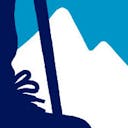
Nepal is one of the most affordable holiday destinations in the world. You can do so much in this little country without burning a hole in your pocket. Conde Nast Traveler has picked Nepal as one of the "21 Cheap Places to Travel in 2023".
With eight of the fourteen highest mountains in Nepal, tourists mainly visit this country for outdoor activities like trekking and mountaineering. This tiny Himalayan country, surprisingly, has good trekking infrastructure in place and is a sheer paradise for trekkers. The friendly and hospitable locals, diverse culture, and breathtaking scenery make Nepal a must-visit destination.
If you are planning a trek to Nepal and are wondering how much budget to set aside for your trek, we have you covered. We have collected the latest information about permits and the tentative costs of food, accommodation, transportation, and logistics that you will need during your trek.

Nepal Trekking Cost
Your Nepal Trekking Cost will depend on whether you will use the services of an international or local agency or go solo, the duration of your trek, the number of people in your group, the type of accommodation you will use, your personal expenses, and the length of your stay in Nepal. Taking this into consideration, you can fix your budget.
It is difficult to get an exact figure; however, an approximate figure would be around USD 900 to USD 1800+ for 7 to 14 days of trekking. It may cost less if you spend frugally on food and drinks. There are also short treks close to the major trails that can cost as little as USD 490.00
New Guidelines for Trekkers: Know Before You Go
Before we delve deep into this topic, let's shed some light on the new directives issued by the Nepal Tourism Board for trekkers in early 2023. As of March 2023, the Nepal Tourism Board has issued a new guideline for trekkers and trekking agencies. As per the new directive, solo or independent trekking has been banned in all the national parks (except in the Sagarmatha National Park or Everest region), wildlife reserves, and conservation areas. Now, foreign trekkers will have to trek with a licensed trekking guide.
Freelance trekking guides are also not allowed to operate
TIMS has been made mandatory on most of the major trekking routes: https://ntb.gov.np/en/plan-your-trip/before-you-come/tims-card
This new guideline has been issued to generate employment for local guides and to improve the safety of the trekkers on the trail. While this rule was supposed to come into effect in April 2023, it has not been strictly implemented yet.
What are the services included in a trekking package sold by a trekking company?
Trekking agencies normally include the following services in the total cost of the package:
- Trekking permits
- Trekking Guide
- Transportation to and from the trailhead
- Accommodations in the city
- Teahouse accommodation and meals (breakfast, lunch, and dinner) during the trek
Some companies also provide gear like sleeping bags, down jackets, trekking poles, crampons, etc. for use during the trek. These items have to be returned to the company after the trek.
International companies include international flight tickets in the package cost .
What are the things not included in a packaged trip?
You will pretty much have to take care of everything that's not included in the cost of your trip. Things you will have to pay for are:
- Hot showers
- Wi-Fi and electricity to charge your gadgets
- Bottled drinking water, drinks, beverages, and any items not included in the three set meals (breakfast, lunch, and dinner) provided by the company
- Gear and equipment
- Tips for guide and porter
- International flights
Travel Insurance
- Any extra costs that may arise due to a change in the itinerary owing to bad weather or any calamity.
Most trekking agencies are flexible and may offer you the choice of buying the whole package or the services of their guides and porters only. In such cases, you will have to pay for only the guide and porter and take care of the rest of the details by yourself (accommodation, food, and transportation). This will no doubt bring down the cost of your trek, but you will have to deal with the hassle of finding accommodation and arranging for your meals by yourself. Searching for a good place to stay and eat can be quite frustrating when you are exhausted after walking for several hours.
How much do the trekking guide and porter charge for their services?
For a trekking guide, the prices range from USD 25 to USD 40+ per day. The harder the trek, the higher the guide's fees. A porter can charge anywhere between USD 20 and USD 30 per day.
Accommodation in Kathmandu and Pokhara
Both cities offer a range of accommodation options: budget-friendly hostels, mid-range or tourist-standard boutique hotels, or premium 4- and 5-star establishments. Most of the hotels have registered their businesses online, and you can make an online booking of your hotel accommodation in advance before arriving in Nepal.
Accommodation on the trail
Do not expect anything fancy, like the hotels in the city. Most teahouses along the trail offer basic amenities: a room partitioned with thin ply boards, a bed with a mattress, blanket, and pillow, and an attached or shared washroom. You will have wifi and electricity, but you will have to pay extra for Wi-Fi and for charging your electronic gadgets. Hot showers are also not included in the room rent and should be paid separately.
Luxury Trekking in Nepal
On well-developed trails like the Everest and Annapurna Regions, one can enjoy luxury treks. Luxury treks offer premium accommodation at luxury mountain lodges and a fine dining experience. Luxury treks may also come with comfortable helicopter charters to and from the trailhead. Depending on the services included and the duration of the trek, a luxury trek in Nepal can cost anywhere between USD 1500 and USD 6,000.
Some of the luxury mountain lodges in the Khumbu Region include the Yeti Mountain Home, Hotel Everest View, Everest Summit Lodge, and Rivendell Lodge.
Yeti Mountain Home has a chain of deluxe lodges in Lukla, Phakding, Monjo, Namche, Debuche, Thame, and Kongde. You will find premium accommodation at the Everest Summit Lodges in Lukla, Monjo, Mende, and Tashinga.
Hotel Everest View is the first luxury mountain lodge in Nepal and is situated in a beautiful Himalayan viewpoint above Namche. The Rivendell Lodge offers a comfortable stay in Deboche.
On the Annapurna trail, luxury lodges run by Yeti Mountain Homes can be found in Landruk, Ghandruk, Birethanti, Majgaon, Tomijong, and Dhampus. Additionally, a few new luxury lodges have opened along the Annapurna Circuit route.
Some of the popular luxury treks include the Luxury Everest Base Camp Heli Trek, the Everest View Heli Tour, and the Annapurna Luxury Trek.
Nepal Trekking Costs: How much budget should you set aside?
Here we have a region-wise rundown of the tentative cost of trekking in Nepal. Please note that the amount quoted below is tentative and likely to change. The permit fees given below were applicable at the time of posting this article (September 2023).
Everest Region
The most popular trek in the Everest or Khumbu Region is the EBC Trek. Most trekkers visiting Nepal choose to do this trek as it takes you to the base of the world's tallest mountain, Mount Everest.
Everest Base Camp Trek can cost anywhere between USD 900 and USD 4,500, depending on the duration of your trek, services included, route, and outfitter with whom you book your package.
This is the only trekking region where independent trekking is still allowed. So, if you don't want to book a package or hire the services of a guide, you are free to trek solo or independently with your group.
While teahouse accommodation costs are reasonable, the price of food spirals the higher you go. This is largely due to the difficulty of transporting food supplies on the mountain trails. Everything needs to be transported by mules, yaks, or porters. So this costs a lot of money for teahouse owners.
In the Everest Region, teahouses usually charge USD 5–10 for a room with a shared bathroom during the low season. The rate goes up as you go higher. In Gorak Shep, shared rooms cost USD 10–15. Rooms with en suite bathrooms cost USD 20 to 40.
During peak seasons, you can expect the prices of shared rooms to go as high as USD 10.
Hot showers cost USD 5 at the lower reaches and USD 7 at the higher reaches.
The price of charging your devices starts at USD 3 and goes up to USD 5. The charge for using Wi-Fi could be anywhere between USD 5 and 7. You can get network coverage on Ncell and NTC SIMs at some of the stops en route.
Food, as already mentioned, can get really expensive. The most filling and inexpensive item on the menu is Dal-Bhaat, which costs around Rs. 600 in the lower reaches and Rs. 1000+ in the higher reaches. Western items like spaghetti, pizza, macaroni and cheese, sizzlers, etc., have very small portions and cost much more.
A cup of tea or coffee costs Rs. 200 to 400, soft drinks Rs. 200 to 500, and a 1 liter bottle of mineral water costs Rs. 100 to 400, and hot water costs around Rs. 100 to 300 per liter.
If you have a limited budget, you can set aside Rs. 1500 to Rs. 2000 per day for meals (breakfast, lunch, and dinner).
The cost of Lukla flights also adds heavily to the cost of the Everest Treks. If you are trekking during peak season, you can expect to pay USD 200+ for a one-way flight ticket.
You can cut down on our transportation costs by choosing the classic route and trekking from Shivalaya or Jiri. This will extend the number of trekking days, but you will save a lot by choosing to skip the Lukla flight.
While the TIMS card was not deemed mandatory for the Everest Treks, a new directive by the Nepal Tourism Board posted in March 2023 has made it mandatory.
Here are the permits needed for a trek in the Everest region:
Sagarmatha National Park Entry Permit:
- SAARC Nationals (per person): Rs. 1500, plus 13% VAT
- Other Foreigners (per person): Rs. 3000 plus 13% VAT
- Nepali (per person): Rs. 100 plus 13% VAT
- Children under ten years old: Free Entry
Khumbu Pasang Lhamu Rural Municipality Entrance Permit
2000 per person for the first four weeks and Rs. 2500 for more than four weeks of trekking.
If you are taking the classic route to Everest Base Camp from Jiri, you will have to pay an additional fee to enter the Gauraishankar Conservation Area. The entry permit costs Rs. 3000 (including VAT) per person.
Annapurna Region
Annapurna Region is the oldest commercial trekking region in Nepal—most of the trekking routes cut through the Annapurna Conservation Area. The trails are well-facilitated, with teahouses at every stop. There are more villages along the trails in this region than in any other region. Walking through the villages of different communities makes for a rich cultural experience.
Annapurna Circuit Trek , Annapurna Base Camp Trek , and Ghorepani-Poon Hill Trek are the most popular treks in this region.
Annapurna Base Camp Trek - If you book a package, you will be charged anywhere between USD 900 and USD 1200. The total costs depend on the outfitter you choose, the services they will provide, and the transportation cost. If you choose to take a flight to and from Kathmandu and Pokhara, your trip cost will be higher.
Annapurna Circuit Trek – The Annapurna Circuit Trek package ranges from USD 1100 to USD 1300+. The package price depends on the itinerary, transportation costs, and the services provided by the agency. There's a rough jeep track leading right up to Manang. If you take a Jeep ride, you can cut down on your trekking duration. However, if you wish to relish the natural beauty of the Annapurna Circuit, you can take the classic route and start your trek from Besisahar.
Ghorepani - Poon Hill Trek – The Ghorepani- Poon Hill Trek is one of the shortest Himalayan treks in Nepal. It is also one of the most affordable Nepal treks. With new roads leading up to Ulleri, it's possible to complete the Ghorepani trek within two days. The cost of this trek ranges from USD 450 to USD 700.
The Annapurna Luxury Trek can cost anywhere between USD 1,500 and USD 2,000. The cost will depend on your itinerary and the package you choose. There aren't many luxury lodges on the trail. The primary luxury lodges in the Annapurna Region are operated by Mountain Lodges of Nepal and are located in Birethanti, Ghandruk, Dhampus, Majgaun, and Landruk. Additionally, there are a few luxury lodges on the Annapurna Circuit, including Tanpopo in Marpha, the Farmhouse Hotel in Upper Pisang, and Ngawal Mountain House in Ngawal. These lodges offer services that are significantly more premium than those of standard teahouses.
Accommodation, food, electricity, and wi-fi
The trekking trails in the Annapurna Region are pretty well-facilitated. You will find villages en route with plenty of teahouses and lodges catering to tourists. So you won't have to worry about spending the night in the wilderness while trekking in the Annapurna Region.
Teahouses charge around Rs 500 to Rs 700 per night for a single room. For a shared room, you will be charged Rs. 300 to Rs. 500 per bed. Expect to pay anywhere between Rs. 1500 and Rs. 2500 daily for food and drinks. You can cut down on the price of the food if you choose the items wisely.
The teahouse charges Rs 100 to Rs 300 extra for using their charging ports. Wi-Fi costs around Rs. 200-300. Hot water per liter costs Rs. 100 to Rs. 200, while RO-filtered drinking water is sold at around Rs. 50 per bottle.
A trekking guide charges USD 30 to 40 each day, while porters charge USD 20 to 30.
- Annapurna Conservation Area Permit
- SAARC National -Rs. 1000 per person
- Other foreigners - Rs. 3000 per person
- Nepali - Rs. 100 per person
- Children under10 years - Free
For treks in the Nar-Phu Valley, you need to get a restricted area permit in addition to an ACAP permit and TIMS.
Restricted Area Permit
- September to November - USD 100 per person for one week and USD 15 per person per day after one week
- December to August – USD 75 per person for one week and USD 15 per person per day after one week
Langtang Region
Langtang Region lies very close to Kathmandu. Trekkers prefer this trek as it allows you to get close to the Himalayan mountains without gaining much altitude. The trails are gradual and filled with breathtaking views of 7000 and 6000-meter peaks, glaciers, and roaring rivers.
The Langtang Valley Trek is the most popular trek in the region—the trek costs between USD 600 to USD 1000. Although teahouses are basic en route, Langtang Village and Kyangjin Gompa have many newly constructed lodges with modern amenities.
If you are trekking independently, you can expect to spend around USD 25 each day on food and accommodation. A trekking guide may charge you around USD 30 or 35 depending on his experience and guiding skills, while a porter may charge USD 20 per day.
If you book your trek with an agency, they will take care of your trekking permit, food, accommodation, transportation, guide, and porter services.
Wi-Fi and electricity - Some teahouses offer free usage of their Wi-Fi hotspot, while others charge extra money. You can expect to pay around USD 4 for using the internet at teahouses.
At the lower elevations, teahouse owners allow free use of their electrical charging ports, while at the higher reaches, you may have to shell out USD 5 to charge your devices.
Nepal Telecom's SIM works fine along this route. While the reception gets sketchy in some places, the SIM works quite well in Langtang Village and Kyangjin Gompa.
Transportation – To reach the trailhead you will have to take a drive. The trailhead of most Langtang treks, Syabrubesi, is situated at a distance of 122 km from Kathmandu.
Due to the mountainous terrain, it takes approximately 7-9 hours to travel the distance by road. You have the option to rent a private jeep (costing USD 100–200) or take a bus ride ( USD 10-12 per person).
- Langtang National Park Entry Permit:
- SAARC Nationals – Rs. 1500 per person
- Other Foreigners – Rs. 3000 per person
- Nepalis – Rs 100 per person
- Children under ten years: Free entry
To participate in the Gosainkunda Trek, you must pay an additional fee for the rural municipality area, which is USD 20 per person. If you plan to trek through Shivapuri National Park, you'll need to buy a park ticket as well.
Shivapuri National Park Entry Fee (per person)
- SAARC Nationals- Rs. 600/-
- Other Foreigners – Rs. 1000/-
- Nepali- Rs. 100/-
- Children under 10 years: Free entry
Manaslu Region
In the Manaslu Region , individual trekking is not permitted, so it's important to book your trek through a trekking agency. The Manaslu Circuit Trek , the most popular trek in the region, costs around USD 950 to USD 2500. The cost is based on your itinerary and the services provided by the agency.
As the Manaslu Region is quite remote, accommodations on the trail are basic. The teahouses offer very basic amenities. Like other remote mountain trails in Nepal, food and drinks along this route are also pricier. Per-day costs for accommodation and food could range from USD 30 to 40.
You won't require a flight to reach the trailhead. Roads have been built till Soti Khola and Arughat, from where the treks to the Manaslu region usually start. You can easily find a bus or a private or shared jeep heading to Machha Khola from Kathmandu.
While a journey on a bus may cost around USD 15 to 20, a drive via a private jeep will be costlier (USD 170 to 250). The cost will be low if you share the ride with other passengers. Expect to pay around USD 50 per person for the shared ride from Kathmandu to Macha Khola.
In the lower elevations, some teahouses offer free internet and charging (electronic gadget) facilities. As you go higher, you will be charged USD 4-5 for using the internet hotspot as well as for charging your devices. The teahouses, which run on solar power, may turn off their power at night. Therefore, don't forget to carry a head torch with you. You will need it for nighttime toilet breaks.
Regarding mobile networks, NTC has better connectivity on this route. Your SIM will work until Samagaon or Samdo. Beyond that, you may have to rely on a satellite phone to connect with the outside world.
Manaslu Conservation Area Entry Permit
- SAARC Nationals- Rs. 1000 per person
- Nepalis – Rs. 100 per person
- Children below 10 years: Free
- September to November – USD 100 per person for one week and USD 15 per person per day after one week
- December to August – USD 75 per person for one week and USD 10 per person per day after one week
For the Manaslu Circuit Trek, you will need to pay the Annapurna Conservation Area Entry Permit, the cost of which you can find above in the Annapurna Region trekking permit section.
For the Tsum Valley Trek , you will be required to pay a special Tsum Valley Area Permit in addition to the other permits.
The cost of the Tsum Valley Area Special Permit:
- September to November – USD 40 per person for 1 week and an additional USD 7 per person each day after 1 week.
- December to August – USD 30 per person for 1 week and an additional USD 7 per person each day after 1 week
Upper Mustang
Trek to Upper Mustang can cost anywhere between USD 1500 and USD 4,000 per person. This includes agency fees, permits, wages of the guide and porter, transportation costs, accommodation, and three meals a day. As independent trekking is not allowed, you will have to book your trek with a licensed trekking agency. Only group trekking (not less than two people) is allowed in the region.
As Upper Mustang lies in a remote mountain region, the internet connection is erratic or nonexistent. People mostly rely on solar power for their energy needs. Carry a good power bank, as you may have to struggle to charge your electronic gadgets.
- Annapurna Conservation Area Permit –
- Other Nationals- Rs. 3000
- Nepalis - Rs. 100 per person
- Children below 10 years old: Free
Upper Mustang Restricted Area Permit
USD 500 per person for ten days and USD 50 per person per day after ten days.
Dolpo Treks Costing
Dolpo, like Upper Mustang, is one of the most remote and rarely visited trekking regions in Nepal. Dolpo, divided into Upper Dolpo and Lower Dolpo, offers an authentic Himalayan trekking experience to trekkers. The trekking route inches close to the Tibetan border and showcases incredible Tibetan Buddhist and Bonpo cultures.
Independent trekking is banned in this region, so you will have to trek with a guide. Local companies sell Lower Dolpa Trekking packages for USD 2500 to USD 3500. The cost of your trek mainly depends on your itinerary and the duration of your trip.
The cost of Upper Dolpo trekking packages ranges from USD 3500 to USD 4500. The cost includes your permit, guide, and porter fees, local transportation, food, and accommodation.
There are very few accommodation options available on this route. At stops where there are no lodges or teahouses, you will have to camp out in the open. The guides and trekking crew will set up tents and prepare food for you.
- Shey Phoksundo National Park Fee
- SAARC Nationals- Rs. 1500 per person
- Other Foreigners- Rs. 3000 per person
- Children below ten years: Free
Upper Dolpo Restricted Area Permit
- USD 500 per person for ten days and USD 50 per person per day after 10 days
Lower Dolpo Restricted Area Permit
- USD 20 per person for 1 week and USD 5 per person per day after one week
Kanchenjunga Region
The trekking trails in the Kanchenjunga Region take you through a pristine and uninhabited area. The trails lie nestled beneath the third-highest mountain in the world, Kanchenjunga. The Kanchenjunga Base Camp Trek is the most popular trek in this region.
Since this is a restricted area, independent trekkers are not allowed. You will have to book your trek with a licensed agency and trek in a group. The agency will take care of your permits, transportation, guide, porter, accommodation, and food.
The Kanchenjunga Base Camp Trek package can cost anywhere between USD 2000 and USD 4000. Accommodation will be at rustic teahouses that serve Nepali as well as Western dishes. Since this is a remote mountain area, internet and mobile phone connectivity remain erratic. This is a great trek if you want to disconnect from the rest of the world and enjoy a digital detox.
- Kanchenjunga Conservation Area Permit
- SAARC nationals – Rs. 500 per person
- Others – Rs. 2000 per person
USD 20 per person per week for the first four weeks and USD 25 per person per week after four weeks.
Makalu Region
A trek in this region will let you experience some of the best Himalayan landscapes in the Nepal Himalayas. The most popular treks in the Makalu Region are the Makalu Base Camp Trek and the Makalu Barun Valley Trek.
Since independent trekking is not allowed along this route, you will have to book your trek with a trekking agency that will arrange the logistics of your trek. Makalu Base Camp Trek packages can cost around USD 1600 to USD 3500+.
The trail traverses isolated places with no sign of human habitation. You can expect to stay overnight at tented camps at stops where there are no teahouses. Internet connectivity is almost zero, and the same goes for the mobile phone network. Teahouses mostly depend on solar power. Solar power has very limited power, and teahouses use the power generated from their solar panels sparingly. Therefore, you may not get an opportunity to charge your devices. If you want to go on a wilderness trek amidst raw nature, then you should choose this region.
- Makalu Barun National Park fee
- Other foreigners: Rs. 3000 per person
Makalu Rural Municipality Area Permit
USD 20 per person per week for four weeks and USD 25 per person per week after four weeks.
Special Note about Nepal Trekking TIMS Card
All foreign trekkers entering Nepal's magnificent landscapes must get a TIMS card. This card is required regardless of your trekking route, along with any other main trekking permits. Trekkers are registered and accounted for with the TIMS card for safety. And TIMS card fees are as follows.
- SAARC Nationals – Rs. 1000
- Other Foreigners – Rs. 2000
Make sure that you have travel insurance before leaving for your trip to Nepal. In addition to the coverage for the mishaps that one can expect while traveling, your insurance should also offer coverage for trekking and hiking activities. If you are doing a high-altitude trek, make sure that your insurance policy covers helicopter rescue and evacuation above an altitude of 5,000 meters.
Keep Enough Cash
Before embarking on your trek, make sure to have enough cash in local currency to last you through the trip. There are hardly any banks or ATM kiosks along the trail, and card payments are not accepted at teahouses. Most of the items you will buy will require payment in cash. If you're going with a guide and porter, remember to save the necessary amount for tipping at the end of the trek.
Frequently Asked Questions - Cost of Trekking in Nepal
Q1. What are the documents needed to obtain trekking permits?
Ans. You need to provide a copy of your passport, passport-sized photographs, and the details of your trek (entry and exit points, itinerary), home address, and contact information.
Q2. From where can I get my trekking permit?
Ans: You can pay for all your trekking permits (National Park/Conservation Area Fee, TIMS, etc.) at the Tourist Service Office at the Nepal Tourism Board's Office in Kathmandu and Pokhara. You can also pay them at the tourist checkpoints on the trail.
The restricted area permits, or special permits, are to be obtained from the Immigration Office in Kathmandu. Only a licensed trekking agency is allowed to obtain a restricted-area trekking permit. The fee for the area's rural municipality can be paid at the offices of the rural municipality, which are usually located at the trailhead.
Q3. What happens to the amount collected from the permit fees?
Ans. The revenue generated from the trekking fees goes towards the development of infrastructure and maintenance of the trails, garbage disposal, and insurance for the local workers. The sum collected is also used for the management and administration costs of check posts along the trail and the printing of tickets and forms.
Q4. Can I get a Nepal Trekking Permit during off-seasons?
Ans. Yes. Regardless of the season, trekking permits are issued at any time of the year. Some of the regions also offer discounted permit fees during the off-season.
Q5. From where do I get the restricted area permit for my trek?
Ans. The restricted area trekking permit is issued by the Department of Immigration, whose headquarters are at Kalikasthn in Kathmandu. Please note that restricted area permits are only issued to licensed trekking agencies and not to individuals. https://www.immigration.gov.np/page/about-trekking-permit
There should be a group of at least two trekkers to obtain a permit. Documents needed for a special permit are:
- Nepal visa and valid passport
- Names of Trekkers
- Trekking itinerary, route
- Entry and exit points
Q6. What are the benefits of buying a trekking package from a company?
Ans. By purchasing a package from a trekking agency, you can avoid the headache of organizing your trek. From accommodation to transportation, everything will be handled by the agency. The teahouse accommodation will be reserved in advance, guaranteeing a bed for you even during the high season. You won't have to worry about getting lost in the mountains, as a guide will be there to assist you. It will also be easier and more comfortable for you to walk on the trail with a porter carrying your heavy luggage. The agency will arrange the permits, which will save you a lot of hassle.
Q7. How much tip should I offer to the guide and porter?
Ans. For each day's trek, consider offering a tip of USD 10-20 to the guide and USD 10-15 to the porter, depending on your satisfaction. You can also tip the driver a similar amount. This is a general guideline; in our experience, there are no set limits on tipping amounts.
Q8. What will happen if I leave the trek halfway? Do I get back a part of the payment from the agency?
Ans. The cost of the trip is non-refundable once you join, even if you leave the trek without completing it. Some agencies offer an alternative activity or trek if the client desires an easier and less challenging hike.
Q9. How much do air evacuation and rescue costs in the mountains?
Ans. The cost of rescue and evacuation in the mountains of Nepal is high due to the use of air ambulances or helicopters for rescue operations. The helicopter companies charge over USD 1000 for a rescue operation in the high mountains. Therefore it's crucial to have travel insurance while trekking in Nepal.
Q 10. What is the difference between a trekking guide and a porter guide?
Ans. A trekking guide is a trained professional who has received training in first aid and wilderness survival and has vast knowledge of the local culture and flora and fauna of the region. His communication and leadership skills are much better than those of a porter.
A porter guide will carry your luggage, which a trekking guide doesn't. He will also show you the way. But that's about all you can expect from a porter-guide. There will be fewer interactions with him as he may lack language skills. He may also not be able to share information about the culture and vegetation that a trained guide can.
Tips to minimize your Nepal Trekking Costs
- Travel in a group. If you travel in a group, you can split the cost of your guide and porter.
- Plan your travel during the shoulder seasons or off-seasons. Peak seasons (spring and autumn) are when things get really expensive and crowded on the trail. Trails are less crowded, and things are less expensive during shoulder seasons (before the start or end of peak season).
- Be frugal and choose basic accommodations.
- Carry your snacks. Be mindful of spending too much money on food and drinks. Due to the high transportation rates, food and drinks are very expensive in the mountains.
- Refrain from buying bottled water. Apart from being pricey, it adds to the trash in the mountains. Get water from a local source and use steripen or filtration tablets to make it drinkable.
- Sweets, chocolates, and carbonated drinks cost more on the trail. So refrain from buying any of those.
- Choose vegetable thali (dal-bhaat) to bring down your daily expenditure. Dal-Bhaat, the staple food of Nepalese, which includes rice, lentil soup, vegetable curry, pickles, and poppadum, is very filling and energy-giving. It costs less than the fancier dishes, and you will get to enjoy unlimited refills.
Himalayan trekking in Nepal can be one of those great travel experiences that you will cherish forever. However, proper planning is needed to make your trek an unforgettable experience. Nepal has innumerable trekking routes for people of all ages and fitness levels.
There is no dearth of trained manpower in the tourism sector in Nepal, and accommodation is readily available on the major routes. From easy short treks to medium and long-duration treks, you can choose any route that is ideal for you. With so many options available, you can plan your travel as per your interests, needs, and budget.
Trekking in Nepal is a once-in-a-lifetime experience. You sure get to experience a slice of heaven without draining your bank account.
- Nepal Trekking Budge
- Daily Guide Rate
- Trekking Package Budget
- Acclimatization & Safety protocols on EBC trek
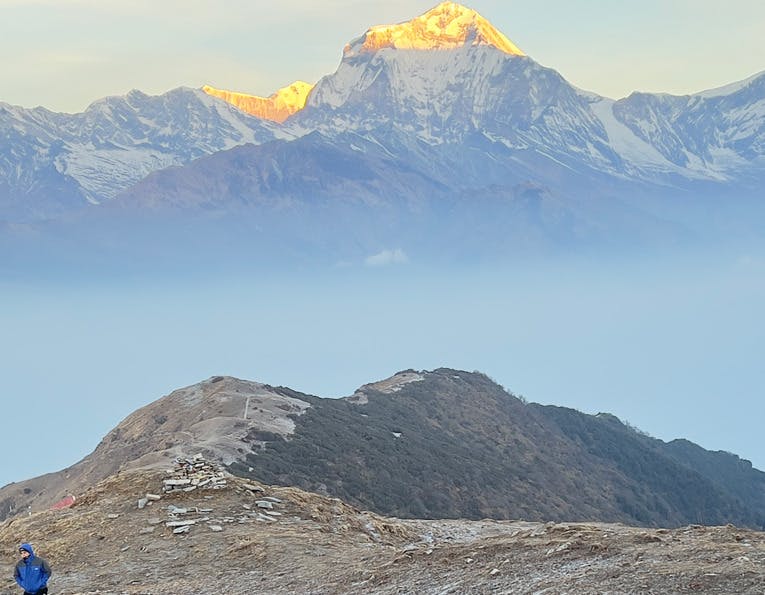
Post a Comment
Subscribe our e-newsletter.
Sign up for Deals and Discount. Get News, Notifications and Updates about the recent Events and Offers.
Trekking In Nepal – A Comprehensive Guide

Some of the links on this page are affiliate links
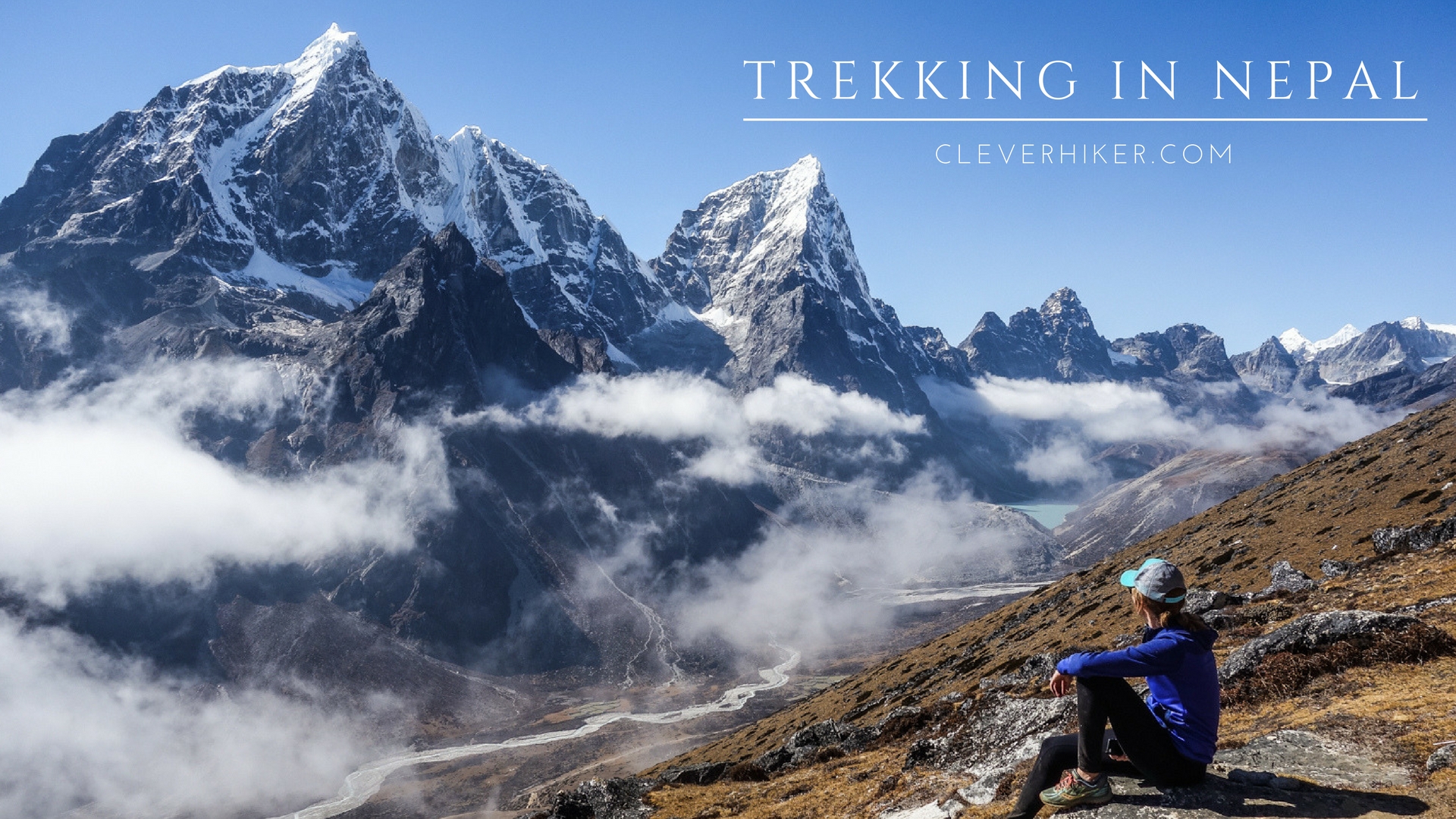
Nepal is one of the most stunningly beautiful countries on the planet. It’s a place where towering white peaks touch the sky, monks peacefully meditate in ancient mountainside monasteries, and lumbering yaks haul goods to quaint villages largely disconnected from the outside world. To put it simply, Nepal is a backpacker’s dream come true.
For all it’s grandeur and immensity, planning a trek in Nepal isn’t as difficult as you might think. Trekking tourism has been popular in Nepal for decades and Nepalis are excellent hosts. Kathmandu has hundreds of quality guiding companies and “teahouse” lodges bring an entirely new level of comfort to the backcountry. Even for those with little backpacking experience, trekking in Nepal is likely to be accessible, affordable, and absolutely unforgettable.
So if you enjoy stunning views, radiant culture, and epic adventure, chances are you’ll fall in love with Nepal. We hope you find this guide useful for planning your next trip.
Check out our Nepal Trekking Gear Checklist to help you with planning your adventure.
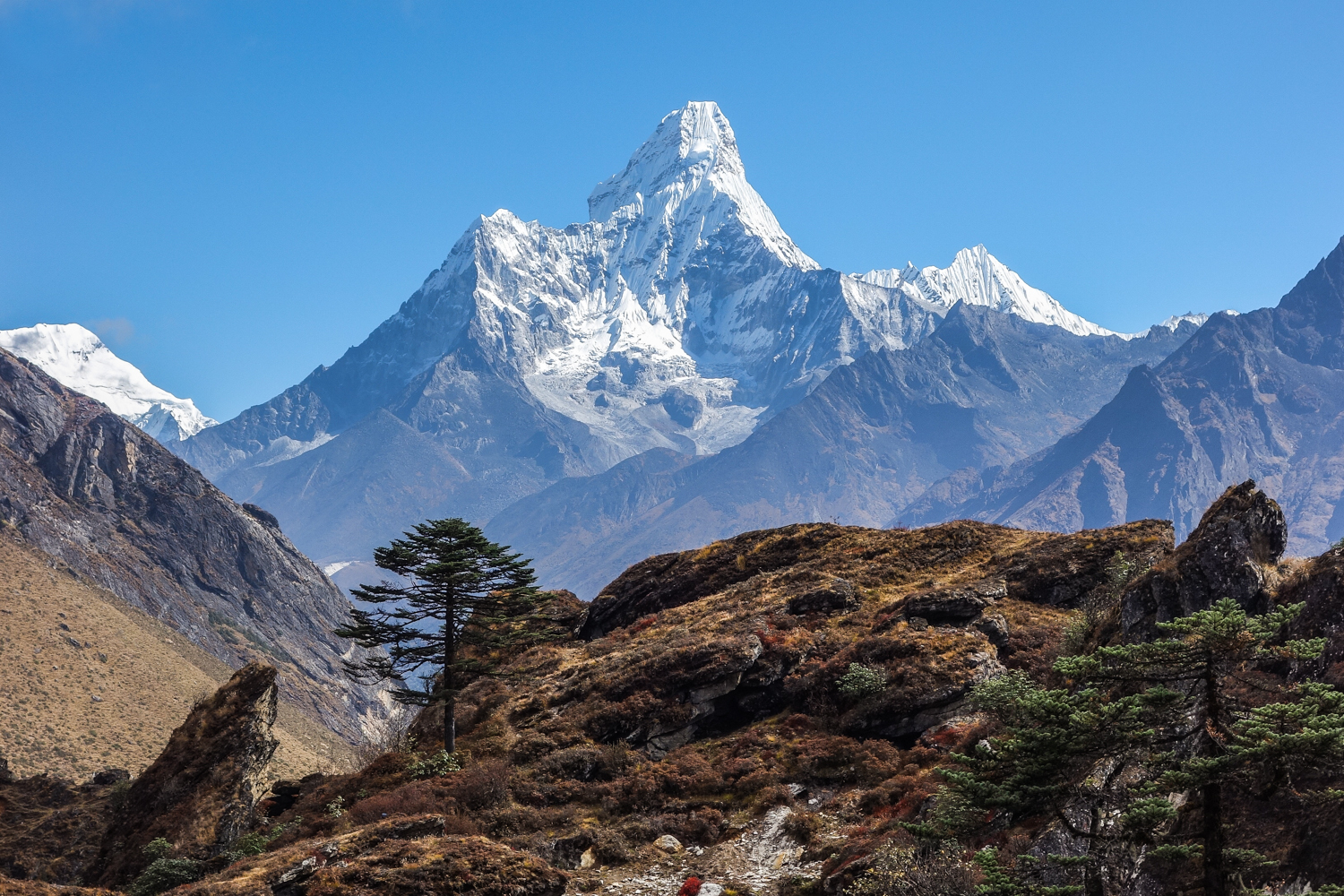
BEST TIME TO TREK
Technically you can hike in Nepal year round, but most trekkers choose between the two peak hiking seasons of fall and spring. If it’s your first time trekking in Nepal, we recommend visiting during one of these peak seasons. The trails will be more crowded, but the benefits tend to be worth it in our opinion.
Fall (October – November) : This is the most popular trekking season in Nepal. During this time you’ll have the best chance for clear mountain views, sunny skies, mild temperatures, and little precipitation. The downside is that you’ll be sharing the trail with throngs of other tourists and teahouses will be bumping, especially along the most popular routes.
Spring (March – April) : Spring is the second most popular time of year to trek in Nepal. As the snowpack melts on high mountain passes, giant rhododendron trees bloom across the hillsides of Nepal. Temperatures are generally mild this time of year and it’s a good time for viewing wildlife too. The two main downsides to spring hiking are busy trails and the possibility of hazy skies, which can obscure mountain views. That said, hazy skies tend to be less of an issue as you climb in elevation.
Off Peak Season : Trekking outside the peak seasons in Nepal can be rewarding as well. Solitude is easier to find, prices are cheaper, and befriending locals is easier too. That said, there are significant downsides to trekking outside the peak seasons in Nepal, so don’t be too cavalier when choosing your travel dates.
Experienced winter travelers ( December – February ) can find sunny days and brilliant mountain views this time of year. That said, temperatures can be bitter cold, daylight hours are shorter, and harsh winter storms can disrupt travel plans with little warning. Also, many popular trails will not be accessible this time of year due to heavy snowfall at high elevations.
Trekking during monsoon months ( May – September ) is not usually advised. Monsoon rains bring landslides and leaches to Nepal. The former makes mountain travel very difficult (if not dangerous) and the latter is just gross and obnoxious. The weather can also be hot and humid this time of year and the mountains are often obscured by clouds.
TEAHOUSE TREKKING
One of the reasons Nepal is such an amazing place to hike is the teahouse trekking culture. “Teahouses” are essentially small mountain lodges frequently spaced along popular trails. On most trails in the Everest, Annapurna, Manaslu, and Langtang regions you’ll pass a teahouse every hour or two. They’re a great place to meet other travelers, eat a home-cooked meal, warm your toes by the fire, and bed down for the night.
On a teahouse trek you’ll sleep in one of these lodges every night and you’ll eat almost all of your meals in teahouses too. Accommodations are usually simple, comfortable, and very affordable. It’s expected that you’ll eat your meals wherever you stay, which is one of the reasons rooms are so cheap. Teahouses also sell snacks, candy, hot showers, beer, and sometimes even halfway decent wifi.
Most teahouses cost around $3-5 per night and can be booked upon arrival. The usual setup is a small room with two twin beds and a shared bathroom down the hall. Some teahouses have rooms with attached bathrooms, but you’ll likely pay a premium for the upgrade. Blankets may be provided, but we recommend hiking with a sleeping bag for warmth, comfort, and cleanliness (learn more: Nepal Equipment Guide ).
For those looking to hike in Nepal’s more remote areas, camping treks can be arranged through most trekking agencies in Kathmandu. This option will add cost and complexity, but could lead to a unique and rewarding trek. That said, camping treks aren’t nearly as popular as teahouse treks and camping won’t be necessary on any teahouse trekking route.
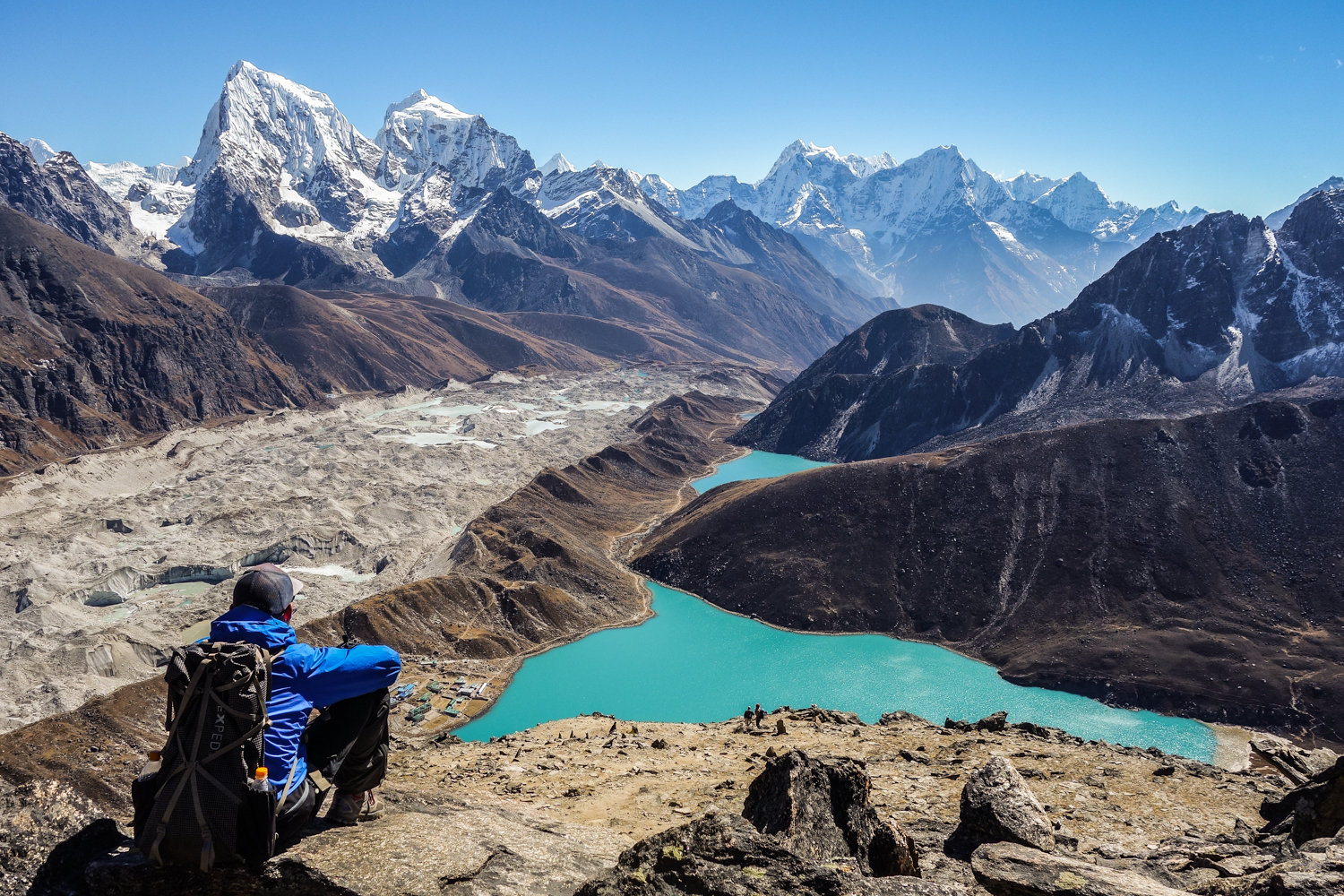
POPULAR TEAHOUSE TREKS
It would be impossible to list all the fantastic and unique trails in Nepal. So instead, we wanted to highlight a few of our favorites and some popular recommendations. These teahouse trekking routes are all exceptional hikes, and they’re a great place to start.
Everest Base Camp
Difficulty: Moderate to Difficult
Best Time: March-April & October-November
This is the most popular trekking route in Nepal, and with good reason. Walk in the footsteps of the world’s most famous climbers and gain a spectacular view of Everest from the peak of nearby Kala Patthar.
Annapurna Circuit
An extremely popular and stunning trek with lots of variety. This route combines spectacular mountain scenery with Tibetan-influenced culture and culminates at one of the highest trekking passes in the world, the Thorong La.
Annapurna Base Camp
Difficulty: Moderate
A fantastic trek for those with limited time still wanting to experience a stunning Himalayan amphitheater of mountains. This is also a lower elevation hike, which may make it better for those worried about altitude or hiking off-peak season.
Everest Three Passes Loop
Difficulty: Difficult
For those with the time and physical ability, this is one of the most spectacular trekking routes on the planet. Hit the highlights of the Everest Base Camp route and the stunning Gokyo Lakes on this epic and increasingly popular loop.
Langtang Valley
Once among the most popular trekking routes in Nepal, this area was hit hard by the 2015 earthquake, but it’s on the rebound. Trekkers looking to avoid crowds on a hike filled with Tibetan culture, natural diversity, and fantastic Himalayan scenery should definitely take a closer look.
Manaslu Circuit
This trek features spectacular mountain scenery coupled with a rich and authentic Tibetan culture. Though Manaslu is gaining in popularity, it still sees a fraction of the travelers drawn to the Everest and Annapurna treks. Also, if you have the time, a side trip up the Tsum Valley should not be missed.
Gokyo Lakes
This is a great trek for those looking to avoid the crowds of hikers headed to Everest Base Camp but still seeking majestic Everest scenery. The views from atop Gokyo Ri may be the finest in all the Himalayas.
Upper Mustang
Best Time: May-October
This heavily Tibetan-influenced district oozes with culture and panoramic Himalaya views. The uniquely arid mountain landscape of this region makes it a good choice when other areas are soaked in monsoon rains. This is a restricted area though and permits are pricy.
Difficulty: Easy to Moderate
This lower altitude trek is a popular option among hikers looking for a shorter taste of Nepal’s trekking culture. The route isn’t nearly as remote as many treks, but the views from Poon Hill are still stunning.

DIFFICULTY RATING
Trekking difficulty will depend on a multitude of factors including your experience, physical fitness, pack weight, and weather conditions. There are many different types of treks to choose from in Nepal with varying degrees of difficulty. Make sure to choose a trek that fits your fitness level and train adequately before your hike.
Trekking trips in Nepal are not technical (no ropes, ice axes, or crampons), but there will still be big ups and downs. There are sure to be long days and sore legs, but treks in Nepal are paced to give a lot of time for rest and acclimatization, so don’t fret. It certainly won’t be easy, but most active hikers fair very well on Nepal’s trails, especially with some training beforehand.
Porters are another consideration for reducing the difficulty of your trek. A porter can be hired to carry heavy gear, so all you have to tote is a small daypack. This option greatly increases accessibility along Nepal’s trails. We were surprised and impressed by the amount of people in their 50’s, 60’s and even 70’s who we met on the trail.
INDEPENDENT OR GUIDED TREKKING
Update: Effective April 1, 2023, new requirements require solo or foreign independent trekkers to use a local guide or porter while trekking in Nepal’s national parks and protected areas.
This is an important question for many trekkers and the choice will likely come down to experience and personal preference. If you’re a highly experienced backpacker traveling along a popular route (Annapurna Circuit, Everest Base Camp, etc.), it’s likely that you’ll get by just fine without a guide. That said, Nepali guides bring more to the table than just logistics management. A good guide can help you learn about local culture and may even become a close friend.
For many popular trekking routes in the Annapurna and Everest regions you won’t be required to hire a guide. These trails are mostly well marked and have lots of travelers. This leaves the door open for experienced trekkers to hike independently, which is a nice benefit for those with the skills and know-how. If you’re unsure of your preparedness or nervous about high altitude safety, we recommend hiring a guide. Also, for trekking trips to any restricted area, you will be required to hire a guide.
If you plan to hike independently, make sure you have a good map, the proper permits, and a good guidebook before you leave Kathmandu (see map & guidebook section below). Also, expect to put in a good amount of planning time to fully prepare for your hike.
Guided Trekking Pros
All pre-trip details handled (permits, fees, etc.)
All transportation arranged (bus, plane, jeep, etc.)
Little worry about any details while hiking (lodging, route, schedule, etc.)
Guidance & safety while trekking at high altitude
Local information on religion, culture, food, etc.
Independent Trekking Pros
Can be much less expensive
Hike on your own schedule
More direct interaction with locals
More choice on where to stay & eat (though guides usually know the best spots)
No group dynamics to deal with, just you and the trail.

GUIDES AND PORTERS
Guides and porters are very common in Nepal (though not always mandatory) and prices are quite competitive. In general a guide will cost around $25-30 per day and a porter will cost around $10-15 per day. A guide will help with logistics, information, and safety on your trek. A porter will carry heavy gear, so you only have to hike with a small daypack.
If you choose to trek with a guide, make sure they speak fluent English because they’ll be the point person on your hike. They’ll manage transportation, lodging, food, hiking schedule, routes, and safety on the trail. Your guide will also be a good source of information on local culture, customs, festivals, and norms. A good guide can be an extremely useful resource on the trail and they may even become a lifelong friend.
Porters are also useful and very common along trails in Nepal. Porters have the job of carrying heavy gear, so you don’t have to. This is especially beneficial for older trekkers, novice trekkers, or groups with children. Just remember, even if you do decide to trek with a porter, it’s still very important to keep your gear weight to a minimum. Porters have an absolutely backbreaking job, so please don’t make it any harder on them.
Also, make sure to tip your guide and porters well. A good tip is about 15% of the total you paid for their services. Hand the money directly to each person to ensure they get the full payment. Guides and porters have very tough jobs and they often get surprisingly little compensation for their work.
Guide Recommendation
Looking for a guide on your trip to Nepal? I highly recommend reaching out to our friend Ganesh in Kathmandu. Ganesh is truly an exceptional guide and you’ll love trekking with him if he’s not booked up. He’s knowledgeable, friendly, funny, and highly experienced. Here’s his contact info: [email protected] , Ace Vision Treks & Tours or ACE Vision Nepal , and Ganesh on Facebook . Just tell him Dave & Annie sent you.
TREKKING COMPANIES
There are literally hundreds of trekking companies in Kathmandu and many of them are very good. With a little online research (try tripadvisor ) you should be able to find a bunch of highly qualified companies to help you plan a trek. Most companies plan treks advance, but you can also fly into Kathmandu and plan a trek in person surprisingly easily. Planning things in person will require more flexibility, but you’ll likely save a good chunk of change and have the chance to interview guides before your trip.
Trekking Company Recommendation
During our most recent three months in nepal, we worked with Ram at Outdoor Himalayan Treks . Ram was absolutely fantastic and we’d highly recommend contacting him if you have any questions. He gave us tons of useful information and helped us plan transportation, accommodation, and trekking permits on a few of our hikes. Here’s Ram’s contact info: [email protected] or Ram on Facebook . Just tell him Dave & Annie sent you.

GROUP OR SOLO TREKKING
Some trekking companies offer group packages for popular trails. This can be a good way for solo travelers and couples to link up with other hikers and save a little money in the process. There are downsides to traveling in a large group as well, so make sure you know what you’re getting into before you sign up. Many trekkers (us included) prefer hiking in small groups or with a personal guide. That type of travel will give you more flexibility and less compromise as you trek.
TEAHOUSE TREKKING GEAR
Need to know what to bring? Visit our Nepal Gear Guide & Checklist for personal recommendations on the best trekking equipment. You can also check out the CleverHiker Gear Guide for all our favorite non-Nepal equipment (tents, stoves, sleeping pads, etc.).
NEPAL GEAR GUIDE & CHECKLIST
CLEVERHIKER GEAR GUIDE
GUIDEBOOKS & MAPS
For general trip planning and research, we highly recommend picking up the Trekking in the Nepal Himalaya book. This book covers all the popular trails and some less popular routes too. It has extremely helpful information about trekking, accommodation, food, and general Nepal travel advice. We used this book nearly every day on the trail (we took pictures of pages with our phones to save weight) and found it very useful.
Once you decide on a trek, it should be easy to find specific maps and guidebooks when you reach Kathmandu. Just walk around Thamel (the main tourist hub in Kathmandu) and you’ll find lots of bookstores catering to trekkers with the most updated resources.
Make sure at least one member of your group is carrying a detailed map of your trek. You may not need it much for navigation (most popular routes are well marked), but it will still be useful. Also, a good guidebook with detailed trail descriptions can be helpful as well. It’s nice to know what challenges lie ahead and get excited for upcoming highlights.

TREKKING SAFETY
When hiking in Nepal, you’ll be heading into remote areas far from reliable hospitals. That’s why it’s important to take every precaution before you set out. Below you’ll find some of our safety tips for trekking in Nepal. Also, check out our emergency first aid skills tutorial video to brush up on your wilderness safety knowledge.
Educate yourself on Acute Mountain Sickness (more info below). Take the prescribed acclimatization days on high-altitude treks, stay hydrated, and listen to your body.
Helicopter evacuations are not uncommon in Nepal, and many of them are preventable. Evacuations like these can be incredibly pricy, so we recommend picking up trekking travel insurance before you trip.
Don’t trek alone. If you’re traveling solo consider hiring a guide or making friends to hike with.
Always pay close attention to weather conditions, especially on long pass days. Storms can develop quickly in the mountains and can be fatal if you’re unprepared.
Always hike with a lightweight first aid kit and the 10 backpacking essentials .
Leave a detailed itinerary with an emergency contact and write important phone numbers on a piece of paper that will be easy to find in an emergency.
When encountering yak or donkey caravans, move to the inside (away from any cliff) and let them pass. These animals can sometimes be clumsy and may bump into you.
Crime is not common in Nepal, but it’s not unheard of either. Keep a close eye on your belongings, especially your backpack filled with valuables.
Always carry enough water on the trail and stay hydrated. Also, bring a water purifier (more info below) to make sure your drinking water is clean.
Keep your eyes on the trail to avoid any missteps that could end your trek.
Be very careful around landslide and avalanche areas. Consult a guide or locals if a crossing looks difficult and don’t take unnecessary risks. Turning around is always an option.
HIGH ALTITUDE SAFETY
If you’re trekking in Nepal, there’s a good chance you’ll be hitting some high elevations, so it’s important to know the basics of high altitude hiking. Acute Mountain Sickness (AMS) is no joke, and if you make reckless decisions or ignore symptoms, it could even kill you. Most hikers take the time to acclimatize properly and experience limited AMS symptoms if any, so there’s no need to freak out. But you do want to understand AMS and take it seriously. Check out our high altitude safety tutorial video for more info.
TRAVEL INSURANCE
We highly recommend purchasing travel insurance if you plan to trek in Nepal. In fact, we wouldn’t trek in Nepal without it. Most trekking locations in Nepal are very remote, so if something goes wrong, you’re likely to need an emergency evacuation, and that can get insanely expensive.
When choosing travel insurance, make sure to buy a plan that will cover high altitude trekking and helicopter evacuations in Nepal. We did a bunch of research and ended up choosing World Nomads . Their rates were reasonable, their coverage was excellent, and communicating with them was easy. We fortunately didn’t need to use our travel insurance, but the peace of mind alone was well worth it.

POST EARTHQUAKE CONDITIONS
Nepal was hit by a massive earthquake in April of 2015 . Thousands died in the disaster and widespread damage affected many temples, buildings, roads, and some trekking infrastructure.
We spent 3 months trekking around Nepal in the fall of 2016 and had very few inconveniences due to the earthquake. Some signs of the devastation remain, but most trails have been fully repaired. Accommodations were safe and plentiful, especially along popular routes.
Teahouse food options are generally simple but sufficient. Menus are roughly the same at most teahouses (see example menu below) with the ubiquitous dhal bhat as a hearty and delicious staple. You will also commonly find momos (dumplings), pasta, rice dishes, soups, pizzas, and in some places yak steak and apple pie. A home-cooked warm meal will always be a nice treat at the end of a long day on the trail.
Although teahouse menus are always similar, you’ll notice that prices increase as you move farther away from cities. Most supplies must be carried by yak or donkey to remote locations, which explains the increase in cost. It’s also always a good idea to carry snacks when trekking between villages and on long pass days.
*Note: If you plan to book a trip through a trekking agency, make sure to talk about food costs ahead of time. Most companies will give you two options: 1) you pay an up-front fee that will cover all food costs on your trip or 2) you bring money and pay for meals as you go. The first option is easier because you won’t have to hike with lots of cash and handle money throughout the day. The second option can be much cheaper though, because you’ll only pay for exactly what you order.
Below is an example of a typical teahouse menu. Prices are displayed in Nepalese Rupees (about 100 = 1 USD). For reference, this was one of the most expensive teahouses we visited.

It’s important to have a water treatment plan before you trek in Nepal. Water is usually easily accessible, but you’ll want to purify it first for safety. Water treatment pills, UV sterilizers, and water filters are all popular options. You can also purchase bottled water from teahouses, but that’s an eco-unfriendly strategy that will greatly increase cost and waste on your trip. We used a SteriPEN Ultra on our last Nepal trip and we highly recommend it. It was fast, easy to use, and we didn’t have to ingest any funky tasting chemicals.
While hiking, we recommend carrying at least 1-2 liters of water and filling up often. Staying hydrated is essential while trekking and it becomes increasingly important as you hike higher in elevation. Also, it’s easy to forget about drinking water when it’s chilly outside, but it’s imperative to stay hydrated. Ordering pots of hot tea can be a great way to ensure you’re getting enough fluids on cold days.
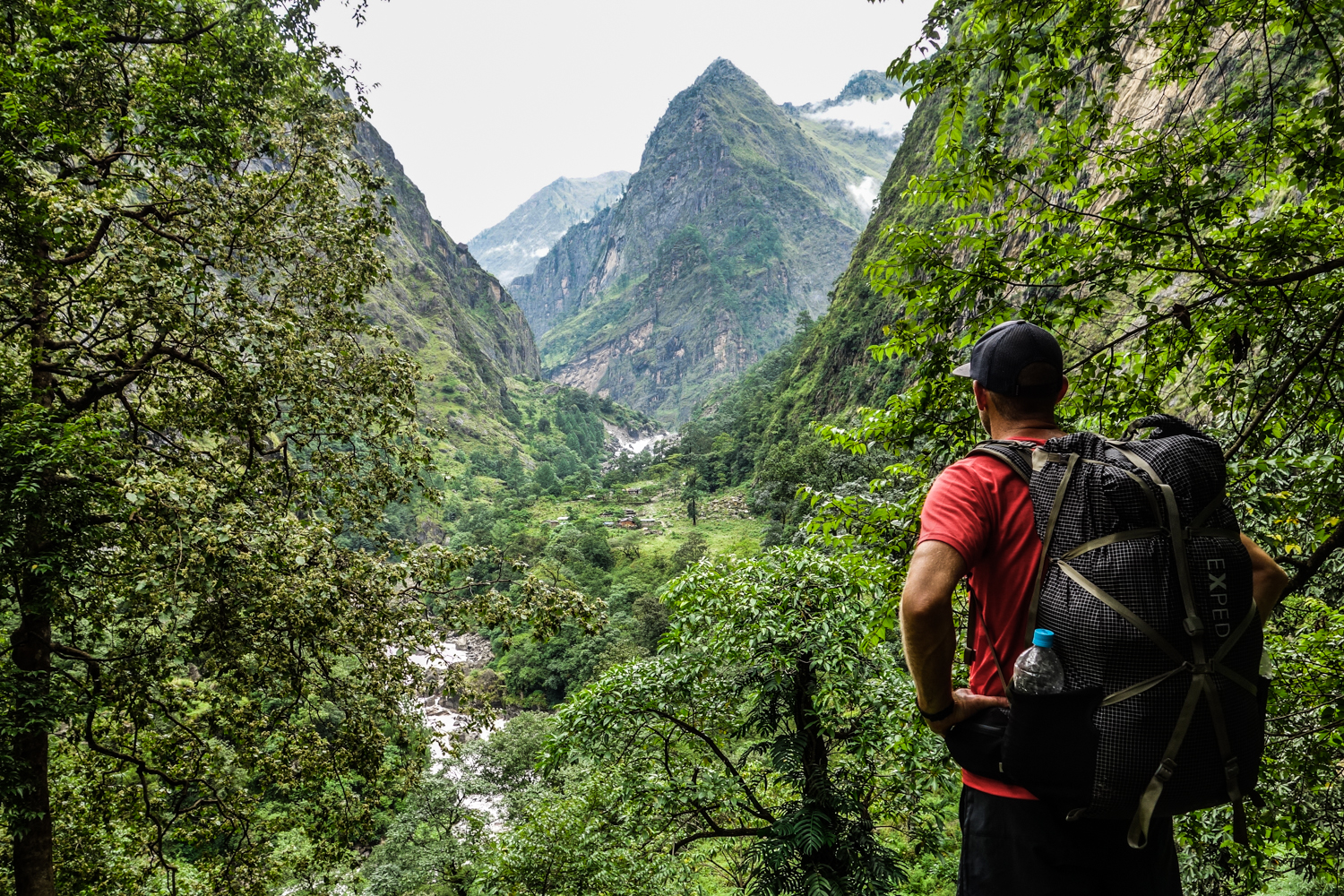
Trail towns don’t have ATM machines and teahouses rarely accept credit cards, so you’ll want to make sure you bring plenty of cash for your trek. In the fall of 2016, we budgeted around $30 per person per day for food and accommodation on our treks. In the Annapurna and Manaslu regions that budget covered our daily expenses and then some. We often had extra funds for treats like hot showers, beer, and baked goods. In the Everest region our $30 per day didn’t go quite as far, but we were still able to buy the occasional treat.
In general, it’s always smart to carry more cash on the trail than you might think. Luxury items like chocolate, tea, beer, wifi, and hot showers are all great morale boosters, but the costs add up. You may also want to buy small gifts, replace broken equipment, or hire transportation if your travel plans fall through.
It’s also important to consider the costs of charging your electronic devices. Some teahouses will let you charge batteries for free, but most collect a fee. Usually you’ll be able to get a full battery charge for $2-5, but in remote areas it can cost more.
Most teahouses offer hot showers for a fee, usually around $3-5 per shower. Showers will range in quality from a bucket of hot water to the rare proper shower. We found it often wasn’t worth the cost for a mediocre shower, so we recommend bringing wet wipes for quick cleaning.
*Note: Namche Bazaar in the Everest region does actually have an ATM machine, but it can be inconsistent, so we wouldn’t recommend counting on it.
TRANSPORTATION
Most visitors fly into the Tribhuvan International Airport (KTM) in Kathmandu, the capital city of Nepal. Kathmandu is a great base for sightseeing, planning a trek, or any last minute hiking preparations.
In general, transportation around Nepal is very slow going. Long bus rides, cancelled flights, and unexpected delays are sadly part of the norm. So make sure to give yourself a couple buffer days when planning your trip and embrace the adventure.
Most popular treks depart directly from Kathmandu or Pokhara, the second largest city in Nepal. Some treks are accessible via flight, but many require a long bus or jeep ride to the starting point. Depending on your destination, there will usually be a couple different options to get there. Local transportation tends to be cheaper, but “tourist” options will often be far more comfortable.
If you organize a trip through a trekking company, they will take care of the logistics for you. If you choose to trek independently, you’ll need to get the proper permits and pay any park/conservation fees before your trek.
Every trekker in Nepal needs a TIMS card ( Trekking Information Management System ), which costs around $20. You can get your TIMS card and pay your park fees at the Nepal Tourism Board offices in Kathmandu or Pokhara before your trek.
It’s also likely that you’ll need to pay conservation or national park fees. These can be obtained ahead of time and commonly cost around $20-$30, depending on where you’ll be hiking. You may be able to pay some park fees on the trail, but we found it much easier to take care of everything ahead of time.
UPDATE- JANUARY 13, 2018 – There have been some changes to the TIMS requirements for the Khumbu (Everest) region. It is no longer necessary to obtain a TIMS Card for this area. Instead, they are collecting a Khumbu pass, which costs NRS 2000 or USD 20 per person. It is uncertain how long this change will stay in place as many people in the travel agencies are unhappy with the system. We always recommend checking the most current requirements before beginning your trek.
PERMITS – RESTRICTED AREAS
There are several restricted areas in Nepal that require special trekking permits. If you’re heading to one of these areas you’ll need to obtain permits through a registered trekking agency and travel with a guide. As of March 2017, the following areas require restricted-area permits: Manaslu, Nar-Phu, Tsum Valley, Upper Mustang, Dolpo, Kanchenjunga, and Humla.
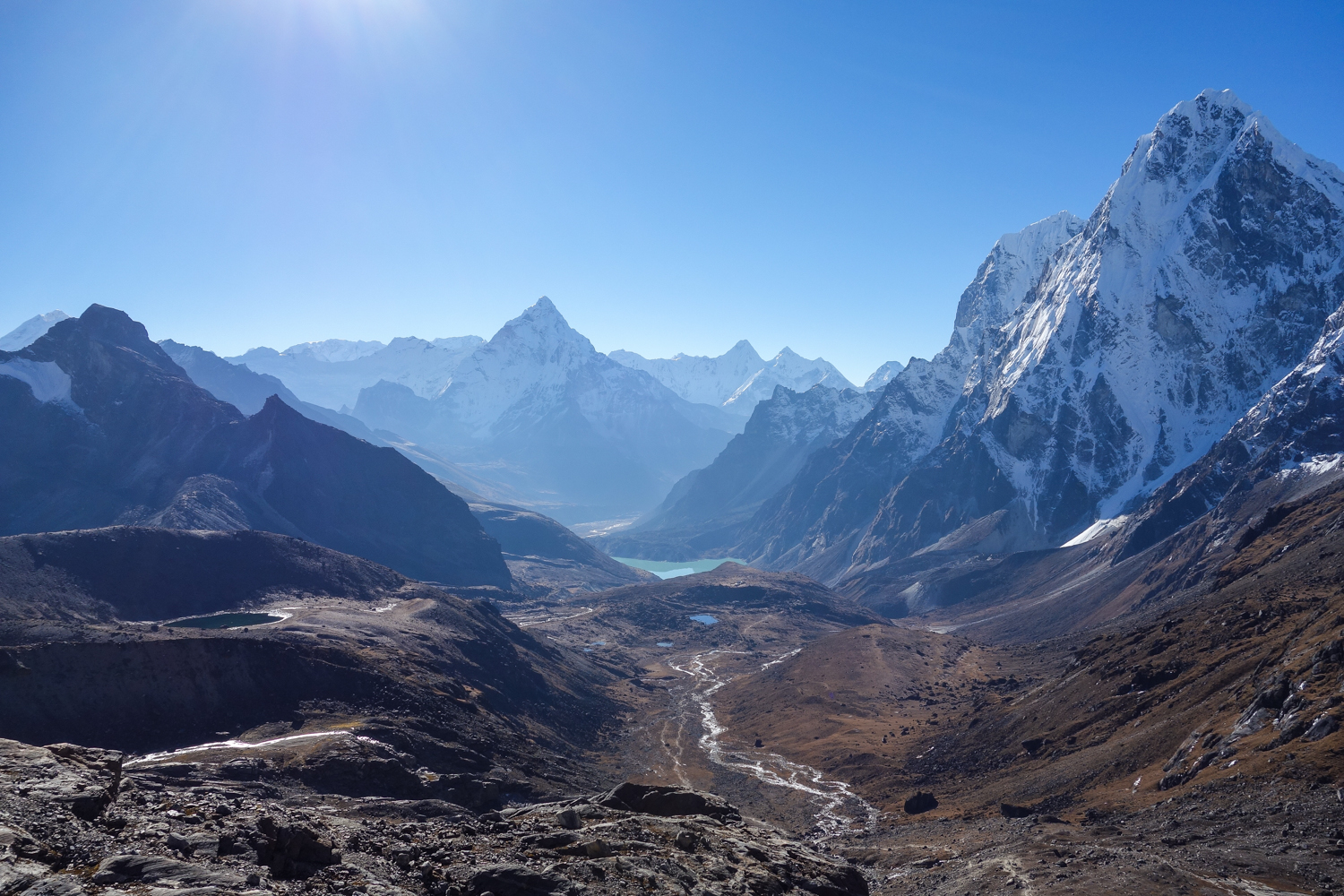
PHONES AND WI-FI
For better or worse, it’s becoming increasingly easy to stay connected while trekking in Nepal. Along the most popular routes, some teahouses sell wifi and you may even get a phone signal using a local SIM card. Don’t count on staying connected though, because service is often unreliable at best.
If you buy a local SIM card in Kathmandu, there are two main companies to choose from: Ncell and Nepal Telecom. As of fall 2016, there was minimal (if any) coverage in remote regions, such as Manaslu, Tsum Valley or Dolpo. In the Annapurna region, Nepal Telecom SIM cards seem to work okay, while in the Everest region, NCell was a better bet. We were far from impressed by phone connectivity on the trail, but we expect coverage will get better in the coming years.
Wifi may be available at some teahouses along your trek as well, though speed and functionality will be highly variable. In the Everest region they sell pre-paid wifi cards (around $3 for 100mb) that work well but get used up quickly. In contrast, on the Annapurna Circuit you may pay a one time fee of $3-5 for wi-fi access, but connections can be very slow (if working at all).
VISA INFORMATION
In order to enter Nepal you will need to obtain a tourist visa. Most people get a visa on arrival at the Tribhuvan International Airport in Kathmandu. You can also do this ahead of time at a Nepal Embassy if you are traveling overland from India.
As of March 2017, US travelers had three tourist visa options. You could choose a 15 day visa ($25), a 30 day visa ($40), or a 90 day visa ($100). There are electronic visa machines at the international airport and staff to assist with forms. We applied for a 90 day visa on arrival and found the process to be surprisingly quick and efficient.
Please check current visa guidelines for specific information as these policies can change and this website is not an official source of information on Nepal visas.
RESPONSIBLE TREKKING & CULTURAL CONSIDERATIONS
The number one rule of backpacking conservation is Leave No Trace . Learn it and live it.
Don’t buy bottled water in teahouses. The extra cost and waste are not worth it. Instead, use treatment pills, a water filter, or a UV sterilizer. We used the SteriPEN Ultra and loved it.
Don’t litter. Pack out your trash and keep Nepal beautiful for generations to come. If you really want to be a superstar, pack out trash that you find along the trail.
Deforestation is a real problem in Nepal. Avoid using firewood and stay in lodges that use eco-friendly fuel.
Dress conservatively, especially when sightseeing in towns. For women, this sadly means no shorts or shirts that show shoulders.
Public displays of affection are frowned upon in Nepal, so save it for private time.
Walk to the left of religious monuments such as mani walls, chortens, and prayer wheels. If you spin a prayer wheel, always spin it clockwise.
Follow the rules when visiting temples. Shoes off, no exposed shoulders, cover your legs, and don’t take pictures inside. Also, don’t enter Hindu temples wearing leather products.
Always ask permission before taking a photo of a person. Most people won’t mind, but if they decline, respect their wishes.

MORE RESOURCES
Hopefully you found this guide helpful for planning your trip to Nepal. We have truly fallen in love with Nepal and we know you will too. For more helpful resources check out the following links:
Nepal Gear Guide & Checklist
Best Backpacking Gear – CleverHiker Gear Guide
CleverHiker Top Gear Awards
Essential Trail Skills Video Series
L ightweight Gear Basics Video Series
And as always, please feel free to leave a comment below if you have any recommendations, questions, or suggestions. Take care and happy hiking!
Disclosure: Some of the links on this page are affiliate links, which means we may receive a small commission if purchases are made through those links. This adds no cost to our readers and helps us keep our site up and running. Our reputation is our most important asset, which is why we only provide completely honest and unbiased recommendations.
Find your adventure. The mountains are calling.
Discover A New Adventure
- Duration 0 - 10 10 - 20 20 - 30 30 - 40
- Trip Difficulty Easy Moderate Moderate to Strenuous Strenuous Very Strenuous
- Group 1 - 20 1 to 20 1 to 5 1-10 2 to 20 2-20 2+
- Altitude 0 - 500 500 - 1000 1000 - 1500 1500 - 2000 2000 - 2500 2500 - 3000 3000 - 3500 3500 - 4000 4000 - 4500 4500 - 5000 5000 - 5500 5500 - 6000 6000 - 6500 6500 - 7000 7000 - 7500

- Everest Region
- Annapurna Region
- Langtang Region
- Manaslu Region
- Other Treks
- 10 Days Himalyan Buddhist Pilgrimage Tour Nepal
- 13 Days Nepal Buddhist HimalayanTour
- 14 Days Nepal Bhutan and Tibet Tour
- 11 Days Nepal and Tibet Tour
- 9 Days Nepal and Bhutan Tour Package
- 11 Days Delights of Bhutan tour
- 5 Days Bhutan Highlights tour
- 5 Days Bhutan Cultural Tour
- 7 Days Taste of Bhutan tour
- 4 Days Tibet Lhasa Tour
- 14 Days Manasarovar and Mt. Kailash tour
- 8 days Lhasa EBC Tour and Trek
- 1 Day Kathmandu world heritage sites tour
- 6 Days Kathmandu Pokhara Tour
- 5 Days Kathmandu Nagarkot Dhulikhel
- 10 Days Highlight Nepal Tour
- 28 Days Himlung Expedition
- 36 Days Ama Dablam Expedition
- 22 Days Naya Kanga Peak Climbing
- 19 Days Tharpu Chuli Climbing
- 16 Days Lobuche East Peak Climbing
- 14 Days Chulu East Peak Climbing
- 16 Days Yala Peak Climbing
- 15 Days Pisang Peak Climbing
- 14 Days Island Peak Climbing
- 18 Days Chulu west Peak Climbing
- 14 Days Mera Peak Climbing
- 14 Days Everest Base Camp Trek
- 16 Days Everest Base Camp Trek By Road
- 20 Days Everest Classic via Jiri Trek
- 18 Days Everest Base Camp With Gokyo Trek
- 13 Days Gokyo Lakes Trek
- 12 Days Scenic Pike Hill Trek
- 1 Days Everest Base Camp Helicopter Tour
- 11 Days Everest Base Camp Heli Trek
- 20 Days Everest Three Passes Trek
- 9 Days Everest panorama Trek
- 14 Days Everest Base Camp Luxury
- 12 Days Ama Dablam Base Camp Trek
- 13 Days Annapurna Circuit Trek
- 10 Days Annapurna Basecamp Express Trek
- 12 Days Annapurna Base Camp Trek
- 8 Days Annapurna Panorama View Trek
- 11 Days Khopra Danda Trek
- 10 Days Mardi Himal Trek
- 11 Days Mohare Danda Trek
- 14 Days Annapurna Sanctuary Trek
- 8 Days Jomsom Muktinath Trek
- 21 Days Nar Phu Valley Trek
- 10 Days Langtang Valley Trek
- 11 Days Langtang Gosaikunda Trek
- 10 Days Tamang Heritage Trek
- 15 Days Tamang Heritage and Langtang Valley Trek
- 8 Days Helambu Trek
- 13 Days Ganja La Pass Trek
- 22 Days Manaslu Trek with Tsum Valley
- 20 Days Tsum Valley Trek
- 34 Days Manaslu Circuit Nar-Phu Trek
- 16 days Manaslu Circuit Trekking
- 17 days Upper Mustang Trekking
- 5 Days Nagarkot Chisapani Trek
- 18 Days Lower Dolpo Trek
- 24 days Kanchenjunga Trek
- 26 Days Upper Dolpo Trek
- Why Book with Us
- Legal Documents
- Our Friends
- Terms and Conditions

Trekking In Nepal Cost: For 2024 and 2025
Trekking in Nepal costs vary due to various factors, including your trekking destination, the service you choose, the itinerary you choose, and many more. Nepal offers an affordable and thrilling trekking experience, making it a popular destination for trekkers seeking an unforgettable trekking experience. Nepal offers various routes and cheap local food options for different budget levels.
There are many different types of trekking to choose from which are suitable while trekking for beginners and experienced trekkers. For beginners, the Tamang Heritage trek offers easy and short trails, while the Everest Base Camp trek and Manaslu Circuit offer high-altitude and strenuous routes. Nepal’s unique blend of affordability and adventure makes it a top choice for those seeking an unforgettable adventure. Whether exploring the Annapurna Range, the Everest Base Camp, or lesser-traveled trails, Nepal offers unforgettable memories at an affordable cost.
Trekking in Nepal cost can vary depending on the season, with peak seasons like autumn and spring being more popular due to clear skies, comfortable temperatures, and mountain views. Off-seasons like the monsoon and winter can be more budget-friendly, with reduced accommodation prices and fewer tourists. Other factors influencing trekking costs include the choice of route, duration, and comfort level. Special permits, hiring guides or porters, and investing in quality gear are also important. Regardless of budget, Nepal’s breathtaking landscapes and warm hospitality make trekking a memorable and enriching experience.
Here are some of the factors that can affect the trekking cost in Nepal:
- Seasonal Variations
- Choice of Trekking Route
- Duration of the Trek
- Guide and Porter Services
- Equipment and Gear
- Accommodation Options
- Optional Food and Beverage
- Transportation
- Permits and Entrance Fees
- Exchange Rates of money
Details of Trekking cost in Nepal:
Seasonal variations: best time to trek in nepal.
- Peak Season: The season you choose for your trekking can significantly impact the trekking costs in Nepal and the experiences you have. For trekking in Nepal , the peak seasons, which include autumn and spring, offer ideal weather, stunning mountain views, and moderate temperatures. However, these seasons also bring higher costs due to increased demand for accommodations, guide services, and other trekking-related facilities. Accommodations in popular trekking areas like Annapurna Circuit or Everest Base Camp fill up quickly, and transportation costs may rise.
- Off-season: Trekking in Nepal cost offers a budget-friendly experience during the off-season, which includes the monsoon season (June to August) and winter (December to February). This period offers a wider choice of accommodations at a lower price. However, trekking during the off-season can be challenging due to heavy rainfall, swollen rivers, and landslides. Trekkers need to be prepared with proper gear and waterproof footwear. Trekking during the winter months brings challenges such as cold temperatures, snow, and ice, making it essential to be well-prepared for the cold and potential route limitations.
Trekking Route:
The choice of trekking route can greatly impact your trekking cost. The Annapurna Circuit and Langtang Valley Trek are budget-friendly, offering diverse scenery and affordable permits. However, the Upper Mustang and Nar Phu Valley Treks require higher permits due to their proximity to the Tibetan border, resulting in higher costs. These treks offer unique cultural and geological features, stunning landscapes, and high demand. Everest Base Camp and K anchenjunga Base Camp Treks also have higher permit costs due to high demand.
Restricted Areas, such as Manaslu Circuit , Tsum Valley , and Dolpo , require special permits and higher fees , offering less-trodden paths and unique cultural immersion. To make the best choice, you should research permit requirements or contact a best trekking agency . By considering these factors together with your trekking goals and budget, you can select a route that fits your preferences and guarantees a pleasant and financially manageable adventure in the beautiful landscapes of Nepal.
Duration of Trek:
The length of your trek significantly impacts your trekking in Nepal costs. Longer treks require more days of food and accommodation, which increases costs and raises permit costs, while shorter treks require fewer days of food and accommodation, and vice versa. Guide and porter fees are also higher for longer treks.
Permit costs can be more expensive for longer treks, especially in restricted areas or across multiple regions with different requirements. Additional costs like gear maintenance and medical supplies may also arise. A long trek is really exciting but also costs more, so it is necessary to choose a trekking duration as per your budget.
Cost of Transportation:
Trekkers can choose between road and air transportation for their adventures. Road travel offers a unique experience with ticket prices ranging from $1 to $15 per person, while tourist buses provide comfortable seats, air conditioning, and additional amenities with travel distances ranging from $8 to $30. Private jeeps and cars offer flexibility and privacy but are more expensive. Domestic flights offer stunning aerial views of the Himalayan landscape but can be more expensive. The cost of transportation can vary depending on the distance and destination, with popular trekking hubs like Pokhara or Lukla being more budget-friendly. Choosing local buses offers an authentic and cost-effective way to explore Nepal’s stunning landscapes and diverse culture.
Equipment and Gear:
Investing in quality gear is crucial for trekking in the Himalayas, and this cost can’t be negligence or reduced as it ensures safety, comfort, durability, and long-term value. High-quality gear protects against harsh weather conditions, reduces injuries, and ensures adequate preparation for unpredictable terrain. It also provides comfort during a long trek. Lightweight gear offers a significant advantage, while versatile designs allow for adaptation to changing weather conditions. Quality gear is also more sustainable and environmentally friendly, making it a worthwhile investment for trekking in the challenging Himalayas.
Permits and Entrance fees:
When planning a trekking adventure in Nepal, it is crucial to be aware of the necessary permits and entry fees. These are essential for ensuring legal trekking status and maintaining the country’s pristine natural areas. National Park Permits and TIMS (Trekkers’ Information Management System) cards are required for most treks, with additional permits depending on the specific trekking route.
Entry fees for national parks and conservation areas are required for foreign nationals, which help fund the conservation and maintenance of these areas. Examples include Annapurna Conservation Area , Manaslu Conservation Area , Kanchenjunga Conservation Area , Sagarmatha National Park (Everest region) , Langtang National Park , and Makalu-Barun National Parks . Special trekking permits for restricted areas, such as Dolpo, Upper Mustang, Manaslu, Tsum Valley, and Kanchenjunga, may also be required.
High-altitude climbing permits may be needed for treks involving high-altitude activities. For altitudes ranging from 5,650 to 6,500 meters, permits are $350 for 1-4 members. It is essential to check permit requirements and fees specific to your chosen trekking route and ensure that you obtain all necessary permits before commencing your journey.
Some of the conservation area’s permit fees are:
- Sagarmatha National Park: NRs. 4000 ($40)
- Annapurna Conservation Area: NRs. 2800 ($28)
- Kanchenjunga Conservation Area: NRs. 2800 ($28)
- Manaslu Conservation Area: NRs. 2800 ($28)
- Makalu-Barun National Parks: NRs. 4000 ($40)
- Langtang National Park: NRs. 4000 ($40)
Note: SAARC nationals will get a discount and have to pay less than other nationals
Cost of Accommodation:
The cost of accommodation in the Himalayas is influenced by factors such as altitude, season, and trail choice. Lower altitudes offer reasonably priced tea houses with standard amenities, while higher altitudes can cost up to $10 per night. Seasonal variations also impact accommodation costs, with peak seasons offering higher prices and less negotiation.
Luxury lodges on Annapurna Base Camp and Everest Base Camp, offer higher standards of comfort and cost $100 to $300 per night. Arrangements are possible during off-seasons and in less crowded areas, especially for extended stays or larger groups. By considering these factors, you can ensure a comfortable and financially manageable trekking experience in the Himalayas.
Ways to Reduce the Cost of Trekking in Nepal:
- Choose the right trekking season for your budget, as peak seasons offer ideal weather but higher prices, while off-season trekking offers lower prices but you need to be well prepared.
- Trek with friends or groups for cheaper prices, as they can share the cost of guide or transport, making it more cost-effective.
- The Langtang Valley and Tamang Heritage Trek are budget-friendly trekking routes in Nepal that offer excellent options for those seeking to save on permits and accommodations to save cost.
- Tea houses are common trekkers’ accommodation options, with prices varying by altitude and season but less cost than luxury hotels and lodges.
- Consider using local buses for a more budget-friendly way to get to your trekking destination. Taking a bus can save time and cost compared to flights.
- Investing in quality gear is essential, but it can be costly. Consider renting or purchasing used gear, especially if you’re not a frequent trekker.
Are permits mandatory for all treks in Nepal?
Permits are mandatory for all Nepali treks, with the type and cost varying based on the region and season. It’s crucial to have the required permits to comply with local regulations and support conservation efforts.
Is it possible to trek in Nepal on a tight budget?
To trek in Nepal on a tight budget, make strategic choices like choosing the right season, choosing budget-friendly routes, embracing local culture, and choosing group trekking. This allows you to experience the beauty of the Himalayas without straining your wallet.
How much does a trek cost Nepal?
Trek costs in Nepal vary based on route, duration, services, and season. Budget treks start at $500, while luxurious options can cost over $2,000. It’s necessary to plan your budget based on your specific preferences.
Is trekking in Nepal expensive
Nepal provides affordable trekking options, with costs varying based on route and services, making it accessible to many travelers, while luxury treks can be more expensive.
How much does it cost to trek Everest Base Camp?
The average cost of trekking to Everest Base Camp is between $1,200 and $5,000 per person, with costs varied by factors like agency, services, duration, and permits.
Table of Contents
Recent blogs.
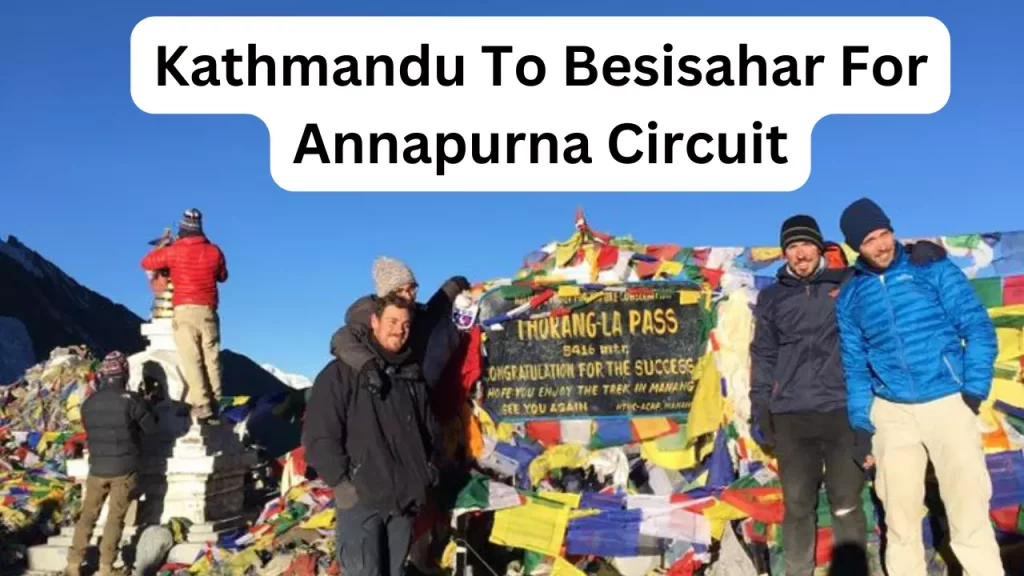
How To Get from Kathmandu to Besisahar? Flight, Bus
Kathmandu to Besisahar is an iconic journey for anyone traveling to Nepal. The 173 km journey takes you through some of the most breathtaking landscapes in the country. Travelers have the option to take a bus, plane, or jeep, depending on the kind of experience they are looking for.
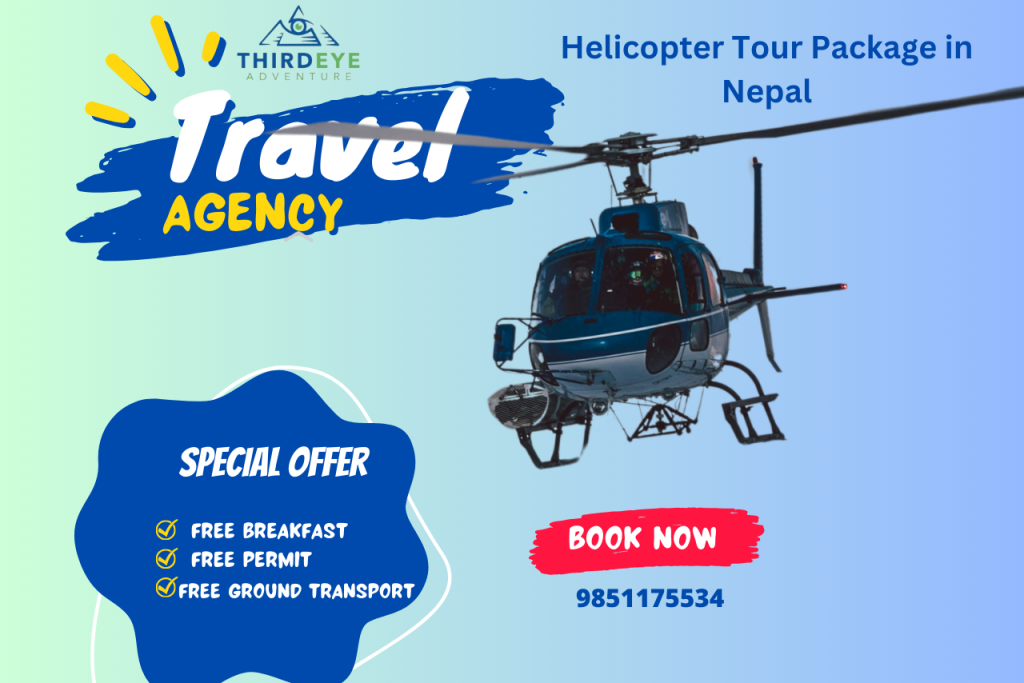
Top Best Helicopter Tour Package in Nepal
When it comes to all the travelers from around the world, there is no doubt that they cannot withstand the serenity of Nepal's bewitched lakes...
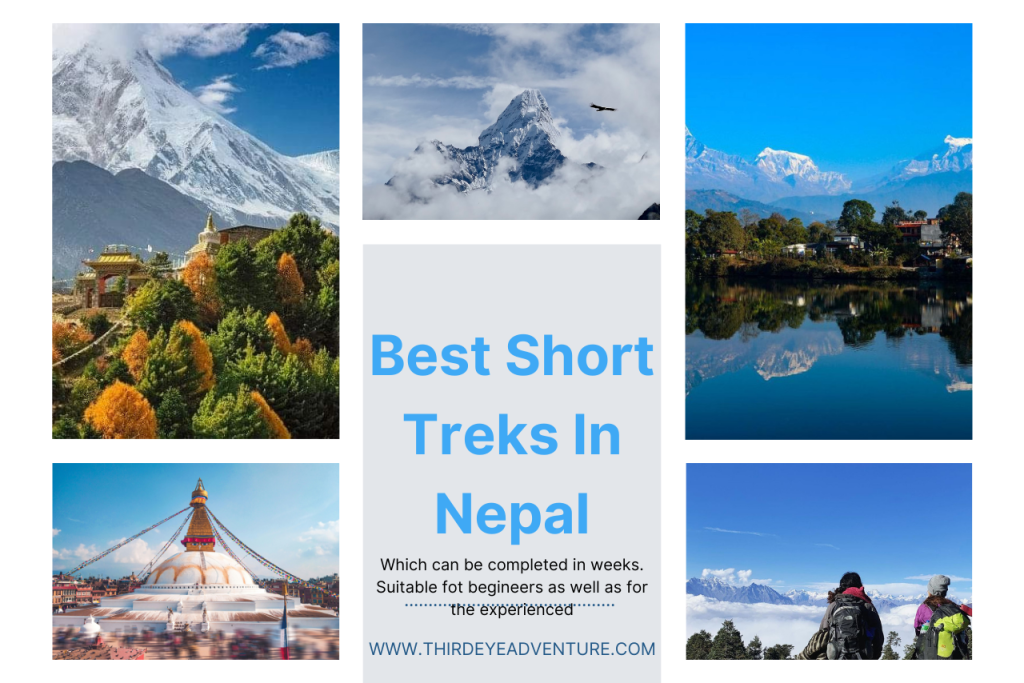
Easiest And Short Treks in Nepal
Nepal is a paradise for trekkers as it has various trekking routes to meet the different needs of the trekkers. The landscape goes through a...
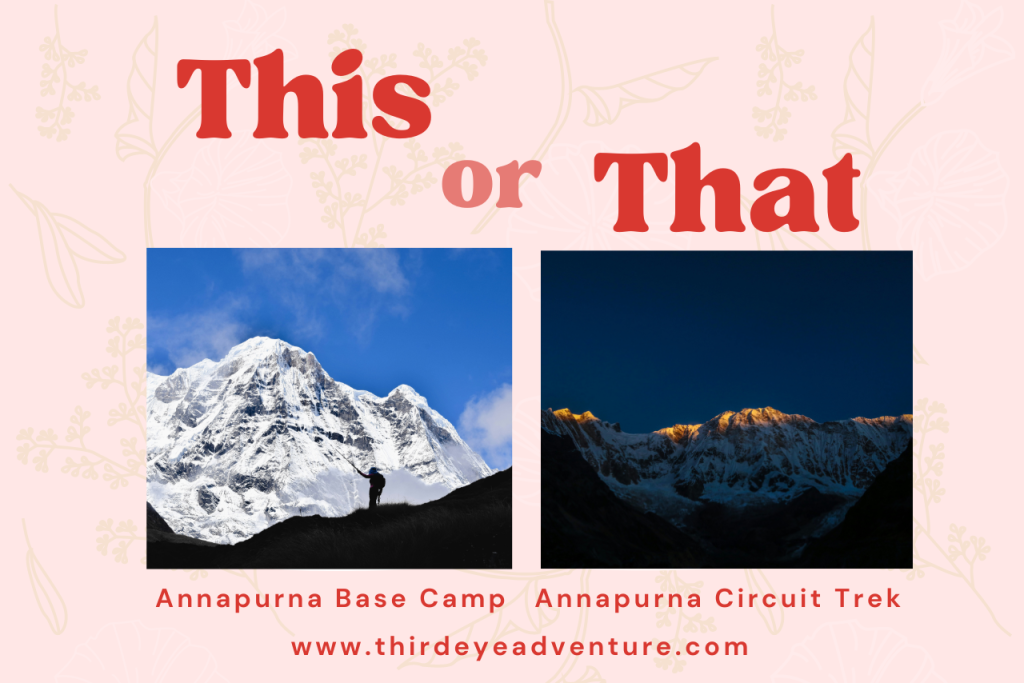
Annapurna Base Camp vs Annapurna Circuit: Which is suitable?
Introduction to the Annapurna RegionWhat is the duration of each trek?What is the maximum altitude reached on each trek?Which trek is more difficult?What is the...
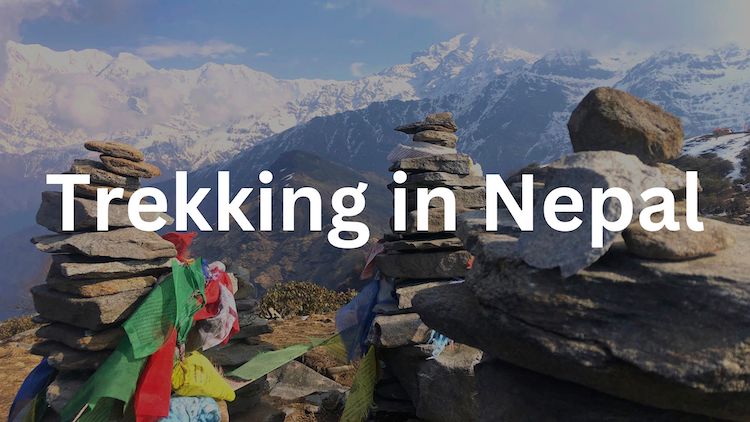
Trekking in Nepal: The Ultimate Trekkers Guide
- July 15, 2023
Nestled in the heart of the mighty Himalayas, Nepal stands as a mecca for trekkers and adventurers from around the globe. With its breathtaking landscapes, awe-inspiring peaks, and rich cultural heritage, trekking in Nepal offers a truly unmatched hiking experience.
From the iconic trails of Everest and Annapurna to the lesser-explored regions, the country’s diverse terrain caters to all levels of trekkers. Whether you seek challenging mountain summits or serene alpine valleys, Nepal’s extensive network of trails promises unforgettable journeys filled with natural beauty, cultural encounters, and personal triumphs.
No matter how little backpacking experience you have, trekking in Nepal is easy, affordable and undoubtedly unforgettable. Are you ready for your Nepal Trekking experience? Then let us get into the best time for a Nepal trek!
Best Time to Trek in Nepal
Unpopular opinion, you can actually trek in Nepal year around, however due to several reasons trekkers usually choose between the two peak seasons i.e. fall and spring. If you’re trekking in Nepal for the first time, I would suggest visiting during one of the peak seasons. The trails are more crowded, and you can interact with more people if you’re traveling alone.
The best times to trek in Nepal are:
For more information about the trekking seasons in Nepal, see the elaborated sections below.

1. Fall (September – November):
This is one of the most popular and peak seasons in Nepal. During this season, you’ll have the best chance to view clear blue skies with towering white snow peaks, sunny days, and the perfect temperature. However, the downside is that you will be sharing the trail with many other tourists and the majority of the tea houses will be crowded, especially along the most popular routes.
Tip: Make sure that your travel agency has booked everything and prepared everything you need. It’s always best to be sure rather than second guess things.
2. Winter Season (December – February):
If you’re an experienced trekker, the winter season will offer sunny days and the best time for amazing mountain views. However, it is worth noting that temperatures can go below zero, shorter daylight hours, and harsh winter storms can probably disrupt travel plans with no warning. Additionally, many popular trails will not be accessible due to extreme snowfall at higher altitudes.
3. Spring (March – May):
Spring is the second most loved season by trekkers. This is the time when snowpack melts on high mountain trails and giant rhododendron ( Nepal’s national flower !) bloom across the hillsides. Mild temperatures are experienced during this time of the year. However, the main downside is that there are busy trails and the possibility of hazy skies which can block mountain views. That said, hazy sides will be less of an issue when you ascend to higher elevations.
4. Summer / Monsoon Season (June – August):
Are you ready for some leeches? Well this season is not advised, due to monsoon season bringing floods and landslides and of course your tiny friends on the way! It is very risky to trek in a fragile environment, with no warning of a landslide falling on you or floods eroding you away and obviously unless you want leech therapy, it’s just a bit too gross! During monsoon season, the weather can also be hot and humid and clouds often barricade the mountains.
5. Off Season trekking in Nepal:
Having trekked around the country, I personally prefer to trek during the off season. It is more rewarding in terms of pricing, easier to find solitude and becoming friends with locals is easier. Although there are significant downsides to trekking outside peak seasons in Nepal, I would advise not to choose travel dates for off season especially, if this is your first time traveling to Nepal.
Need to know the Nepali calendar dates? Then take a look at our Nepali Calendar tool for converting dates!
Types of Trekking in Nepal:
Below are the two main types of trekking in Nepal: Teahouse trekking and camping trekking. We go further into detail in the following sections:
1. Teahouse Trekking in Nepal
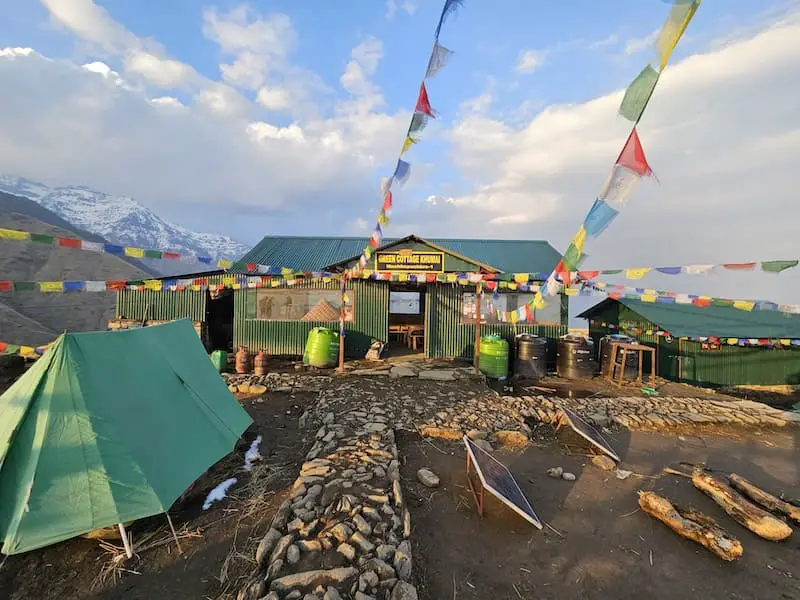
Nepal has recently been popular for Teahouse trekking culture. Teahouses are small mountain lodges frequently spaced along popular trekking routes. Teahouses can be seen on the most frequented trails like the Everest base Camp trek, Annapurna Base Camp trek, Manaslu, and Langtang valley trek. They’re a great place to socialize and meet other travelers, enjoy home cooked traditional Nepali meals, warm your feet by the fire and bed down for the night.
On a teahouse trek route, you’ll have a rest day in one of those lodges after climbing certain meters so that you can acclimatize. Accommodations are simple yet comfortable and super affordable. One of the reasons accommodations are cheap is because you’ll be eating meals wherever you stay. But you can also indulge in other stuff like candy, snacks and beer if you’re feeling a bit snacky! Also, teahouses come with hot showers and decent wifi!
Most teahouses cost between $3-$5 per night and can be booked on arrival too. However, it is always better to ensure that your guide has pre-booked the rooms for you. Teahouses provide you a small room with two twin beds and a shared bathroom down the hall. If you’re not comfortably sharing a bathroom then you can pay an additional price to get a room with an attached bathroom. Blankets are either available in the room or provided, however I would recommend packing a sleeping bag for warmth, comfort and most essentially cleanliness!
2. Camping Trekking: An Alternative Adventure
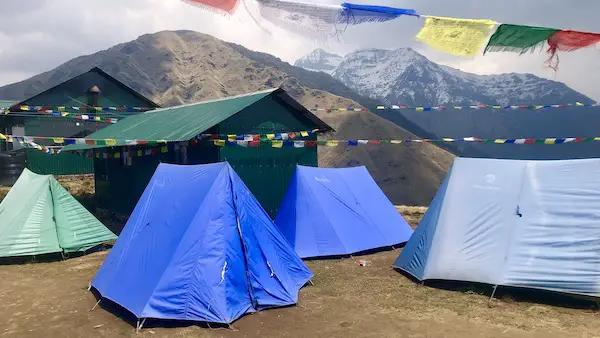
Compared to tea house trekking in Nepal, camping trekking is not as widely known but it offers a unique experience. Camping treks can be enjoyed in all trekking destinations across Nepal. During this type of trek, a team comprising a guide, assistant guide, porter, cook, kitchen helper, and camp helper is provided. The size of the team may vary depending on the number of trekkers. You will carry essential supplies such as food, fuel, trekking equipment, and camping gear throughout the journey.
These two major types of trekking in Nepal differ primarily in terms of food and accommodation. However, there are further subcategories based on various aspects. As a custom tour organizer in Nepal I can make suggestions on a wide range of trekking options. Please don’t hesitate to reach out to me for any type of adventure! I would love to help!
Popular Trekking Routes in Nepal:
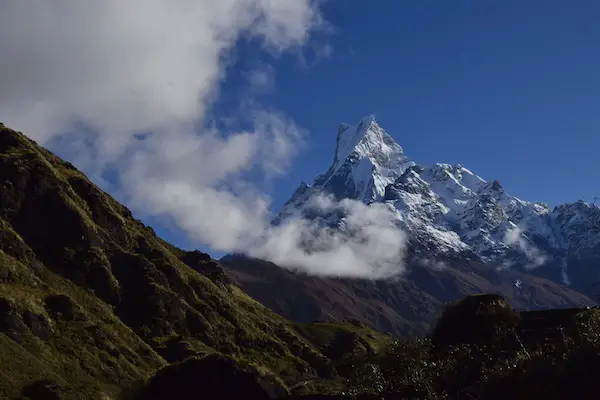
Nepal offers the most unique trails and phenomenal views, and it’s impossible to list all these trails. Having said that, I have listed some of the most popular treks below. For an even more extensive list check out my best treks in Nepal guide!
1. Poon Hill Trek
This is a lower altitude trek and is one of the most popular and easy trek options among trekkers. This trek is best for trekkers who are looking for a shorter taste of Nepal’s trekking culture. The trails are easy and not remote and the 360 view of the mountains from Poon Hill is phenomenal!
2. Annapurna Base Camp (ABC) Trek
This is a stunning trek for those with limited time but still want to experience the majestic Himalayan amphitheater of mountains! This is a lower elevation trek, hence making this trek easier compared to higher elevation treks. This trek is also better for people who are concerned about altitude sickness.
The popular Annapurna Base Camp Trek starts in Pokhara, and passes by a few other well known trekking routes that you can add to your itinerary like: Mardi Himal .
Read the detailed blog on Annapurna Base Camp Trek here!
3. Annapurna Circuit
Annapurna Circuit trek is one of the most favored and easy treks which offers a variety of spectacular views. The trails combine phenomenal mountain views and simple yet vibrant culture of the Sherpas, influenced by the Tibetans. The Annapurna Circuit Trek also takes you to one of the highest trekking passes in the world, the Thorong La. Compared to the ABC trek, I would recommend doing this trek as you’ve already flown a thousand miles and it’s worth adding extra time to see the world’s highest peaks in its full glory!
4. Manaslu Circuit Trek
Any trek destination you choose to go, one thing that is sure that you will get to see is the picturesque view of the Himalayas. Additionally, you will also get to experience authentic Tibetan culture along the route. Manaslu Circuit has just started to get attention but many travelers are yet drawn to the Annapurna and Everest trek. However, Manaslu trek is a league of its own and welcomes you with culturally enriching yet scenically uplifting moments! Manaslu region is also rich in the natural beauty of flora and fauna, forests and rivers in the region. You will also visit Larkya La Pass, which is the highest point in the trek.
5. Everest Base Camp
Everest Base Camp trek is the most popular trekking trail in Nepal and with many good reasons. You get to walk in the footsteps of the world’s most famous climbers, Everest Base Camp is a challenging trek and reaching the top will give you an unforgettable moment, and experience an awe-inspiring moment in the lap of the highest mountain in the world!
Read more about Everest Base Camp Trek in detail!
6. Gokyo Lakes
Everest Base Camp is a popular trekking destination for many travelers and is crowded in the majority of the seasons. However, if you’re looking for more solitude and less interactions, Gokyo trek is the one for you. You can still view Mount Everest from the region and additionally, enjoy the shimmering Gokyo lake. Adding a cherry top – the views from the top of Gokyo Ri may be the finest in all the Himalayas.
7. Langtang Valley
Trekking through the Langtang valley was a popular trekking route in Nepal, before it got hit by the 2015 earthquake. However, it is now rebounding and we are seeing the return of trekkers in the region. This is also another less crowded treks and filled with ample natural diversity, Tibetan culture and breathtaking views of the Himalayas. The trek takes you to a whimsical valley of stunning forests, high alpine meadows and yak pastures. Enjoy the panoramic views across vast open valleys at the end of your trek!
8. Upper Mustang Trek
The ultimate and best trek that you should have on your Nepal trekking bucket list is the Upper Mustang Trek. It is the ultimate gateway to the mysterious ancient Buddhist Kingdom of Mustang, or known as Lo. It was a forbidden and isolated kingdom from the world and as decades passed by the area evolved within its own unique culture and rich traditions tied to Tibet. The Upper Mustang route is a moderate and also a lesser known trek that passes through one of the driest regions of the country and offers incredible views of the Himalayas.
New to trekking? Then check out our guide to the best beginner treks in Nepal !
Trek Difficulty Rating: Things to Consider
Factors such as experience, physical fitness, pack weight, and weather conditions will determine the difficulty level of trekking. In Nepal, there are numerous trekking options available, each with varying levels of difficulty. It is crucial to select a trek that aligns with your fitness level and undergo sufficient training prior to embarking on your journey.
While trekking trips in Nepal do not require technical equipment like ropes, ice axes, or crampons, there will still be challenging ascents and descents. Expect long days and tired legs, but rest assured that treks in Nepal are designed to allow ample time for rest and acclimatization. Although it won’t be effortless, most active hikers perform well on Nepal’s trails, especially with proper pre-trek training.
To alleviate the difficulty of your trek, you can consider hiring a porter to carry heavy gear, leaving you with only a small daypack to carry. This option significantly enhances accessibility along Nepal’s trails. It is noteworthy that we encountered and were impressed by numerous individuals in their 50s, 60s, and even 70s who successfully trekked these trails.
It is now mandatory to have a guide while trekking in Nepal:
This used to be a difficult question for many. However, as of April 2023, Nepal requires all foreign trekkers to trek with a guide . This means anytime you are going into the conservation areas such as Annapurna or Everest, you will need to be accompanied by a guide.
There will still be lower elevation trekking routes, and cultural tours that you can go on without needing to be accompanied by a guide. One such route that I really enjoyed was the Millennium Trek in Syangja – which is low elevation trek through Gurung and Magar villages.
There are a lot of great guides out there that you can easily find online. However, if you need a recommendation of a trekking guide in Nepal, just reach out to me and I would be happy to connect you with one!
Guide and Porter Cost:
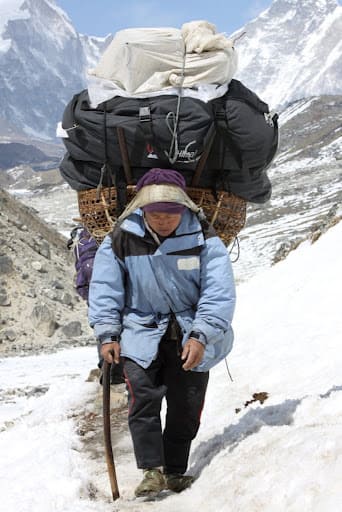
Guides will charge you around $30-40 (NPR 3000-4000) per day and a porter will cost around $15-20 (NPR 1500-2000) per day. A guide will be your logistics and safety manager during the trek. Whereas the porter will help to carry your bag.
Majority of the guides today can speak decent English and will easily guide you throughout your trip. They are also a good source of information on local culture, festivals, traditions, traditional dresses of the area, temples and norms. Your guide will be an extremely useful resource on the trekking route.
Porters are common along the majority of the trekking routes and basically carry your heavy gear bag. Porters are beneficial if you’re traveling with an older trekker, novice trekker or children. However, please note that even if you do decide to take porters with you, I would request every trekker to keep your gear weight to a minimum. Porters have an absolutely difficult job so please don’t make it more difficult for them.
Additionally, make sure to tip your porters and guides well. Hand the money directly to each person to ensure that they get the payment. Porters and guides have a very tough job and they often get surprisingly little compensation for their work.
Trekking in Nepal Gear:

When preparing for a trekking expedition in Nepal, having the right gear is essential to ensure a comfortable and successful journey. Some of the most crucial pieces of gear include a reliable pair of hiking boots and a heavy duty trekking backpack.
Hiking Boots: Essential Footwear for Trekking in Nepal
Opt for sturdy, waterproof boots with excellent ankle support to tackle the diverse terrains and ever-changing weather conditions encountered in Nepal. Investing in high-quality boots will protect your feet from blisters, provide stability on uneven trails, and enhance your overall trekking experience.
Remember that there are differences between hiking and trekking , so you may want different footwear depending on the difficulty and terrain of the trek you choose. If you are looking for assistance on knowing what type of boot you may need, make sure to check out my how to choose hiking and trekking boots guide!
If you already know what type of boot you are looking for, than you may want to go straight to the best hiking boots for under $100 guide instead!
Best Trekking Backpacks: Carrying Your Essentials with Comfort and Ease
In addition to hiking boots, selecting the best trekking backpack is equally vital for a successful trek in Nepal. Look for a backpack that offers ample space to carry all your essentials while ensuring comfort during long hours of hiking. Prioritize backpacks with adjustable straps and a supportive hip belt to distribute the weight evenly and minimize strain on your back and shoulders. Choose durable, water-resistant materials to protect your belongings from rain and moisture.
Consider the capacity of the backpack based on the duration and nature of your trek. For shorter treks, a daypack with a capacity of 20-30 liters may suffice, while multi-day treks require larger backpacks with capacities of 40-60 liters. Look for features like multiple compartments, compression straps, and easily accessible pockets to keep your gear organized and readily available throughout your trek.
Remember, prioritizing quality footwear with hiking boots and selecting a well-designed trekking backpack will ensure comfort, durability, and functionality while trekking in Nepal.
Trekking in Nepal Safety

You will be trekking in the most remote areas of the country and far away from proper hospitals. Therefore, it’s crucial to take every precaution before you head out. Below, I have laid out some safety tips for trekking in Nepal.
- It is crucial to educate yourself on altitude sickness. Make sure to learn more about High Altitude Sickness to protect yourself. Especially if traveling alone!
- Helicopter evacuations are available however many such situations are preventable. HVACs are also expensive so I would recommend getting travel insurance before your trip.
- Don’t ignore weather signs and conditions. Storms are bound to develop quickly in higher elevations and can be fatal if you’re not prepared.
- Always pack a first aid kit! Check out our backpacking checklist and Nepal packing list to know exactly what you should carry on your trek!
- Leave a detailed itinerary with an emergency contact and note down important phone numbers on your diary or piece of paper that will be easy to find during an emergency.
- Yaks and donkey caravans are quite clumsy and can bump into you. Therefore, do not stand close to the cliff side and just let them pass by.
- Always carry enough water on the trail to stay hydrated and prevent altitude sickness. Trekkers traveling from abroad, please don’t forget to carry a water purifier to make sure that your drinking water is clean.
- Trekking trails often make your eyes wander around but it’s also important to keep your eyes on the trail to avoid missteps that could possibly injure you.
Trekking Insurance:
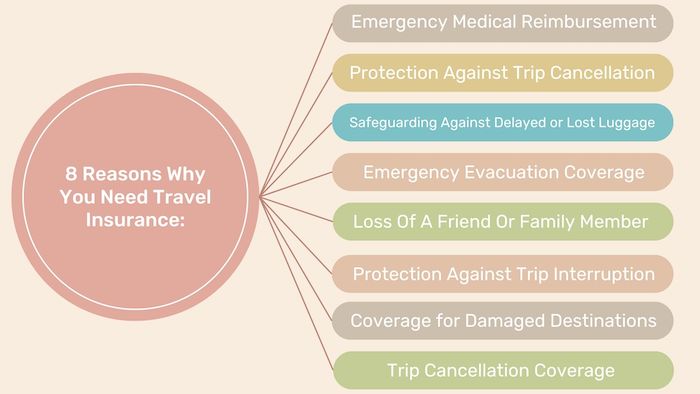
When embarking on a trekking adventure in Nepal, you will need trekking insurance. The rugged terrain and unpredictable weather conditions in the Himalayas can pose risks, making insurance a crucial safeguard for your well-being. Moreover, in order to get your TIMS Pass and Trekking Permits, you will need to provide proof of insurance – check out my is trekking insurance mandatory in Nepal blog for more information.
Before you decide which coverage is best for you, make sure you understand what trekking insurance is , and why do I need travel insurance in the first place . These two resources will ensure you pick the right policy, as they differ significantly.
Trekking insurance is a vital consideration when planning a trek in Nepal. It offers protection and support in case of unforeseen circumstances, allowing you to fully enjoy your adventure while having peace of mind. So when you are ready to choose the right insurance policy for trekking in Nepal, make sure to check out the following two resources: Best Trekking Insurance , and, Insurance for trekking in Nepal .
What is food like while trekking?
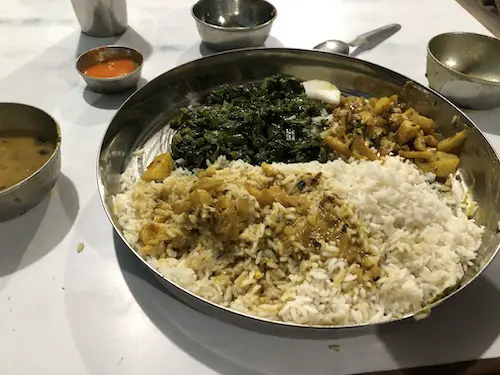
When it comes to teahouse food in Nepal, you can expect simple yet sufficient options. The menus at most teahouses are quite similar, offering a variety of dishes to fuel your trekking adventure. A staple choice is the famous Dhal Bhat, a hearty traditional Nepali food , that combines lentil soup, rice, and vegetables. Additionally, you will commonly find other dishes like momos, pasta, rice dishes, soups, pizzas, and, of course tea and biscuits!
While teahouse menus tend to have consistent offerings, it’s worth noting that prices increase as you venture farther away from cities. The transportation of supplies to remote locations, often carried by yaks or donkeys, contributes to the rise in cost. To ensure you have sufficient sustenance during your trek, it’s advisable to carry snacks for the journey between villages and on longer pass days.
Something to keep in mind is it’s essential to discuss food options and costs beforehand when going with a set tour. Most companies offer two options:
- Paying an up-front fee that covers all food expenses throughout the trip
- Bringing money to pay for meals as you go
Opting for the first option is more convenient as it eliminates the need to carry a significant amount of cash and handle money throughout the day. However, the second option can be more cost-effective since you only pay for the exact meals you order.
Finally, many tea houses will include food charge in the room cost. This means you will get quoted a price for the entire package – which includes room and board, dinner, breakfast, and tea.
Drinking Water and Safety on treks:
Before embarking on a trek in Nepal, it is crucial to have a well-thought-out water treatment plan. While water sources are generally accessible, purifying it for safety is essential.
There are several popular options for water treatment, including water treatment pills, UV sterilizers, and water filters. Although teahouses offer bottled water for purchase, relying on them can be environmentally unfriendly, leading to increased costs and waste during your trip. A lot of trekkers end up using a SteriPEN Ultra (affiliate link!) These devices are fast, user-friendly, and eliminate the need to consume water treated with unpleasant-tasting chemicals.
While hiking, it is advisable to carry a minimum of 1-2 liters of water and replenish it frequently. Staying hydrated is crucial throughout your trek, and this becomes even more vital as you go up in elevation. It’s easy to overlook the need for hydration when the weather is chilly, but maintaining adequate fluid intake is imperative. On colder days, ordering pots of hot tea can be a great way to ensure you stay hydrated while enjoying a warm beverage.
Finances and Money:
When trekking through villages in Nepal, it’s crucial to keep in mind that ATM machines are scarce, and credit card acceptance at teahouses is rare. Therefore, it is essential to ensure you have an ample supply of cash for your trekking adventure. Based on my experience trekking places like Mardi Himal, Khumai Danda and the Annapurna Circuit, budgeting around $30-40 per person per day for food and accommodation was sufficient. Just remember, if you are going to be eating more expensive food, indulging in soda, candy or beer, your expenses will skyrocket!
As a general rule, it’s wise to carry more cash on the trail than you anticipate. Luxuries such as chocolate, tea, beer, Wi-Fi, and hot showers can greatly boost morale, but their costs can accumulate. You may also need cash to purchase small gifts, replace broken equipment, or hire transportation in case of unexpected changes to your travel plans.
Another expense to consider is charging your electronic devices. While some teahouses may offer free battery charging, most will charge a fee (especially the more remote places). Typically, you can expect to pay around $2-5 for a full battery charge.
Most teahouses provide hot showers at an additional cost, usually ranging from $3-5 per shower. However, it’s important to note that the quality of showers can vary greatly, from a simple bucket of hot water to the rare luxury of a proper shower. Typically, for me, the cost often outweighed the benefits of the shower. Instead you can just be stinky, take a cold shower or use wet wipes for quick and convenient cleaning.
Transportation to and from your trek route:
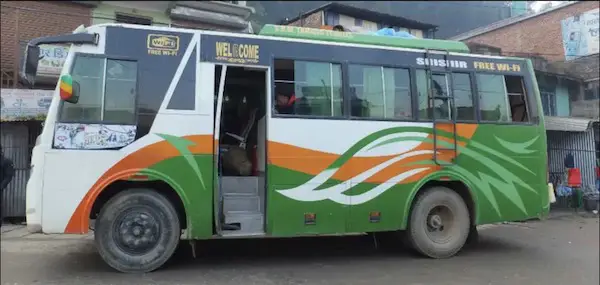
The majority of visitors arrive at Tribhuvan International Airport (KTM) in Kathmandu, the capital city of Nepal. However, as the international airport in Pokhara continues to offer more flights, this could be your starting point as well.
It’s important to note that transportation in Nepal is generally slow-paced. Long bus rides, flight cancellations, and unexpected delays unfortunately tend to be part of the norm. Therefore, it is advisable to allocate a couple of buffer days when planning your trip and embrace the adventurous spirit that comes with it.
Many popular treks depart directly from Kathmandu or Pokhara, the second largest city in Nepal. While some treks may offer flight options for accessibility, many require a lengthy bus or jeep ride to reach the starting point. Depending on your chosen destination, there are usually several transportation options available. Local modes of transportation tend to be more economical, but “tourist” options often provide greater comfort and convenience.
Trekking Permits in Nepal:
When working with a trekking company, they will handle the logistics on your behalf. Every trekker in Nepal requires a TIMS card (Trekking Information Management System), which typically costs around $20. You can obtain your TIMS card and settle your park fees at the Nepal Tourism Board offices in Kathmandu or Pokhara before commencing your trek.
In addition, you are likely to encounter conservation or national park fees, which can be obtained in advance and generally amount to approximately $20-$30, depending on your chosen hiking destination and the length of your trek.
For permits and passes, it is best to speak to your trekking company to understand exactly what you will need for your trip as well as the cost of the pass. You can get your permits and passes in Kathmandu or Pokhara.
To apply for a TIMS card, you will need the following documents:
- Copy of your passport
- 2 passport sized photographs
- Trekking entry and exit dates
- A tentative itinerary
- Emergency contact numbers
Communication: Phones and Wifi while trekking in Nepal
Staying connected while trekking in Nepal is becoming increasingly feasible. Along the most popular routes, teahouses will offer WiFi services, and with a local SIM card, you will get service in many places. However, it’s important not to rely heavily on staying connected as the service is often unreliable at best.
If you plan to purchase a local SIM card in Kathmandu, two main companies are available: Ncell and Nepal Telecom. In the Annapurna region, Nepal Telecom SIM cards tended to work reasonably well, while Ncell was a better option in the Everest region. That being said don’t rely to much on having service while trekking – I mean do you need it anyways? Enjoy the outdoors and nature instead!
WiFi availability at teahouses along your trek may vary, and the speed and functionality can be highly unpredictable. In the Everest region, prepaid WiFi cards are sold (around $3 for 100MB) and generally provide decent service but get consumed quickly. On the Annapurna Circuit, you may encounter a one-time fee of $3-5 for WiFi access, but the connections can be very slow or unreliable, if available at all.
Getting a Visa in Nepal:
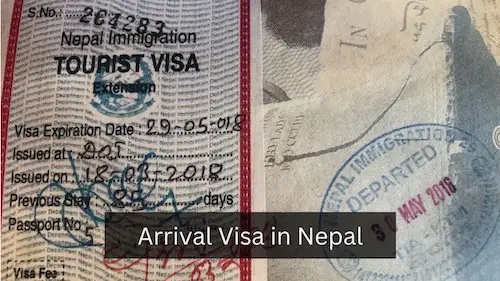
To enter Nepal, it is necessary to obtain a tourist visa – check out our blog about getting a visa on arrival in Nepal . For most travelers, obtaining a visa on arrival at Tribhuvan International Airport in Kathmandu is the preferred option. However, if you are traveling overland from India, it is also possible to obtain a visa ahead of time at a Nepal Embassy.
Tourist visa costs are as follows:
At the international airport, there are electronic visa machines available, and the airport staff is ready to assist with the necessary forms.
Please note that visa policies can change. It is always best to check the current visa guidelines for specific and up-to-date information.
Trekking in Nepal
This comprehensive guide has looked into every aspect of trekking in Nepal, providing you with a wealth of information on trekking routes, seasons, safety measures, gear essentials, and insurance considerations.
By exploring the diverse terrain and majestic landscapes of Nepal, trekkers can embark on unforgettable adventures amidst soaring peaks, serene valleys, and vibrant cultures. From the towering heights of the Everest Base Camp trek to the mystical trails of the Annapurna Circuit, Nepal offers a plethora of options for every level of trekking experience.
FAQs: Trekking in Nepal
Below are some of the most frequently asked questions regarding trekking on Nepal’s various Himalayan routes.
The best mountain treks in Nepal are Everest Base Camp, Upper Mustang, and Annapurna Circuit. Off-the-beaten-path trek options include, Khumai Danda, Mardi Himal, Langtang Valley and Tsho Rolpa Glacial Lake .
Best months for trekking are October and November, following the monsoon season. This applies not only to the well-known areas of Everest and the Annapurnas but also to many other wild and adventurous regions of the country. During this time, you can expect pleasant daytime temperatures, excellent visibility, and long periods of beautiful weather.
Trekking in Nepal ranges from approximately USD $30 to US$100 per day per person. This range is for the more inexpensive treks, where the expensive treks in the Everest region can cost $100-$200 per day per person.
Leave a Reply Cancel Reply
Your email address will not be published. Required fields are marked *
Add Comment *
Save my name, email, and website in this browser for the next time I comment.
Post Comment

- Best Hikes In The World
- Appalachian Trail
- European Hikes
- Nepal Hikes
- Patagonia Hikes
- See All Hikes
- Mount Kenya
- Mount Kilimanjaro
- Mount Toubkal
- See All Mountains
- South Africa
- New Zealand
- Switzerland
- United Kingdom
- Packing Lists
Annapurna Circuit – Nepal’s Classic Circuit Trek
Asia , Hikes , Nepal
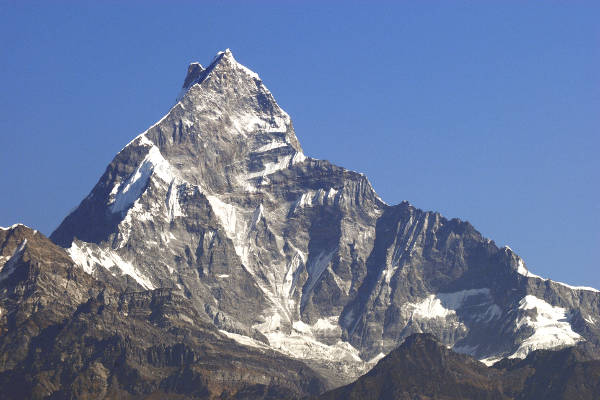
The Annapurna Circuit is one of the most popular and most epic treks in Nepal . This classic trek meanders through Himalayan foothills and over high passes, offering picturesque mountain views along the way.
Annapurna Circuit Trek
Route overview.
The Annapurna Circuit is one of the greatest treks in Nepal, if not the world.
Although road construction over the past two decades has severely impacted the trekking experience (more on this later).
Note: if you are a mountain biker, the road on the western side makes for one of the most exhilarating and scenic mountain biking experiences!
Where Does The Annapurna Circuit Start and End?
The trek begins at Besisahar (which is a 7-8 hour drive from Kathmandu) and concludes in the Kali Gandaki Gorge – the disputed highest gorge in the world that separates Dhaulagiri (8,176 meters) in the West and Annapurna (8,091 meters) in the East.
The circuit is traditionally followed on an anti-clockwise trail – for acclimatization reasons – that circumvents the Annapurna Massif. It takes trekkers through the Annapurna, Manang and Mustang region of central Nepal.
Route Details
At its pinnacle, the trek crosses the Thorung La Pass (5,416 meters) before descending down to the town of Muktinath. From here the road construction activities (2004 -2008/09) have had a measurable impact on the Annapurna Circuit trekking experience.
The Nepalese government have realized that the road on both the Western (Pokhara-Muktinath) and Eastern (Chame-Manang) side of the circuit has had a negative impact on trekking tourism. Thus, they have created a number of New Annapurna Trekking Trails (called NATT-trails).
These NATT-trails, marked blue and white or red and white, take trekkers away from the dusty and unpleasant roads. The alternative routes provide a much more pleasant trekking experience.
How Long Is The Annapurna Circuit?
The Annapurna circuit typically takes between 16-20 days to complete. This is depending if you decide to tack on a diversion to Annapurna Base Camp and the Annapurna Sanctuary ). It covers between 150-240 km depending on when you decide to end the tour or use transportation vehicles.
Scenery and Landscape
The scenery on the Annapurna Circuit is extraordinarily beautiful. Trekkers pass through rice terraced paddy fields, subtropical forests, and glacial environments.
You will see a number of major mountains including the Annapurna Massif (I-IV), three 8,000 metre peaks – Dhaulagiri (8,176 meters), Manaslu (8,156 meters) and Annapurna I (8,091 meters). There are numerous other peaks of 6,000 to 7,000 meters.
Please Note: The Annapurna Circuit is situated in the Annapurna and Mustang regions of central Nepal. It is home to the Annapurna Massif. The schematic below illustrates Nepal’s trekking regions (not to scale).
Annapurna Regional Map
The Annapurna Circuit is situated in the Annapurna and Mustang regions of central Nepal. It is home to the Annapurna Massif. The schematic illustrates Nepal’s trekking regions (not to scale)
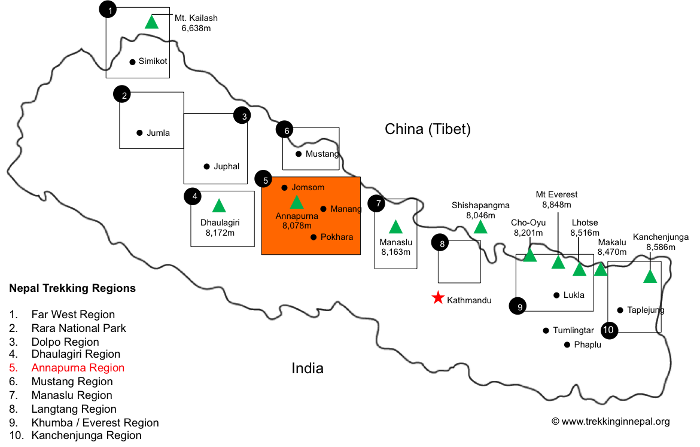
Annapurna Trek Altitude Profile
The schematic diagram below shows the route altitude profile for the Annapurna Circuit.

Annapurna Circuit Itinerary
Below is a detailed Annapurna Circuit itinerary. Where possible we have highlighted the NATT-Trails that can be used to avoid the road. Please note that this is a typical Annapurna Circuit itinerary. Some tour operators offer variations on this route.
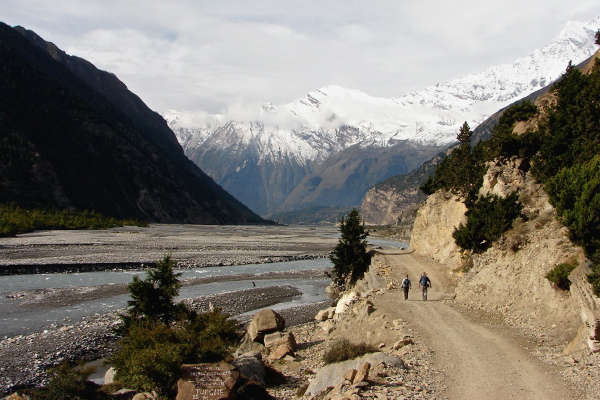
Day 1-2: Arrive Kathmandu (Drive to Besisahar / Fly to Pokhara)
Arrive in Kathmandu, usually spend a day sightseeing in the capital city.
See more in our guide on what to do in Kathmandu .
Drive from Kathmandu (1,300 meters) to Besisahar / Khudi (circa 800 meters) via bus. The trip takes between 7 and 8 hours, meandering through countryside villages.
The Annapurna Circuit typically starts at Besisahar, an hour’s trek from Khudi. Some operators may drive you to Khudi and commence the trek from there.
Day 3: Trek from Besisahar (820 meters) to Khudi and onto Bahundanda (1,310 meters)
Trek from Besisahar (820 meters) to Khudi and onto Bahundanda (1,310 meters). This traditional route has been impacted by the road construction so some operators have started using new trails that bypass the road. Instead, you go to the village of Sikrung (2,200 meters).
The latter is a fairly steep climb to a rather high altitude. But it does offer a more untainted Annapurna trekking experience. Expect to trek between 6-7 hours.
Day 4: Trek from Bahundanda (1,310 meters) / or Sirung (2,200 meters) to Jagat (1,300 meters) or potentially Chamje (1,410 meters)
Trek from Bahundanda (1,310 meters) / or Sirung (2,200 meters) to Jagat (1,300 meters) or potentially Chamje (1,410 meters). If on day 4 you followed the traditional route to Bahundanda, you will trek to Ghermu (1,130 meters) and onto Jagat. You might stay the night here or take a steep hour-long trek up to Chamje (1,410 meters).
We recommend staying the night at Chamje instead of Jagat, which is a dirty and crowded village. If on day 4 you stopped at Sikrung, you will likely follow a route via Syange (1,100 meters) to Jagat and up to Chamje.
Expect to see great rice terraced landscapes and views of the Manaslu Range during early stages of this day’s trekking.
Day 5: Trek from Jagat / Chamje (1,300 / 1,410 meters) to Dharapani (1,960 meters)
Trek from Jagat / Chamje (1,300 / 1,410 meters) to Dharapani (1,960 meters). Continuing north into the Manang region, you will trek through agricultural fields of corn and potatoes and then forests of rhododendrons.
Eventually reach the quaint village of Tal (1,700 meters). From Tal you will trek for another 6 kms (circa 3 hours) via Karte to the village of Dharapani (1,960 meters).
Day 6: Trek from Dharapani (1,960 meters) to Chame (2,710 meters) via Bagarchap and Danakyu, and then either along the lower trail or upper trail to Koto (2,640 meters)
Trek from Dharapani (1,960 meters) to Chame (2,710 meters) via Bagarchap and Danakyu, and then either along the lower trail or upper trail to Koto (2,640 meters).
From Koto you trek a further hour to the busy village of Chame. Some trekkers and operators prefer an overnight stay in the quieter village of Koto. On this rather steep trekking day you will get some great views of Annapurna II and IV, as well as Lamjung Himal.
Day 7: Trek from Chame (2,710 meters) to Pisang via Bhratang (2,850 meters) and Dhukur Pokhari (3,240 meters)
Trek from Chame (2,710 meters) to Pisang via Bhratang (2,850 meters) and Dhukur Pokhari (3,240 meters). From Dhukur Pokhari the trail splits and you may either trek to Upper Pisang (3,310 meters) or to Lower Pisang (3,250 meters) for an overnight stay.
If you take the latter to Lower Pisang we highly recommend re-joining the upper trail on day 8. This provides arguably the best views of the whole Annapurna Circuit.
Day 8: Trek using the upper trail from Pisang (3,310 meters) to Manang (3,450 meters) via Ghyaru (3,730 meters), Ngawal (3,680 meters), Humde (3,330 meters and Bhraga (3,450 meters)
Trek using the upper trail from Pisang (3,310 meters) to Manang (3,450 meters) via Ghyaru (3,730 meters), Ngawal (3,680 meters), Humde (3,330 meters and Bhraga (3,450 meters).
The mountain views on this portion of the Circuit are exceptional, as are the quaint villages along the trail. A visit to Barge monastery is worthwhile before the final stretch to Manang.
Day 9: Acclimatization day in Manang
Manang is one of the main towns on the Circuit. Many trekkers take this opportunity to spend a rest acclimatization day in the town.
Short excursions to the Gangapurna Lake and Bhojo Gompa (a Buddhist ecclesiastical fortification of learning) are common among trekkers. There are also day trips around the town. You might want to consider visiting the offices of the Himalayan Rescue Association for a talk on high altitude risks.
Day 10: Trek from Manang northwest out of the Marshyangdi Valley and up to the small village of Yak Kharka (4,110 meters)
Trek from Manang northwest out of the Marshyangdi Valley and up to the small village of Yak Kharka (4,110 meters). If you haven’t started feeling the effects of altitude yet, you might start doing so from today. Some trekkers continue onto the tiny village of Letdar (4,200 meters). Teahouse accommodation is limited in both these villages.
Day 11: Trek from Yak Kharka (4,110 meters) to High Camp (4,850 meters)
Trek from Yak Kharka (4,110 meters) to High Camp (4,850 meters). This is a fairly tough and steep day. Some tour operators will stop for the night at Thorang Phendi (4,450 meters). This is a good idea if trekkers are struggling with the altitude.
However, continuing on to High Camp is, in our opinion, preferable. This is because it makes the next day’s treks to Muktinath (3,800 meters) a lot shorter and easier. Accommodation facilities and amenities in Thorang Phendi and High Camp are both good. Please note: continuing onto High Camp means sleeping at high altitude, which is not advised if you are suffering from acute mountain sickness (AMS) symptoms .
Day 12: Trek from High Camp (4,850 meters) across the Thorung Pass (the highest point on the trek at 5,416 meters) and then back down to Muktinath (3,800 meters) via Charabu (4,230 meters)
Trek from High Camp (4,850 meters) across the Thorung Pass (the highest point on the trek at 5,416 meters). You then go back down to Muktinath (3,800 meters) via Charabu (4,230 meters). Prepare for a tough, icy-cold day of trekking. The descent from Thorung Pass is steep and trekking poles come in handy. Muktinath, although an important pilgrimage site for both Hindu’s (see the Vishnu Temple) and Buddhists (see the Monastery), is a rather characterless village. Depending on your operator, you will likely stay overnight in Muktinath. For independent trekkers, the Bob Marley Guesthouse in the center of town is a great shout!
Day 13: Trek from Muktinath (3,800 meters) to Marpha (2,665 meters) via the awesome village of Kagbeni (2,800 meters)
Trek from Muktinath (3,800 meters) to Marpha (2,665 meters) via the awesome village of Kagbeni (2,800 meters). From Kagbeni to Jomsom we recommend taking a jeep to avoid the unpleasant dusty roads.
Once you get to Jomsom you can join the ne NATT-trail (which is 2 hours longer than the road option) to Marpha. Marpha is famous for being the centre of the apple region in Nepal. Do try the apple brandy if you get a chance.
Day 14: Trek from Marpha (2,665 meters) to Kalopani (2,530 meters), via Chokhopani, and continue to Kokhethanti to avoid the road
Trek from Marpha (2,665 meters) to Kalopani (2,530 meters), via Chokhopani, and continue to Kokhethanti to avoid the road. Some trekkers grab a jeep from Marpha all the way to Tatapani (see day 15).
Day 15: Trek from Kolapani (2,530 meters) to Tatapani (1,200 meters)
Trek from Kolapani (2,530 meters) to Tatapani (1,200 meters). Using a new NATT-trail (marked in red and white), you can avoid the road and follow a trail that climbs steeply before joining a path that will take you through the towns of Kopochepani, Rupsechhahara, Dana and finally Tatapani.
Day 16: Trek up from Tatapani (1,200 meters) to Ghorepani (2,870 meters)
Trek up from Tatapani (1,200 meters) to Ghorepani (2,870 meters), via the towns of Ghara, Sikha and Chitre. You will most likely stay overnight in Ghorepani in preparation for an early start the next day.
Day 17: Trek from Ghorepani (2,870 meters) up Poon Hill (3,870 meters) and back down to Tadapani (2,710 meters)
Trek from Ghorepani (2,870 meters) up Poon Hill (3,870 meters) and back down to Tadapani (2,710 meters). You will start this days trekking early so as to get up Poon Hill for the impressive sunrise. First light illuminates surrounding rice terraces and Annapurna and Dhaulagiri massifs. The classic Annapurna Circuit trek then descends to Tadapani for an overnight stay.
Note: we have heard that instead of heading up Poon Hill, the hill opposite in the direction of Chomrong provides an equally impressive (if not better view) without any crowding issues.
Day 18: Trek from Tadapani (2,710 meters) to Naya Pul (1,070 meters) via Gandruk and then catch a short bus ride back to Pokhara
Trek from Tadapani (2,710 meters) to Naya Pul (1,070 meters) via Gandruk and then catch a short bus ride back to Pokhara. This is the end of the Annapurna Circuit and an extraordinary 18 days!
Note: It is possible to follow the old Annapurna Circuit from Ghorepani to Phedi via Landruk, although this takes an extra 2 days compared to the direct exit from Ghorepani to Naya Pul.
Please Note: From Muktinath onwards the classic Annapurna Circuit has been severely impacted by the road that joins Jomsom to Muktinath. If you choose to trek this route be prepared for an unpleasant and dusty experience, as jeeps wiz by you. Thankfully there are alternative options via the New Annapurna Trekking Trails (NATT-trails).
Suggested route options from Muktinath
If you are not on a set tour we suggest the following route:
- Trek to the charmingly wonderful town of Kagbeni (2,800 meters) for an overnight stay. We recommend taking the high trail out of Muktinath via Jhong, as this offers better mountain views
- From Kagbeni to Jomsom take a jeep as dust driven from the common winds in this region and the constant flow of vehicles on the road make for unpleasant trekking
- From Jomsom take the new NATT-trail (marked in red and white) to Marpha (2,665 meters) where you can stay overnight and then continue following the route set out from Day 13 below
Also Note: As the road starts in Muktinath, you can cheat and catch a truck all the way to Jomsom. Continue your trek or catch a flight to Kathmandu if you need to shorten your trek (we highly recommend not skipping Kagbeni though). You can also get a bus from Muktinath all the way back to Pokhara if you have run out of time. If you are a mountain biking fanatic you can rent a mountain bike to take one of the most amazing rides down and out of Muktinath – this area of Nepal is fast becoming mountain biking Mecca
Annapurna Route Variations
There are a number of route variations on the Annapurna Circuit. Here are three worth mentioning.
If you don’t have much time in the Annapurna Circuit you may want to consider the Poon Hill Trek , The Royal Trek or the Ghorepani Poon Hill Trek (also called the small Annapurna Circuit). Nepal is heaven for trekkers and has some of the best thru-hikes in the world .
- Annapurna base Camp Trek
- Naar-Pho Valley
- Tilicho Lake
It is possible to include a five day diversion to Annapurna Base Camp onto the Annapurna Circuit trek. This involves continuing north from Tadapani so as to join the old Annapurna Circuit at Landruk.
Read more about the Annapurna Base Camp Trek
A variation to the Annapurna Circuit that has been growing in popularity since opening to foreigners in 2002 is the Naar-Pho Valley.
The route begins near Koto (on day 5/6 of the classic Annapurna Circuit) and follows a trail via two distinctly Tibetan villages – Phugaon and Naar – which are both located at over 4,000 meters. After nine days trekking the route exits via the Kang La Pass (5,300 meters) to Ngawal, where you re-join the Annapurna Circuit on your way to Manang. The detour via the Naar-Pho Valley in effect adds seven days to the traditional Annapurna Circuit as you would have spent two days trekking from Koto to Ngawal and on to Manang had you stayed on the main track.
A special permit, which can only be organised through a trekking agency, is required to enter the Naar-Pho Valley. You will also need to take a guide as tourist infrastructure is poor. Most trekkers opt for the traditional camping style of trekking with porters, tents and cooks.
A 3-4 day trek to Tilicho Lake (4,920 meters), one of the highest lakes in the world, has become a relatively popular diversion on the Annapurna Circuit.
The trek starts in Manang, and follows a path on the northern side of the valley to Khangsar (note: there are maps that show a path on the southern side of the valley but we recommend avoiding this as it is in poor condition and prone to landslides).
From Khangsar there are two paths that leave the town – the lower and upper path. Take the upper path, as it is safer, until you reach Shree Kharka where you can overnight at one of the two teahouses there.
From Shree Kharka walk about 45 miuntes until you reach point where the path splits into a lower and upper trail. Make sure to take the lower trail (the upper trail is marked ‘Danger’). A further 3 hours trekking and you will arrive at Tilicho Base Camp where you can stay overnight at one of the teahouses.
Depart Tilicho Base Camp early the next morning to avoid the high winds and clouds that roll in by mid-morning. The trek up to the lake is steep and tough. It takes about 3 hours and can be very cold due to the altitude, so dress warmly. The descent follows the same path back to Base Camp (approx. an hour) or to Shree Kharka (4 hours from the lake). Overnight at Shree Kharka.
The next day take a trail (which is signposted) directly to Yak Kharka via Old Khangasar, where you re-join the Annapurna Circuit.
Recommended Guidebook

Need an up-to-date guide book with maps that include the NATT-Trails? We recommend either Andrées de Ruiter and Prem Rai’s guide, Trekking the Annapurna Circuit , or Sian Pritchard-Jones and Bob Gibbons guide, Annapurna: A Trekker’s Guide .
Annapurna Circuit FAQ
How much does it cost to hike the annapurna circuit.
The cost of an Annapurna Circuit varies depending on which route variation you take. It also depends when you trek (out of season tends to be a little cheaper) and whether to trek with a local or western trekking agency, or indeed independently.
We have provided a detailed Annapurna Circuit Cost article here but in summary you should budget for the following key expenses:
Visa, Vaccinations, Insurance etc: ~$300-$500
Equipment (buying and hiring): ~$500-$800
Flights to Kathmandu: ~$1,000
Tour Agency: ~$1000 for a cheap local agency to ~$3,000 for a pricey Western trekking agency. You could do an independent trek for ~$700 employing a local guide
check out our list of Nepal trekking companies recommendations .
Tips: ~$200-$300
Misc (additional food, unplanned travel / hotels ect): $200
Total Costs: $2,500 – $5,000
Do I need a permit for the Annapurna Circuit?
Yes. An Annapurna Conservation Area Project permit and Trekker Information Management System registration are required for the Annapurna Circuit trek.
If you are joining an organised tour, these will be arranged for you. If you are looking to go it alone you will have to bring four passport-sized photographs and go to the offices of the Nepal Tourism Board in Kathmandu to apply. We recommend bringing copies of your passport and insurance policy. The offices follow government working hours and days, and are not open on Sunday.
When is the best time to hike the Annapurna Circuit?
The best time to trek the Annapurna Circuit is either in the Spring (March to Mid May) or in the Autumn (mid / late September to December). Unfortunately these also happen to be the busiest times of the year as they are the best time for Nepal trekking ..
Towards December the weather starts getting particularly cold and the routes get distinctly quieter. If you are a hardened trekker a winter Annapurna Circuit (late December through February) can provide a very authentic Nepal trekking experience.
The main challenge of a winter trek, apart from the cold, is the snow and ice that often obstructs the higher trails and the Thorung Pass. During bad winter seasons these trails may be closed.
Unlike the Everest region that gets very wet during the rainy monsoon season, the Annapurna and Mustang regions stay relatively dry, making June through September, a relatively good time to trek as well.
Here’s a detailed article on weather on the Annapurna Circuit .
Is altitude sickness a risk on the Annapurna Circuit?
Yes, some trekkers do suffer from altitude sickness on the Annapurna Circuit as it is a high altitude trek. At its highest point, Thorung Pass, you will reach an altitude of 5,416 meters (17,769 feet).
Fortunately because of the circuits length the opportunities for appropriate acclimatisation are good. Hence, the prevalence of moderate or sever altitude sickness is low.
Nonetheless, it is important to have a detailed understanding of the risks associated with high altitude trekking and how the body acclimatises.
We recommend you read our detailed article on Altitude Sickness and Acclimatisation .
How difficult is the Annapurna Circuit hike?
The Annapurna Circuit trek is challenging. You will be trekking for 4-7 hours a day for over two weeks, so you will need to be peak physical condition. The best way to prepare is to get as many kilometres under foot on hikes in your home country.
What do I need to pack for the Annapurna Circuit trek?
Trekking in the Annapurna region requires a number of essential pieces of trekking clothing and equipment. AC is a long and tough trek. You will be exposed you to a range of altitudes where temperatures fluctuate dramatically between night and day.
Many pieces of equipment can be rented or bought in Kathmandu or Pokhara. Even so, we recommend bringing the most important pieces of gear with you.
We've written a detailed Annapurna hiking packing list .
Insurance Information
Trekking insurance is a must in Nepal. This is particularly the case in the Annapurna Region, which at stages is very remote. If an accident should occur that requires medical assistance and evacuation you will definitely want trekking insurance that can cover the costs of air ambulance and treatment.
Moreover, it is prudent to have insurance that covers you for any travel related risks. insurance should cover stolen, damaged or delayed baggage; flight delays and interruptions; and tour operators default.
This article on travel and trekking insurance in Nepal provides detailed information on what type of insurance you need.
About the author
Mark Whitman
Mark has trekked extensively in Asia, Europe, South America and Africa. He founded Mountain IQ in 2014 with the sole aim to be the best online information portal to some of the most popular mountain destinations around the world. When not writing for Mountain IQ, Mark is out exploring the outdoors with his wife!
Leave a Reply
Your email address will not be published. Required fields are marked
Thanks for the useful information. Really helpful!
Hi Mark, this is a really nice blog with very comprehensive information!!
I'd like to do the trekking on my own, as an independent trekker, but I've heard that there are some new regulations comming for this year (2023) and that a local guide or agency is mandatory to do the central part of the annapurna circuit. Also, that the TIMS can not be got by independent trekkers but only if you hire an agency. Would you have any up to day news about it?
Hi Daniel, thanks for checking in. I’m not aware of the new regulations, but it is definitely possible. Nepal authorities have been talking about this for years. Here’s the latest from the Guardian: https://www.theguardian.com/travel/2023/mar/30/nepal-imposes-ban-on-mountain-trekking-without-a-guide
We work with local guides to offer great value adventures at unbeatable prices

Himalaya Discovery Adventures
Trekking in Nepal Costs & Budget

Trekking in Nepal costs is cheap but at the same time adventurous. It is economical and budget-friendly to trek in Nepal. Nepal offers a wide range of easy to moderate to strenuous trekking options which can be tailored depending on your preference.
Nepal is a paradise for trekkers blessed with stunning scenery and exotic view of the Himalayas . Besides the spectacular scenery, it also offers a chance to discover the rich culture. Often you meet local people from different ethnic groups and communities.
You can go trekking at any season in Nepal. Every season has its own advantages and offers a unique experience . And, there’s still something new and exciting to offer.
Nepal can be a cheap trekking destination. However, the prices are comparatively higher during the busy season than in off-season.
However, there are several other factors that increase the cost of trekking in Nepal .
For example, the following are some of the factors that affect your total trekking costs in Nepal, which you might have to consider.
- The destination that you are planning to visit
- The seasons you would like to visit
- Trekking length and duration of your trip
- The cost of the trek permits
- The guide and porter costs
- Type of Accommodation
- Type of transportation
- Food and drinks
- Other miscellaneous costs
If you are planning on going independent adventure or trekking in Nepal, you are no longer allowed from April 1st 2023. Nepal’s new rule banned solo travel and requires a guide for any trekking or expeditions. Buying a package tour is the most comfortable way to trek within a budget in Nepal.
Here are few cost ranges for the most famous treks in Nepal:
- 14-day Everest Base Camp Trek – USD 1390 p.p.
- 12-day Annapurna Circuit Trek – USD 895 p.p.
- 10-day Annapurna Base Camp Trek – USD 790 p.p.
- 7-day Langtang Valley Trek – USD 490 p. p.
- 14-day Upper Mustang Trek – USD 1880 p. p.
- 11-day Everest Gokyo Lake/Ri Trek – USD 1290 p.p.
Now, let’s get into detail about the cost of Nepal trekking.
Trekking in Nepal Costs
There are several options available such as tourist coaches, local buses, private jeeps, cars and flights.
Among other means of transportation, the local buses are the cheapest. So, to minimize the travel costs, you can go for public transportation. Nevertheless, Nepal’s public transportation is a unique experience in itself.
A local bus will cost you between USD 2 to USD 8. But you can choose tourist buses or jeeps for better comfort and services.
The tourist bus will cost approximately USD 8 to USD 30. The cost of the jeep is around USD 45 to USD 65 per person and the cost of a flight is USD 120 to USD 187 per person for one way.
The cost can vary depending on the distance you are traveling in or the destination you plan to visit.
Trekking in Nepal Permits Costs
While trekking in Nepal, you will need a trekking permit. You will need two permits for every trek in Nepal, a national park permits and a TIMS card (TIMS: Trekker’s Information Management System).
And most often, depending on your trekking route, you will even need more than two permits.
There are two different types of TIMS cards (green and blue). The green which cost is USD 20 for independent trekkers. And the blue cost is USD 10 for trekkers who are part of a group with a guide.
Here below are the permit costs for foreign nationals to enter National Parks / Conservation Areas:
- Sagarmatha National Park permit cost: USD 40
- Annapurna Conservation Area permit cost: USD 28
- Manaslu Conservation Area entry permit cost: USD 28
- Kanchenjunga Conservation Area permit cost: USD 28
- Langtang National Park permit cost: USD 40
- Makalu-Barun National Parks permit cost: USD 40
- SAARC nationals permit cost: USD 2
Additionally, you will need special trekking permits before trekking to the restricted areas of Nepal. The local trekking companies can easily obtain these permits. The amount of the permit cost for restricted areas depends on the duration of your stay and the season of the year.
The Upper Dolpo , Upper Mustang, Manaslu, Tsum Valley , and Kanchenjunga are some of the restricted areas.
For the first 10 days you need to pay USD 500 per person for Upper Mustang and Upper Dolpo. Afterwards, you have to pay USD 50 per person per day.
If you are planning to climb the Himalayas or some peaks in Nepal, you will need a special climbing permit.

Trekking in Nepal Accommodation Costs
Accommodation costs varies along with the altitudes, seasons and trekking routes.
Most the tea-houses offer standard comfort and services on popular routes. Most rooms include twin beds with showers available.
Tea-houses cost is anywhere between USD 3 to USD 5 per night. And the same rooms cost just about USD 2 to USD 3 a night during the off-season.
The accommodation costs are higher during the peak seasons (March to May and September to November) than in other seasons.
The price can go up to USD 10 per night at higher altitudes.
While trekking to Annapurna Circuit, Annapurna Base Camp and Everest Base Camp, you can find luxury lodges. These luxury accommodations provide a higher level of comfort and will cost you about USD 100 to USD 300 per night.
Trekking in Nepal Food and Drinks Costs
Most tea-houses sell local basic meals. It also provides a variety of breakfast and dinner options including tea and coffee.
At higher altitudes, food prices are generally more expensive. Transporting the food up to higher altitude is difficult. As several parts of Nepal is not easily accessible to transportation.
At the beginning of the trek, the food cost is about USD 3 per meal, and at the higher altitude this price can go up to USD 10 per meal.
So, the higher you go the prices becomes more expensive. One liter of bottled water can begin at USD 0.40 cent and cost up to USD 2+ at high camp.
The prices also vary from high to peak trekking seasons.
Trekking in Nepal Guide and Porter Costs
When you trek to higher altitudes, guides and porters are extremely important for your safety. Don’t skimp on your guide if you want a great trekking experience in Nepal.
The costs for guides and porter vary according to season and region of the trek. Everest guide charge a bit more than Annapurna guide. The remote region, Far west Nepal trekking guides also charge more.
Generally, low-end guides price starts at around USD 25 to USD 30 per day. A good guide’s average cost is USD 35 to USD 40. A high-end guide will cost you about USD 50+ with additional language skills as per your preferences
Porters cost you between USD 20 to USD 25 a day. The porter will carry about 20 kg of the load.
Miscellaneous Costs of Trekking in Nepal
Charging electronics (e.g. camera, computer, back-up battery etc.) will cost you between USD 2 to USD 4 at a time. Bring with you a portable solar charger or a power bank. It helps to reduce some of the costs.
Hot showers may cost you around USD 3 to USD 5, especially at the high altitude. In the mornings and afternoons, you can use wet wipes or a small towel to refresh you.
Additional costs for using WIFI in some regions are also included. WIFI cards cost around USD 3 for 1000 MB as in the Everest region. And you can get a one-time charge USD 3 to USD 5 for WIFI access on the Annapurna Circuit .
You may show your appreciation by a little tip if you are satisfied with the services provided by the guide and porter.
Whereas visiting monasteries, Gombas or stupa, you may find donation boxes. A small amount can be donated here, and this is absolutely up to your choice.
Tips to Reduce the Costs of Trekking in Nepal
Trek with friends/group. The price is always cheaper with more people. If six people are trekking, for example, everyone can share the cost of the guide or transportation. This makes it considerably cheaper than hiking with just two people. Instead of a flight, take a bus.
You have to fly in and out of Lukla while trekking in the Everest region. Moreover, you will have to pay to enter the National Park, add additional days depending on where you begin.
Trekking is indeed more expensive in the Everest , Kanchenjunga, Manaslu regions than in the Annapurna region. And if you trek in the Annapurna or other areas such as Langtang , Mardi Himal, Pikey Peak , Indigenous People Trail a bus will add time to your journey, but it will cost you slightly less.
Avoid fancy hiking gear. The latest high-tech equipment is not required for most treks in Nepal. Most of the equipment can be easily bought in Kathmandu or Pokhara at cheap prices. You may also rent equipment.
Leave most of your stuff at the hotel so you don’t have to need porter. By leaving most of your stuff in a hotel you can save a lot – they do not charge as long as you stay.
Eat on a trek like a local. It is the cheapest food out there that is most nutritionally rich. Also, bring your own chocolate bar if you have a sweet tooth.
Don’t stay at the famous lodge. Stay along the trails in lesser-known locations. There won’t be that much of an accommodation difference, but the price could be much cheaper.
A package trip in Nepal. This can keep prices as low as it can.
Trekking in Nepal costs mainly depends on your choices. The prices change with your choice of destination, duration and length of the journey. Plus, extra shopping plan, souvenirs, even charities.
Finally, you should get is good travel insurance for your journey. Make sure that your policy includes both your trek and the altitude you cross on your trek.
General Nepal Travel FAQs
What dates does the trek start?
Your trek begins on the date that works best for you, because all our trips are customized to your travel dates by our specialists. In Kathmandu, you usually need at least 1-2 day before you trek to arrange the trekking permits.
Where do I store my luggage while trekking?
You can leave your extra luggage at your Kathmandu hotel or at our office. So, when you come back from your trek, your luggage will be waiting for you at your hotel.
What types of boots do I need for treks?
You should bring comfortable and good trekking boats. There can be some snow especially when crossing high passes so it is important to be prepared for a variety of conditions.
Your shoes do not have to be warm but strong and durable. It must have a chunky sole — ideally made of Vibram or another durable material and must also protect your ankles.
How much should I tip the guide & porters?
Tipping is not mandatory but is expected, and depends on your satisfaction with the service. Guides, porters and drivers (both for trekking and cultural tours) are typically provided with a tip at the end of your trip.
How difficult are the treks in Nepal?
Classification of the difficulty of a trek is quite tricky as it depends on your physical fitness and your mountain hiking experience. The difficulty of a trek in the Himalayas depends on the steepness, altitude and duration of the trek.
Generally, the higher you go the more difficult the trek is. It is fairly moderate trekking, but in some days, it is more difficult than other treks in the lower foothills ( Poon hill , Mardi Himal and Pikey Peak). Treks in higher altitudes ( Everest Three Pass , Manaslu Circuit, Everest Gokyo Ri, Annapurna Circuit and Nar Phu Valley ), as you pass 5000m, and longer days, are more challenging.
What does ‘teahouse’ trekking mean?
Teahouse hiking refers to staying at night in a small local lodge. The lodges have 5 – 10 rooms and a common area for dining and hanging out. In Nepal, the most treks are teahouse treks where local people run their lodges.
Do you have any question about trip to Nepal?
- Solo Traveller
- Number of child (if you have child in your family/group) (Optional)
- When will you be traveling?* * Day 1 2 3 4 5 6 7 8 9 10 11 12 13 14 15 16 17 18 19 20 21 22 23 24 25 26 27 28 29 30 31 Month 1 2 3 4 5 6 7 8 9 10 11 12 Year 2025 2024 2023 2022 2021 2020 2019 2018 2017 2016 2015 2014 2013 2012 2011 2010 2009 2008 2007 2006 2005 2004 2003 2002 2001 2000 1999 1998 1997 1996 1995 1994 1993 1992 1991 1990 1989 1988 1987 1986 1985 1984 1983 1982 1981 1980 1979 1978 1977 1976 1975 1974 1973 1972 1971 1970 1969 1968 1967 1966 1965 1964 1963 1962 1961 1960 1959 1958 1957 1956 1955 1954 1953 1952 1951 1950 1949 1948 1947 1946 1945 1944 1943 1942 1941 1940 1939 1938 1937 1936 1935 1934 1933 1932 1931 1930 1929 1928 1927 1926 1925 1924 1923 1922 1921 1920
- How many days do you have?* *
- Give your trip a short title* *
- Private Trip
- Bellow 200$
- 200$ - 500$
- 500$ - 800$
- 800$ - 1200$
- 1200$- 2000$
- 2000$ and above
- Describe your trip* *
- Full Name* *
- Your Email* *
- Country* * Afghanistan Albania Algeria American Samoa Andorra Angola Anguilla Antarctica Antigua and Barbuda Argentina Armenia Aruba Australia Austria Azerbaijan Bahamas Bahrain Bangladesh Barbados Belarus Belgium Belize Benin Bermuda Bhutan Bolivia Bonaire, Sint Eustatius and Saba Bosnia and Herzegovina Botswana Bouvet Island Brazil British Indian Ocean Territory Brunei Darussalam Bulgaria Burkina Faso Burundi Cabo Verde Cambodia Cameroon Canada Cayman Islands Central African Republic Chad Chile China Christmas Island Cocos Islands Colombia Comoros Congo Congo, Democratic Republic of the Cook Islands Costa Rica Croatia Cuba Curaçao Cyprus Czechia Côte d'Ivoire Denmark Djibouti Dominica Dominican Republic Ecuador Egypt El Salvador Equatorial Guinea Eritrea Estonia Eswatini Ethiopia Falkland Islands Faroe Islands Fiji Finland France French Guiana French Polynesia French Southern Territories Gabon Gambia Georgia Germany Ghana Gibraltar Greece Greenland Grenada Guadeloupe Guam Guatemala Guernsey Guinea Guinea-Bissau Guyana Haiti Heard Island and McDonald Islands Holy See Honduras Hong Kong Hungary Iceland India Indonesia Iran Iraq Ireland Isle of Man Israel Italy Jamaica Japan Jersey Jordan Kazakhstan Kenya Kiribati Korea, Democratic People's Republic of Korea, Republic of Kuwait Kyrgyzstan Lao People's Democratic Republic Latvia Lebanon Lesotho Liberia Libya Liechtenstein Lithuania Luxembourg Macao Madagascar Malawi Malaysia Maldives Mali Malta Marshall Islands Martinique Mauritania Mauritius Mayotte Mexico Micronesia Moldova Monaco Mongolia Montenegro Montserrat Morocco Mozambique Myanmar Namibia Nauru Nepal Netherlands New Caledonia New Zealand Nicaragua Niger Nigeria Niue Norfolk Island North Macedonia Northern Mariana Islands Norway Oman Pakistan Palau Palestine, State of Panama Papua New Guinea Paraguay Peru Philippines Pitcairn Poland Portugal Puerto Rico Qatar Romania Russian Federation Rwanda Réunion Saint Barthélemy Saint Helena, Ascension and Tristan da Cunha Saint Kitts and Nevis Saint Lucia Saint Martin Saint Pierre and Miquelon Saint Vincent and the Grenadines Samoa San Marino Sao Tome and Principe Saudi Arabia Senegal Serbia Seychelles Sierra Leone Singapore Sint Maarten Slovakia Slovenia Solomon Islands Somalia South Africa South Georgia and the South Sandwich Islands South Sudan Spain Sri Lanka Sudan Suriname Svalbard and Jan Mayen Sweden Switzerland Syria Arab Republic Taiwan Tajikistan Tanzania, the United Republic of Thailand Timor-Leste Togo Tokelau Tonga Trinidad and Tobago Tunisia Turkmenistan Turks and Caicos Islands Tuvalu Türkiye US Minor Outlying Islands Uganda Ukraine United Arab Emirates United Kingdom United States Uruguay Uzbekistan Vanuatu Venezuela Viet Nam Virgin Islands, British Virgin Islands, U.S. Wallis and Futuna Western Sahara Yemen Zambia Zimbabwe Åland Islands Country
- Phone Number (Optional)
You May Also Like...
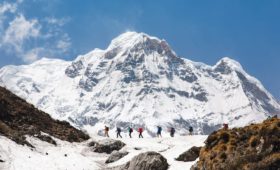
Sherpa Independent Trekking Guide in Nepal
Trekking in nepal in april.
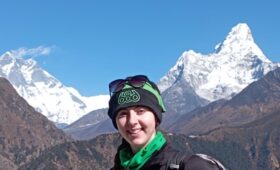
Trekking in Nepal in January
Leave a reply cancel reply.
Your email address will not be published. Required fields are marked *

“I was born and raised in Nepal, nearby Everest region. I am proud to be a native Sherpa, and I have been a Mountain guide over a decade now. Following my passion, I decided to start helping travelers with their travel plans! I think life is a journey, a trip where you collect experiences when you share with other people and with nature.”
Privacy Overview
- Customize Trip

- TripAdvisor Awards 2018/2019/2020/2021/2022
- WhatsApp & Viber +977 9851072590
- Mail Support [email protected]
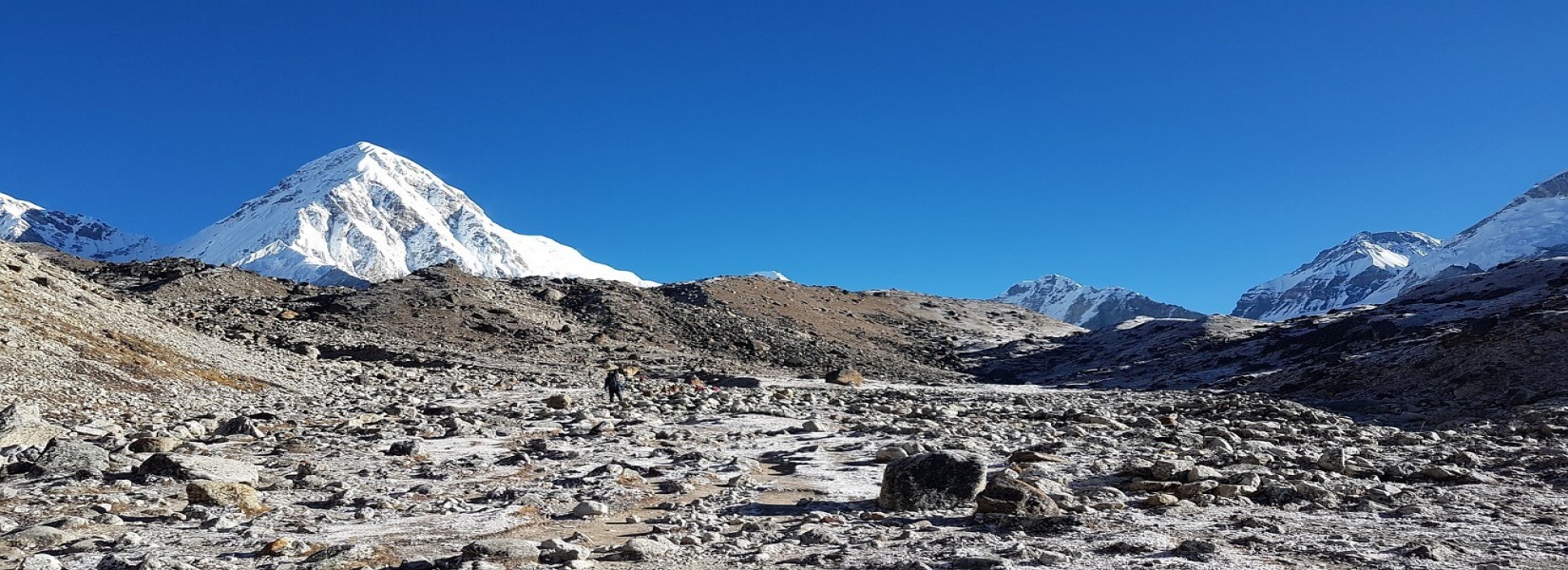
Everest Base Camp Trek Cost: A Comprehensive Breakdown
- You are here:
- Aug 9, 2023
Table of Contents
The Everest Base Camp Trek is a once-in-a-lifetime adventure that takes trekkers on a thrilling journey to the base camp of the world's highest peak, Mount Everest. Nestled in the breathtaking landscapes of the Himalayas, this trek offers an unforgettable experience for adventure enthusiasts and nature lovers alike. In this comprehensive guide, we will explore the cost breakdown of the Everest Base Camp Trek and why it's an incredible choice for your next adventure.
Before diving into the Everest Base Camp Trek cost details, let's get a brief overview of the Everest Trek. The journey begins in Lukla, where trekkers take a thrilling flight from Kathmandu to experience the dramatic mountain views. From Lukla, the trek gradually ascends through picturesque Sherpa villages, lush rhododendron forests, and serene river valleys.
As trekkers venture higher, they will encounter challenging terrains, suspension bridges, and rugged mountain trails. The final destination, Everest Base Camp, offers an awe-inspiring view of the majestic Khumbu Icefall and the towering peak of Mount Everest. The sense of accomplishment at reaching the base camp is unmatched.
Preparing for the trek
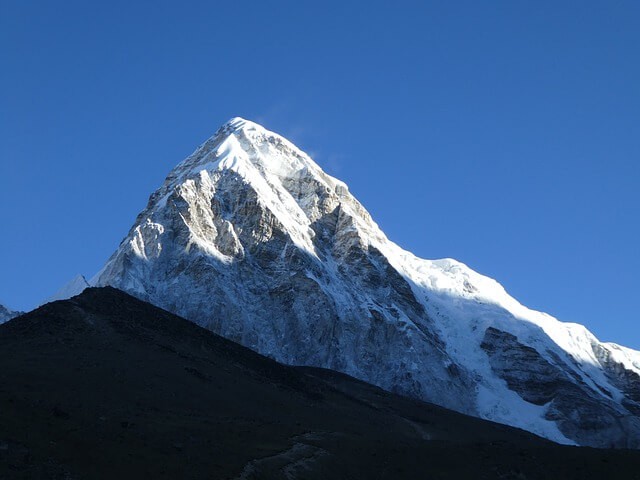
Embarking on the Everest Base Camp Trek requires careful preparation and research to ensure a successful and unforgettable adventure. Before setting foot on this iconic trek, understanding the journey and its associated costs is crucial. In this section, we'll delve into the essential steps to prepare for the Everest Base Camp Trek, including thorough research on the trek itself and its expenses.
The first step in preparing for the trek is to gain a comprehensive understanding of what the Everest Base Camp Trek entails. This involves studying the route, altitude, duration, and challenges you might encounter along the way. Conduct thorough research by reading guidebooks, consulting experienced trekkers, and exploring reputable online resources. Understanding the trek's demands will help you plan and train accordingly.
Trekking Seasons and Weather
Knowing the best time to undertake the Everest Base Camp Trek is crucial for a safe and enjoyable journey. The trek is primarily done in two main seasons: spring (March to May) and autumn (September to November) . During these periods, the weather is relatively stable, with clear skies and moderate temperatures. However, keep in mind that weather conditions in the mountains can be unpredictable, so being prepared for changes is essential.
Choosing the Right Trekking Package
Deciding between a guided or independent trek is an important consideration. While some trekkers opt for a self-guided journey to save costs, joining a guided trek can provide numerous advantages. Reputable trekking agencies offer guided packages that include permits, meals, accommodation, guides, and porters. Evaluate your budget and preferences to determine which option suits you best.
Cost Breakdown
Understanding the cost breakdown of the Everest Base Camp Trek is essential for budgeting and financial planning. As outlined in the previous section, the expenses involved include trekking permits and fees, travel expenses, guided trekking packages, accommodation and meals, gear and equipment, and miscellaneous expenses. Take time to assess each cost component and create a realistic budget accordingly.
Packing Essentials
Packing wisely is essential to ensure you have all the necessary items without carrying unnecessary weight. Key items include comfortable trekking clothing, sturdy hiking boots, a warm sleeping bag, a down jacket, trekking poles, a first aid kit, and high SPF sunscreen. Pack light but include all the essentials to make your trek enjoyable and safe.
Travel Insurance
Having comprehensive travel insurance is imperative for any adventure, and the Everest Base Camp Trek is no exception. Make sure your insurance covers high-altitude trekking and potential evacuation if needed. This safety net provides peace of mind and financial protection in case of unforeseen circumstances.
Everest Base Camp Trek Cost Breakdown
Everest base camp trek permits fees.
Before embarking on the iconic Everest Base Camp Trek, trekkers are required to obtain various permits to enter the Sagarmatha National Park and the Khumbu Pasang Lhamu Rural Municipality. These permits are essential for ensuring the safety of trekkers and preserving the natural beauty and cultural heritage of the region.
1. Sagarmatha National Park Entry Permit
The Sagarmatha National Park, a UNESCO World Heritage Site, is a protected area that trekkers must pass through during the journey to Everest Base Camp. To enter the park, you need to obtain a Sagarmatha National Park Entry Permit. This permit costs around $30 USD and can be obtained from the Nepal Tourism Board office in Kathmandu or from the park entrance in Monjo.
2. Khumbu Pasang Lhamu Rural Municipality Entry Permit
In addition to the national park permit, trekkers are also required to obtain a Khumbu Pasang Lhamu Rural Municipality Entry Permit. This permit costs approximately $20 USD and is necessary for trekking in the Khumbu region, which includes popular stops like Namche Bazaar and Tengboche.
It's important to note that these permits are non-transferable and non-refundable. Trekkers are required to carry these permits with them at all times during the trek, as they may be checked at various checkpoints along the trail.
Everest Base Camp Trek Transportation Costs
There are mainly two options to reach Lukla or Phakding the starting point for the Everest Base Camp Trek which are:
By Air: Lukla flights and helicopter
Once in Kathmandu, trekkers head to Lukla, a small town in the Everest region, to begin the trek. Lukla is inaccessible by road, so the most common and convenient mode of transportation is by air.
The flight from Kathmandu to Lukla takes approximately 30 to 35 minutes, offering breathtaking views of the Himalayan peaks. The cost of the round-trip flight can range from $370 to $390 USD , depending on the airline and season. It's recommended to book these flights in advance, especially during peak trekking seasons when demand is high.
Note: During the peak season (March, April, and October, November Lukla flights cannot be operated directly from Kathmandu due to high air traffic. Hence all the flights are operated from Ramechhap Manthali Airport.
For those seeking a more luxurious and time-efficient option, helicopter charters are available to reach Lukla. Helicopter flights offer stunning aerial views of the Himalayas and significantly reduce travel time. However, this option can be quite expensive and may not be viable for all travelers.
The other option is by ground transportation more adventurous and budget-friendly approach is to travel overland from Kathmandu to Jiri, a town in the Solukhumbu district, and then trek to Lukla. The Jiri to Lukla trek, also known as the Classic Everest Base Camp Trek, takes approximately 6 to 8 days and offers a chance to experience the scenic beauty of the lower Solukhumbu region.
The most common modes of transportation from Kathmandu to Jiri are buses and shared jeeps. Buses are more affordable but may take longer due to frequent stops and road conditions. Shared jeeps are faster but may cost slightly more.
Bus Cost: The cost of a bus ticket from Kathmandu to Jiri ranges from $8 to $15 USD per person.
Shared Jeep Cost: A seat in a shared jeep may cost between $15 to $25 USD per person .
The overland journey from Kathmandu to Jiri typically takes around 8 to 10 hours, depending on road conditions and weather. The route covers approximately 190 kilometers (118 miles).
Everest Base Camp Trek Accommodation Costs
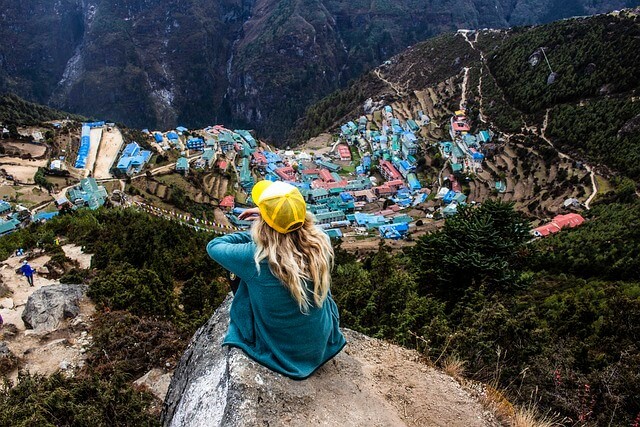
Accommodation costs for the Everest Base Camp Trek vary depending on the location and level of comfort.
In Kathmandu, trekkers can find budget guesthouses in Thamel, costing around $30 to $40 USD per night, while mid-range hotels and boutique accommodations range from $50 to $150 USD per night . For a more luxurious stay, luxury hotels and resorts offer top-notch facilities at prices starting from $200 to $500 USD per night or higher.
During the trek, accommodation is provided at tea houses along the trail. Lower-altitude tea houses in places like Phakding and Namche Bazaar may cost $20 to $40 USD per night, while higher-altitude tea houses in Dingboche and Lobuche could range from $40 to $80 USD per night.
At Everest Base Camp, trekkers have the option of staying in tents provided by guided trek agencies, with the cost of tent accommodation included in full-service packages, which can cost between $1,200 to $2,500 USD depending on the agency and inclusions. It's important to book accommodation in advance, especially during peak trekking seasons, to ensure a comfortable and enjoyable journey to the base of the world's highest mountain.
Everest Base Camp Trek Food Costs
When preparing for the Everest Base Camp Trek, it's essential to consider food and drink expenses as part of your budget. Let's break down the costs for meals in Kathmandu, food and drinks on the trek, and budgeting for snacks and extra nourishment.
Meals in Kathmandu:
Kathmandu offers a diverse range of dining options catering to different tastes and budgets. Budget travelers can find local eateries and street food stalls offering traditional Nepali dishes and international cuisine at affordable prices. A typical meal in a local restaurant may cost around $5 to $10 USD. For mid-range and luxury travelers, there are restaurants and cafes serving a wide variety of cuisines at prices ranging from $10 to $30 USD per meal.
Food and Drinks on the Trek:
During the Everest Base Camp Trek, trekkers will be staying at tea houses along the trail. These tea houses offer meals and beverages to keep trekkers nourished and hydrated. The cost of food at tea houses varies depending on the location and altitude. On average, meals at tea houses may cost $10 to $15 USD per meal . Tea houses also offer hot drinks such as tea, coffee, and hot chocolate at reasonable prices, usually around $2 to $5 USD per cup .
Budgeting for Snacks and Extra Nourishment:
While meals at tea houses are included in guided trek packages, trekkers should budget for snacks and extra nourishment during the trek. Snacks such as energy bars, nuts, and dried fruits can be purchased at tea houses or brought from Kathmandu. Budget around $5 to $10 USD per day for snacks and extra nourishment to keep your energy levels up during the challenging trek.
To manage food and drinks expenses effectively, it's advisable to carry some cash in Nepali rupees. While some tea houses accept credit cards, they may charge extra fees for transactions. Proper budgeting for food and drinks ensures you have a satisfying culinary experience throughout the trek and helps you focus on the breathtaking landscapes and the exhilarating journey to Everest Base Camp.
Everest Base Camp Trek Cost: Gear and Equipment
When embarking on the Everest Base Camp Trek, having the right trekking gear and equipment is crucial for a safe and comfortable journey. Let's explore the essential gear checklist, the pros and cons of renting vs. buying trekking gear, and the costs of gear rental.
Essential Gear Checklist:
Before starting the trek, trekkers should ensure they have the following essential gear:
Trekking Boots: Sturdy, comfortable trekking boots with ankle support are essential for rugged mountain trails.
Trekking Pants and Shirts: Lightweight, moisture-wicking clothing for easy movement and comfort during the trek.
Insulated Jacket: A warm and waterproof insulated jacket to stay protected from cold and unpredictable weather.
Sleeping Bag: A good quality sleeping bag suitable for cold temperatures in the mountains.
Daypack: A small backpack to carry essentials like water, snacks, and personal items during daily treks.
Trekking Poles: Optional but helpful for stability and reducing strain on knees during steep descents.
Headlamp or Flashlight: Essential for navigating in the dark, especially in early morning or evening treks.
First Aid Kit: A basic first aid kit with essential medications and supplies for emergencies.
Water Bottle and Purification Tablets: A reusable water bottle and water purification tablets to stay hydrated throughout the trek.
Sunscreen and Sunglasses: Protection from the intense mountain sun and UV rays.
Renting vs. Buying Trekking Gear:
Trekkers have the option to rent or buy trekking gear. Renting is a suitable choice for those who do not trek frequently or wish to travel lightly. It allows you to avoid the hassle of carrying bulky gear to and from Nepal. On the other hand, buying trekking gear is more beneficial for regular trekkers or those who prefer to have their gear tailored to their needs and preferences.
Costs of Gear Rental:
The costs of gear rental can vary based on the quality and duration of the rental. Here are approximate rental costs for some essential items:
Trekking Boots : $1 to $2 USD per day
Sleeping Bag: $1 to $2 USD per day
Down Jacket: $1 to $2 USD per day
Trekking Poles: $1 to $2 USD per day
Daypack: $1 to $2 USD per day
Overall, the cost of renting trekking gear for the entire duration of the Everest Base Camp Trek can range from $50 to $100 USD , depending on the rental period and the quality of the gear.
For those who prefer to buy their trekking gear, the average cost can be higher, ranging from $300 to $500 USD or more. Buying gear allows trekkers to invest in high-quality, personalized items that can be used for multiple treks in the future.
Before renting trekking gear, it's advisable to inspect the items for any damages or wear and tear. Additionally, carrying a few essential personal items like trekking clothes, socks, and underwear is recommended to maintain hygiene and comfort during the trek.
Everest Base Camp Trek Cost of Hiring Guide and Porter
Hiring guides and porters for the Everest Base Camp Trek offers numerous benefits, especially for trekkers with limited experience in high-altitude trekking or those seeking a more enjoyable and stress-free journey.
The cost of hiring a guide for the Everest Base Camp Trek can vary based on factors such as experience, language proficiency, and the level of service provided. On average, the daily fee for a licensed guide can range from $20 to $40 USD. The cost is often lower when booking a guided trek package that includes accommodation, meals, permits, and transportation.
Porters on the other hand play a vital role in carrying trekkers' belongings during the trek. Their wages and tips are an essential aspect to consider when hiring them.
Porters' Wages: Porters' wages t ypically range from $15 to $25 USD per day , depending on the weight they carry and the distance covered.
Tipping Note: Tipping is customary in the trekking industry as a token of appreciation for hard work. It is recommended to tip around 10% - 15% of the overall trip cost, as a gesture of gratitude.
It's important to treat both guides and porters with respect and ensure they are adequately equipped for the trek with proper clothing and gear. Additionally, booking through reputable trekking agencies ensures fair wages and ethical treatment of guides and porters.
Travel insurance is a vital aspect of preparing for the Everest Base Camp Trek or any adventure travel. It provides financial protection and peace of mind in case of unexpected events and emergencies that can occur during the journey.
- Medical Emergencies
- Trip Cancellation and Interruption
- Baggage Loss or Delay
- Emergency Evacuation
The coverage and costs of travel insurance can vary depending on the insurance provider, the level of coverage chosen, the duration of the trip, and the traveler's age and medical history.
Coverage: A comprehensive travel insurance policy typically includes medical coverage for accidents and illnesses, emergency medical evacuation, trip cancellation/interruption, baggage loss, and personal liability coverage.
Costs: The cost of travel insurance for the Everest Base Camp Trek can range from $100 to $500 USD or more, depending on the factors mentioned above. Premiums may be higher for older travelers or those with pre-existing medical conditions.
When choosing travel insurance, it's essential to carefully read and understand the policy terms, coverage limits, and exclusions. Look for insurance providers that specialize in adventure travel or trekking insurance, as they are more likely to offer appropriate coverage for the specific challenges and risks of high-altitude trekking.
Contingency and Emergency Expenses
When preparing for the Everest Base Camp Trek, it's crucial to allocate a portion of the budget for contingency and emergency expenses. Despite careful planning, unforeseen situations can arise during the trek, and having a financial safety net can provide peace of mind and ensure trekkers are prepared for any eventuality.
Weather-Related Delays: Adverse weather conditions, such as heavy snowfall or storms, can lead to flight cancellations or delays, affecting the trek itinerary. Budgeting for additional accommodation and meals in case of unexpected delays is prudent.
Altitude Sickness: Altitude-related illnesses can affect trekkers, especially at higher elevations. In case of altitude sickness, additional acclimatization days or a change in the trekking itinerary might be necessary, leading to extra expenses.
Extra Nights in Tea Houses: Trekkers may choose to spend an extra night at a tea house to rest or acclimatize, or they may decide to take a detour to explore a nearby attraction. Having funds available for such unplanned situations ensures flexibility and comfort during the trek.
Emergency Evacuation Costs:
In the event of a severe medical emergency or injury during the Everest Base Camp Trek, emergency evacuation might be required to transport the affected trekker to a medical facility with proper care. Emergency evacuation in the Himalayas often involves helicopter rescue due to the challenging terrain and lack of immediate road access.
Cost of Emergency Evacuation: Emergency helicopter evacuations in the Everest region can be expensive, ranging from $5,000 to $10,000 USD or more, depending on the distance and location of the evacuation.
Travel Insurance Coverage: As mentioned earlier, having comprehensive travel insurance that includes emergency medical evacuation is crucial. Travel insurance covers the cost of emergency helicopter rescue and transportation to a medical facility, ensuring that trekkers receive timely and life-saving medical attention.
To budget for contingency and emergency expenses, trekkers should consider the cost of additional accommodation, meals, and unforeseen circumstances. It's also essential to invest in a reputable travel insurance policy that specifically covers high-altitude trekking and includes emergency evacuation coverage.
Saving Tips and Strategies
- Tea House Accommodation: Choose budget-friendly tea houses for accommodation and meals.
- Shared Accommodation: Share a room with fellow trekkers to split the costs.
- Meal Choices: Opt for local Nepali dishes and vegetarian meals.
- Refill Water Bottles: Use purified water available at tea houses or use purification tablets.
- Group Trekking: Consider joining a group trek organized by a reputable agency.
- Self-Guided Option: Choose a self-guided option for experienced trekkers.
- Trekking Permits: Obtain necessary permits directly from authorized offices.
Everest Base Camp Trek Cost, Currency, and Payment Methods:
When traveling to Nepal for the Everest Base Camp Trek, it's essential to be familiar with the recommended payment methods and currency exchange tips to manage expenses effectively. Here are some key points to consider:
Recommended Payment Methods:
Nepalese Rupee (NPR): The official currency of Nepal is the Nepalese Rupee (NPR). It is advisable to carry some Nepalese rupees in cash for small purchases and expenses in local markets or remote areas where card payments may not be accepted.
Cash : Cash is widely accepted in most places, especially in rural areas and tea houses along the trek. It's recommended to carry a mix of small and large denominations to facilitate transactions.
Credit and Debit Cards: Major cities like Kathmandu and Namche Bazaar have ATMs where international debit and credit cards can be used to withdraw cash. However, it's essential to inform your bank about your travel plans to avoid any issues with card transactions.
Traveler's Checks: Traveler's checks are not widely accepted in Nepal, and it can be challenging to find places that cash them. It's best to rely on cash and cards for transactions.
Mobile Payment Apps: Some establishments in urban areas may accept mobile payment apps like eSewa or Khalti. However, these are not as commonly used as cash or cards.
Currency Exchange Tips:
Exchange at Authorized Places: Exchange currency at authorized banks, exchange counters, or ATMs to get the best rates. Avoid exchanging money with unauthorized individuals or street vendors.
US Dollars: US dollars are widely accepted in Nepal, especially in touristic areas. It's useful to carry some US dollars in case of emergencies or for major transactions.
Avoid Exchanging at the Airport: The exchange rates at airports are often lower than those at banks or exchange counters in the city. It's better to exchange a small amount at the airport and then find a better rate in town.
Check Exchange Rates: Before exchanging money, check the current exchange rates to ensure you get a fair deal.
Save Exchange Receipts: Retain exchange receipts as they may be required to convert excess Nepalese rupees back to your home currency upon departure.
Use Local Currency for Purchases: When making purchases, especially in local markets and tea houses, use Nepalese rupees to avoid unfavorable exchange rates and additional charges for foreign currency transactions.
Total Estimated Cost of Everest Base Camp Trek:
Considering the above expenses and factors, the total estimated cost of the Everest Base Camp Trek can range from $1,200 to $5,000 USD or more, depending on various choices and preferences made by the trekker. Proper budgeting, wise spending choices, and investment in essential services like travel insurance ensure a safe, enjoyable, and memorable trekking experience in the stunning Himalayas.
At Nepal Spirit Adventure, we are thrilled to offer you an unforgettable 14-day all-inclusive Everest Base Camp Trek at a competitive price of $1290 USD per person. Our well-crafted trekking package ensures you have a remarkable and hassle-free journey to the base of the world's highest peak, Mount Everest.
In conclusion, the Everest Base Camp Trek is a once-in-a-lifetime adventure that offers trekkers the opportunity to immerse themselves in the mesmerizing beauty of the Himalayas and stand in awe of the majestic Mount Everest. This comprehensive Everest Base Camp Trek Cost guide has provided valuable insights into the various aspects of the trek, from the introduction to the trekking permits, costs, and essential gear.
Preparing for the Everest Base Camp Trek requires careful planning, budgeting, and consideration of various factors, including transportation, accommodation, food, and trekking gear. Hiring guides and porters, as well as having travel insurance, ensures a safe and enjoyable journey.
So, if you are ready to embark on a life-changing journey filled with breathtaking landscapes, cultural encounters, and a sense of achievement, take the first step towards your Everest Base Camp Trek and make your dream a reality!
- Everest base camp trek
Quick Inquiry
Recent post.
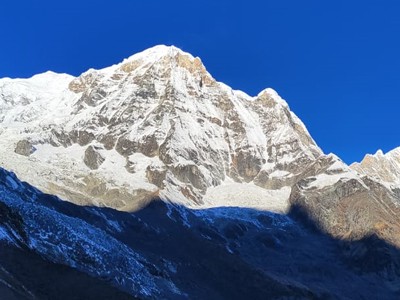
Complete Guide Trek Annapurna Base Camp
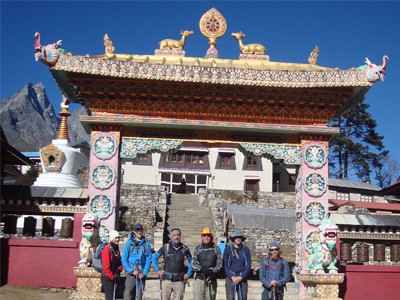
Tengboche Monastery in Khumbu
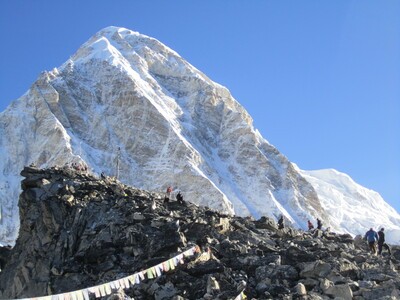
How Long is Perfect for Everest Base Camp Trek
Related posts.
- Manaslu Circuit Trek Best Time
- Manaslu Circuit Trek Permits
- Crossing the highest Thorong La Pass
- How to Reach the Everest Base Camp: A Trekker's Guide
- Can I trek solo in Manaslu Circuit Trek?
- Top 7 easy treks for beginners in Nepal
- Preparing for Success: Fitness and Training Tips for the Everest Base Camp Trek
- Everest Base Camp Trek Permits: New Update & Costs
- Everest Base Camp Trek
- Nepal Trekking Season
- News and Events
- Travel & Trekking
- Travel News
- Travel Trekking Insurance
- Trek and Festival
- Trekking and Tour
- Why Everest Trek in October

Annapurna Circuit Trek
Planning to trek the annapurna circuit in nepal a great decision here's everything you need to know before your annapurna trek, including trekking permits, hiking solo vs in a group, what to pack, when to go, and all the money matters..
Annapurna Circuit Trek is a popular classic trek of Nepal. Each year, more than 60,000 trekkers come for this trek from all around the globe. In this trek, you encircle the Annapurna massif and cover between 110-130 miles by walking.
The Annapurna Circuit trek usually takes about 14–21 days, leaving from Kathmandu with a stopover in Pokhara before returning to the capital. The trail is moderate to fairly challenging and makes numerous river crossings over steel and wooden suspension bridges.
Our 19 days Annapurna Circuit Trek begins from Besisahar. You begin your trek alongside Marshyangdi river all the way to its waterhead beyond Annapurna range. You then enter into Manang, cross the famous Thorong La Pass (5,416 m) and go down to the restricted region of Mustang.
After visiting some popular settlements of this semi desert-like region, you travel a few hours in a bus and trek to Poon Hill viewpoint.
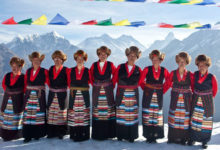
Annapurna Circuit Itinerary has often been voted as the best long-distance trek in the world, as it combined, in its old full form, a wide variety of climate zones from tropics at 600 m asl to the arctic at 5416 m asl at the Thorong La pass and cultural variety from Hindu villages at the low foothills to the Tibetan culture
There are two types of trekking permit required by anyone wishing to do the Annapurna Circuit trek. No matter when or how you’re hiking the Annapurna Circuit, you’ll need to organise both a Trekking Information Management System (TIMS) permit, and an Annapurna National Park Permit (sometimes also known as the Annapurna Conservation Area Permit).
As of 2019, the permits should set you back about USD $50 total: the APC Permit is USD $30 / NPR 3,000 per person, while the TIMS Permit is USD $20 / NPR 2,000 per person.
Since the trail opened in 1977, most trekkers have followed an Annapurna Circuit itinerary that begins in Besishahar and heads in an anti-clockwise direction over the Thorong-La Pass and down into the Jomsom Valley.
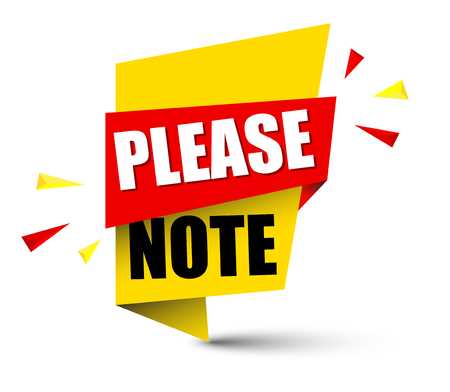
Special Note for Annapurna Circuit Trek
Facts about annapurna circuit trek:, annapurna circuit trek highlights.
- The peaceful and pristine nature trip.
- Witness stunning views of Annapurna, Lamjung Himal, Dhaulagiri, Nilgiri and more.
- Stay in tea-houses of small villages.
- Cross highest pass – Thorong La Pass(5,416m).
- Visit Muktinath, other holy temples, and monasteries.
- Explore beautiful villages of Braga, Manang, Kagbeni, Jomsom, and Marpha.
- Gaze at the breathtaking Annapurna range from Poon Hill.
- Natural Hot spring at Tatopani.
- Enjoy the lively evening of Pokhara.
- International & domestic airport transfers as per the itinerary.
- 2 nights accommodation in Kathmandu with Bed and Breakfast plan.
- 2 nights accommodation in Pokhara with Bed and Breakfast plan.
- 18 breakfast, 14 Lunch, 15 dinner during the trip.
- Kathmandu Sightseeing by professional English speaking tour guide.
- Kathmandu – Pokhara – Kathmandu domestic flight.
- Pokhara – Jomsom – Pokhara Flight.
- 3 meals a day during the trip (Breakfast, Lunch & Dinner) as mention in itinerary.
- Accommodation while trekking in twin sharing basis in guesthouses.
- Annapurna conservation area permit and TIMS card.
- Upper Mustang Restricted area permit fee.
- Professional government license holder English speaking trekking guide.
- Sleeping bag and duffel bag during the trek. (Refundable after finish the trip)
- Medical supplies (first aid kit will be available).
- 1 farewell dinner in Kathmandu
- All government and local taxes.
- All entrance fees for sightseeing places
- Alcoholic, hot and cold drinks.
- Your international flights
- Nepal visa fees & airport taxes
- Personal travel insurance (strongly recommended)
- Gear or equipment for your trek
- Personal expenses along the trek
- Tiji Festival Camara fees, and other donation
- If you would like to ride on pony
- Tips for your city guide, drivers, hotels, restaurants, etc.
- Extra night accommodation then mention plan
How difficult is the Annapurna Circuit Trek?
Is annapurna circuit dangerous, do i need a sleeping bag for annapurna circuit, is there any luggage limit for porter, do i need vaccinations for this trip.
When to Go Annapurna Circuit
Monsoon season in Nepal is June through September. That’s when most of the rain falls and when rock and mudslides are most likely to occur. The spring, between mid-March and mid-April, is when the rhododendron forests bloom, but the weather is still wet this time of year and the leeches are a nuisance at lower elevations.
The best time to do the Annapurna Circuit is October, thanks to reliably pleasant weather (80°F and humid at 2,000 feet; 20°F and dry at 17,000 feet) and clear skies.
Annapurna Circuit Trek Difficulty
The path reaches its highest point at Thorung La pass (5416m/17769 ft), touching the edge of the Tibetan plateau. Practically all trekkers hike the route anticlockwise, as this way the daily altitude gain is slower, and crossing the high Thorong La pass is easier and safer.
To be very blunt about it, Annapurna Circuit Trek difficulty level is quite challenging. What make the Annapurna Circuit trek difficulty level so tough is the high altitude that the route covers. The trekking route takes you as high as 5416 m, which is the height of Thorung La, the highest altitude pass in the region.
Accommodation, Food And Drink Facility
All guesthouses have blankets you always can ask for an extra one or two if it’s really cold. You had light summer sleeping bags but most of the time slept without them under the blankets. Even at Thorung Phedi where it will quite cold, you sleep in warm clothes under two blankets.
The facilities at higher altitudes e.g. Thorong Phedi and High Camp are more basic no power outlets in the room, no or very poor wi-fi, no hot shower, etc., to charge your phone or to use wi-fi you pay extra.
All guesthouses are more or less the same there are no fancier hotels to stay on the route like in Pokhara or Kathmandu. Rooms are very basic usually they have two single beds, blankets, sometimes a table and a chair.
Most of the time hikers sit in the dining area it’s the warmest place in a guesthouse; people drink tea, play cards, talk, etc. You go to your room only at night.
Nepal Annapurna Circuit Trek | Documentary
Getting travel insurance
The Annapurna Circuit is a high altitude trek through remote and difficult to access areas of Nepal having travel insurance is highly recommended. In fact, it’s required for getting the hiking permit. Nobody has ever asked us to show our insurances but when you fill the form they ask you to provide the name and the phone number of your insurance company.
There are many insurance company but we’d recommend using one that has experience in covering outdoor activities and working in the region like World Nomads. Nepal is one of their top hiking destinations with thousands of people buying World Nomads insurance policies for trekking here so they know local specific.
Book with Local Operator
Whether it’s a cultural tour, gentle walking holiday or strenuous trek, our holidays in Nepal are led by professionally-trained English speaking leaders. They have an intimate and expert knowledge of the history, culture and nature of Nepal and will make your trip a memorable experience. Thus hurry up and reserve your place to Annapurna Circuit Trek.
Kulendra Baral
Let's stay updated, subscribe my newsletter for new blog posts, tips & new photos., pokhara sightseeing tour, annapurna region, related articles.
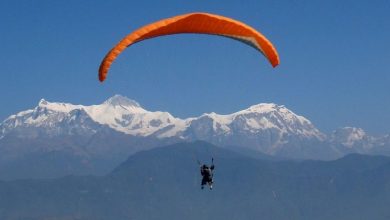
Paragliding
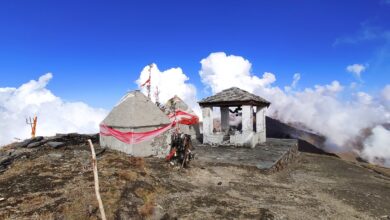
Khaptad National Park Trek
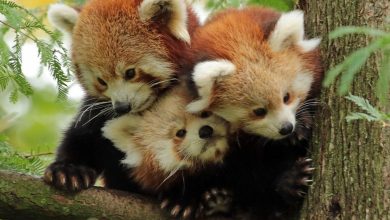
Langtang Region
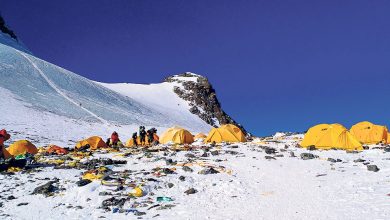
Mountaineering Royalty Nepal
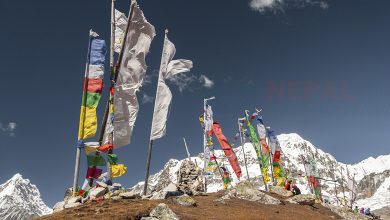
Langtang Valley Trek
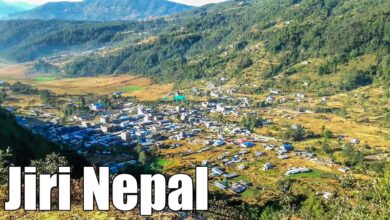
Jiri to Everest Base Camp Trek
Leave a reply cancel reply.
You must be logged in to post a comment.
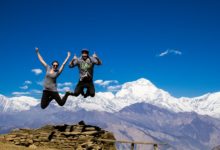

- Everest Region
- Annapurna Region
- Manaslu Region
- Langtang Region
- Makalu Region
- Kanchenjunga Region
- Dolpo Region
- All Tours and Activities
- Nepal Trekking
- Nepal Yoga Retreat
- Nepal Cultural Tour
- Nepal Climbing
- Nepal Heli Tour
- Nepal Jungle Safari
- Everest Flight Tour
- Spa Package in Kathmandu
- Nepal Biking Tour
- Nepal River Rafting
- The Life and Legacy
- About Nepal Hiking
- Official Documents
- Vision Statement
- Responsible Travel
- Testimonials
- Tailor Made Holidays
- Become a Partner
- Terms & Conditions
- Privacy Policy
Nepal Everest Base Camp Trek Cost: An In-Depth Guide to Financial Planning for Your Trip
Estimated reading time: 8 minutes
Embarking on a Nepal Everest Base Camp trek is a once-in-a-lifetime adventure that requires careful planning, especially regarding budgeting. Although the breathtaking views and the feeling of achievement are invaluable, comprehending the expenses associated with the trek is crucial for a successful and fulfilling experience. In this detailed guide, we examine the costs of the Everest Base Camp trek, offering an extensive overview of the expected expenses and advice on effective budgeting strategies.
Various factors must be considered when estimating the overall cost of your Everest Base Camp trek, from permits and flights to accommodation and meals. We will delve into each cost comprehensively, providing insights, advice, and suggestions to assist you in making well-informed choices.
Whether you’re a seasoned traveller or a first-time trekker, this guide will equip you with the knowledge to plan and budget for your Everest Base Camp adventure. So, whether you’re dreaming of conquering the world’s highest peak or simply seeking a thrilling hiking experience, read on to learn all you need to know about the cost of trekking to Everest Base Camp.
Table of Contents
Factors influencing the cost of Nepal Everest Base Camp Trek
Several factors must be considered when estimating the cost of an Everest Base Camp trek. These elements can differ based on your preferences, travel habits, and the comfort you desire on your trip. Grasping these aspects will aid you in forming a realistic budget and prevent unexpected expenses during your journey.
One of the most significant factors influencing the cost is the time of year you choose to trek. The peak trekking seasons, including spring (March to May) and autumn (September to November), are more expensive due to high demand. On the other hand, embarking on your trek in the off-peak periods, like winter (December to February) or the monsoon season (June to August), could lead to reduced expenses.
Another factor to consider is the duration of your trek. The standard Everest Base Camp trek takes around 12 to 14 days to complete, but some trekkers choose to extend their journey by exploring additional trails or acclimatizing for longer periods. Remember that the lengthier the trek is, the greater the total cost will be, owing to extra expenses for accommodation and meals.
Additionally, the level of comfort you desire during your trek will impact the cost. Three main options are teahouse trekking, basic camping, and luxury trekking. Teahouse trekking involves staying in local lodges along the trail, while basic camping requires carrying your camping gear. Luxury trekking offers more comfortable accommodations and amenities but comes at a higher price.
Pre-trip expenses: Flights, permits, and visas
Several pre-trip expenses must be considered before embarking on your Nepal Everest Base Camp trek. The most significant expense is usually the flight to Nepal.
Flight prices can fluctuate depending on your starting point, the season, and the selected airline. It’s recommended that you reserve your flights early to take advantage of the most favourable rates.
In addition to flights, you’ll need to obtain the necessary permits and visas. All trekkers require a TIMS (Trekkers’ Information Management System) card, which costs around USD 20. You’ll also need a Sagarmatha National Park entry permit, which costs USD 30. Additional permits may be required if you plan to trek in other areas of Nepal.
Nepal visas are available upon arrival at Tribhuvan International Airport in Kathmandu. The cost of a tourist visa depends on the duration of your stay, ranging from USD 30 for 15 days to USD 125 for 90 days. Verifying the most recent visa prerequisites and charges before your journey is crucial to guarantee hassle-free entry into Nepal.
Trekking expenses: Accommodation, food, and water in Nepal Everest Base Camp Trek
During your Everest Base Camp trek, accommodation, food, and water will be your primary daily expenses. Teahouses and simple lodges along the trail provide accommodation for trekkers. The price for staying in a teahouse can vary between USD 10 to USD 60 per night, based on its location and the standard of comfort provided.
Meals in teahouses are usually provided in the dining area and consist of local dishes such as dal bhat (rice and lentils) and momos (dumplings).
Typically, a meal costs between USD 10 and USD 20, but be aware that food and water costs rise at higher altitudes, reflecting the difficulties in transporting supplies to these remote locations. Bottled water is an option on the trail, though it can be costly and not eco-friendly. A more sustainable and budget-friendly choice is to purify water from natural sources using tablets or a water filter. This approach cuts down on expenses and minimizes plastic waste during your trek.
Hiring a guide and porter: Costs and benefits for Nepal Everest Base Camp
While it’s possible to trek to Everest Base Camp independently, many trekkers choose to hire a guide and porter. A guide can provide valuable insights, navigation assistance, and cultural information, enhancing your overall experience. A porter, meanwhile, takes on the burden of your heavy backpack, making your hike lighter and more energy-efficient.
The cost of hiring a guide and porter depends on the length of your trek and the services they provide. Typically, a guide might charge about USD 30 to USD 50 daily, and porter fees usually range from USD 25 to USD 40 daily. Engaging them through a reputable agency ensures their fair treatment and well-being.
Equipment and gear: Purchasing or renting options for Base Camp Trek
You must have the necessary equipment and gear before setting off your Nepal Everest Base Camp trek. Purchasing new gear can add up quickly, so it’s worth considering renting equipment if you’re on a budget or don’t plan on trekking frequently.
Necessary gear comprises a high-quality backpack, hiking boots, layers of warm clothing, a sleeping bag, and a down jacket. These items can be rented in Kathmandu or Namche Bazaar, the gateway to the Everest region. Renting equipment can save you money and valuable luggage space, but inspect the gear for any damages or defects before starting your trek.
Additional expenses: Travel insurance and emergency funds
Securing travel insurance encompassing medical emergencies, evacuation, and trip cancellation is critical to preparing for an Everest Base Camp trek.
Insurance costs can fluctuate depending on age, coverage length, and chosen level of protection. It’s imperative to thoroughly review the policy details to confirm that you have sufficient coverage for your trek.
Moreover, allocating a portion of your budget for unforeseen expenses is wise. These could include extra nights’ stay due to delays, medical treatments, or travel costs. An emergency fund is a financial safeguard, offering reassurance and readiness for unexpected occurrences on your journey.
Cost-saving tips during the Nepal Everest Base Camp Trek
Although the trek to Everest Base Camp may require a substantial financial commitment, various money-saving strategies can help you stick to your budget. Consider the following suggestions to make your journey more affordable without compromising on safety or experience:
1. Travel during the off-peak seasons:
Trekking during the monsoon or winter can lower flight costs, accommodation, and permits.
2. Join a group trek:
Participating in a group trek can help reduce costs as expenses such as guide and porter fees can be shared among the group.
3. Bring your snacks:
Carrying energy bars, nuts, and dried fruits can help you save money on snacks along the trail.
4. Skip unnecessary luxuries:
Opt for teahouse accommodation instead of luxury lodges, and choose simple meals over expensive dishes to save money.
5. Negotiate prices:
When hiring a guide and porter or purchasing equipment, don’t hesitate to negotiate prices to get the best deal.
Alternative routes and budget options Nepal Everest Base Camp
If you’re looking for more budget-friendly options or want to explore alternative routes to Everest Base Camp, consider several alternatives. The Gokyo Lakes and Three Passes trek offer equally stunning landscapes and breathtaking views of the Everest region but with fewer crowds and lower costs.
The Gokyo Lakes journey leads you through the stunning Gokyo Valley, where you’ll find mesmerizing turquoise lakes and sweeping vistas of Everest, Cho Oyu, and Lhotse. In contrast, the Three Passes trek is a more demanding path traversing three high mountain passes, offering unmatched perspectives of the Everest landscape.
These treks offer unique experiences and can be completed at a lower cost than the traditional Everest Base Camp route. They are excellent alternatives for trekkers looking to explore less crowded trails while still enjoying the beauty of the Himalayas.
Conclusion: Planning your budget for an unforgettable Nepal Everest Base Camp Trek experience
Plan your Everest Base Camp trek meticulously to ensure a fulfilling experience without overspending. Calculate expenses, book in advance, and make informed decisions on guides, equipment, and insurance. For a touch of luxury in Kathmandu, consider Hotel Kathmandu Suite Home . Start budgeting today for an unforgettable journey to the roof of the world!
Other Links
- Annapurna Base Camp Trek Cost: How to Plan Your Budget without Breaking the Bank
- Unveiling the Sherpa Legacy: Exploring the Everest Base Camp
- Kathmandu – Lhasa Tour (Drive in / Drive out)
- Helicopter tour in Nepal
Latest News and Articles
Nepalhiking on news sites, stay updated with the latest news and exclusive offers, proceed booking, already a member, don't have an account create one., or continue as guest.

- Nepal Trekking Costs
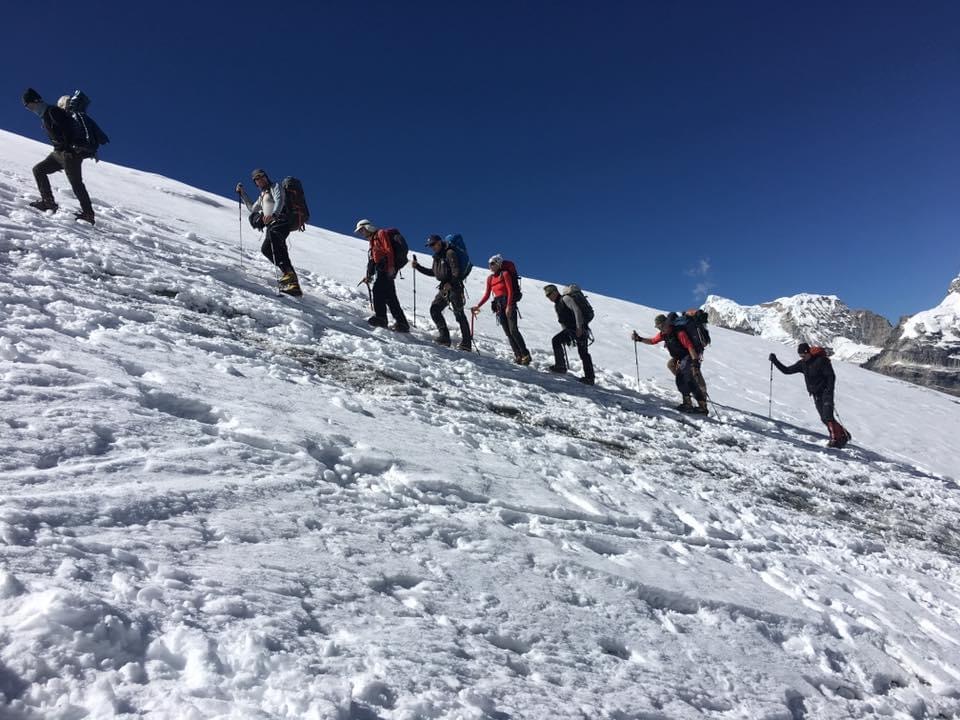
Nepal Trekking Cost for The most popular Trekking Route in Nepal
1. Everest Base Camp Trekking - US Dollor 1299
2. Annapurna Bass Camp Trekking-US Dollor 799
3. Poon Hill Treeking -US Dollor 399
4. Langtang Trekking-US Dollor 699
5. Mardi Himal Trekking- US Dollor 599
6. Pikey Peak Trekking -US Dollor 699
7. Manaslu Trekking- US Dollor 1199
8. Mustang Trekking-US Dollor 699
9. Mohare Danda Trekking- US Dollor 499
10. Nepal Trekking-US Dollor 599
Have you ever been to Nepal or thinking about going? If you haven't, then you are missing a very important place of earth. Nepal is a prime destination for an adventure lovers, mountaineers, climbers and spiritual experiences. Not only does Nepal offer adventure, but also friendly people, unique culture, various languages and marvellous experiences all offered in Lord Buddha's country Nepal. The tiny Himalayan nation offers you a unique holiday experience, including. Nepal trek , Nepal tour , Peak climbing and many others.
Nepal is suitable for anybody searching for any kind of experience. Most popular activities in Nepal are Everest Base Camp trek , Annapurna Base Camp trek , Langtang trek , Manaslu trek , Kathmandu Valley tour, Kathmandu Pokhara tour, Mera Peak climbing, Island Peak climbing and so on. If you are interested in experiencing one or all activities, Nepal Trek Hub is your right choice.
Nepal Everest Himalaya Hiking - A Nepal Trekking Company is Female Sherpa Trekking Guide Owned and Operated Registered Trekking Organizer Company based in Nepal & Official member of Trekking Agencies' Association of Nepal (TAAN) that works together for woman empowerment providing employment opportunities to female trekking guide to make their better life in Himalaya. We team of experienced Sherpa Guides from Everest Himalaya are dedicated in providing with you Best Trekking for the year 2023 and 2024. Copyright ©2023- Nepal Everest Himalaya Hiking -A Nepal Trekking Company
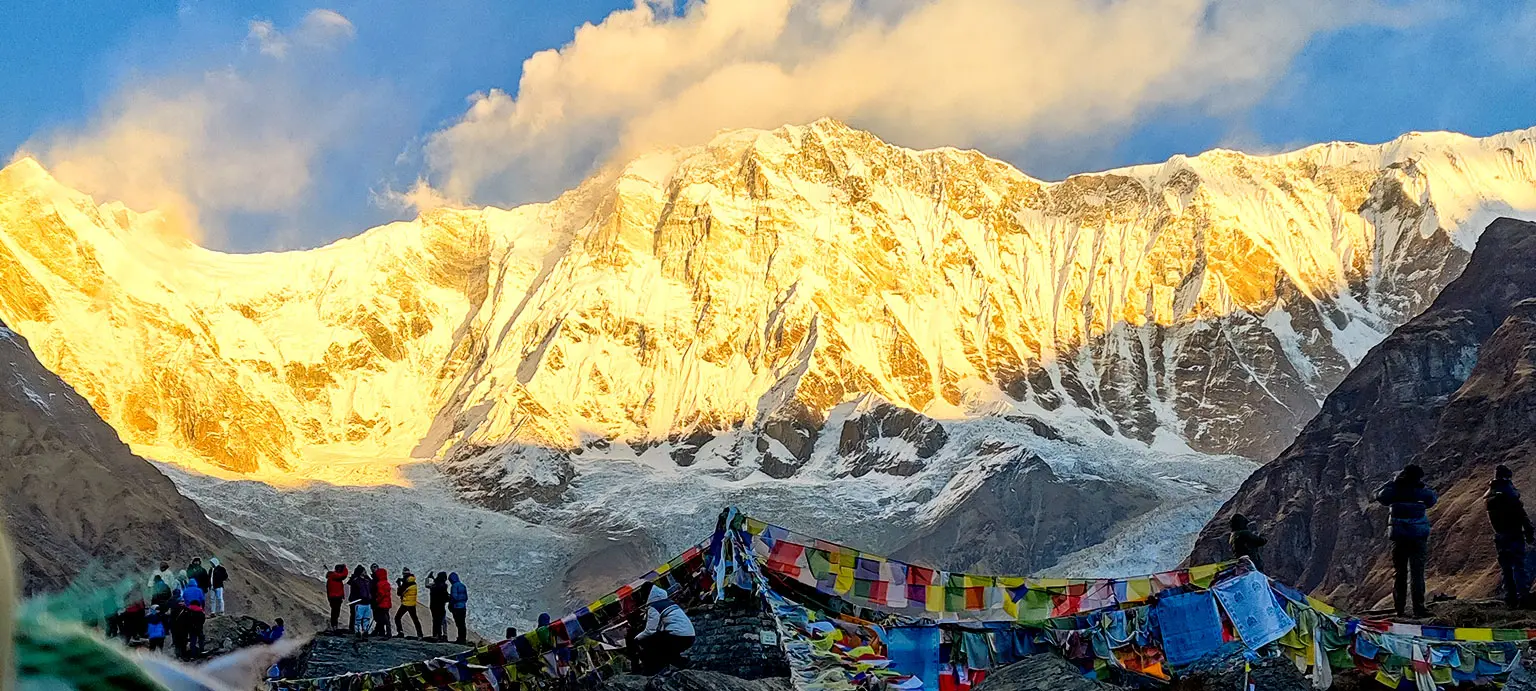
Annapurna Base Camp Trek
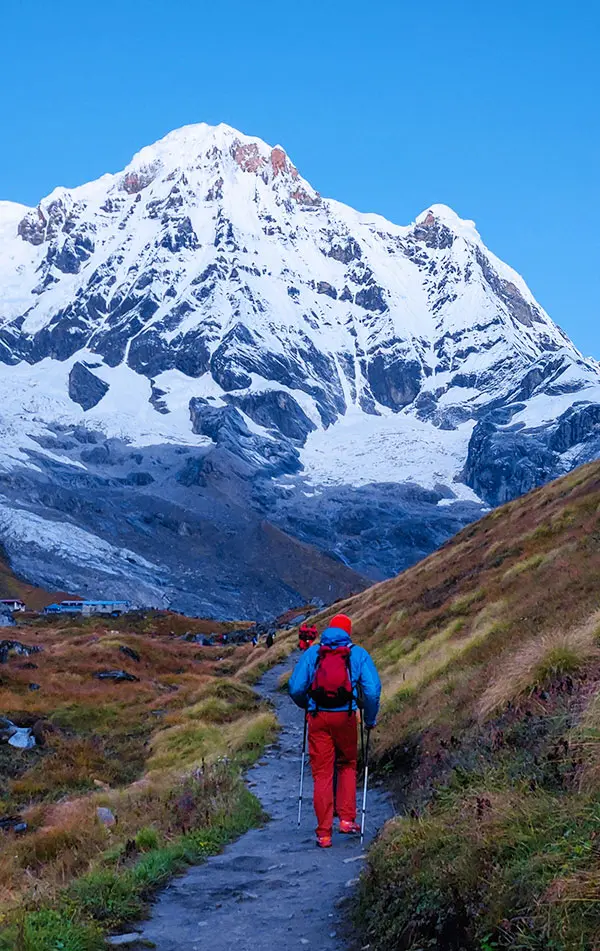
Pokhara | Nepal
Max Altitude
Trekking Km
Moderate to Difficult
Help & Support
30000 /person $ /person.
- September-2024
- October-2024
- November-2024
- +5% GST (goods and services tax)
- USD 480 for Non-Indian, +5% GST
- Services Pokhara to Pokhara
- Stay in Pokhara, Transportation and Food is included
Insurance 2000
Insurance is Mandatory.
Non-Indian rates are slightly higher. Trek coordinator will provide balance payment link post-booking.
- Get insurance through us or elsewhere. If not through us, email for a refund after booking.
The cancellation policy will be implemented in accordance with the trek cancellation policy.
For more information. Please complete this form.
Help & Support
Trek Name: Annapurna Base Camp Trek
Adventure Type: Trekking
Base Camp: Pokhara
Season: Spring | Summer | Autumn |
Month: March | April | May | September | October | November |
Country: Nepal
Altitude: 13550 Ft.
Grade: Moderate to Difficult
Rail Head: -
Stay: Hotel & Teahouse
Food: Meals while on trek & at Hotel/Guesthouse (Veg & Eggs)
Location: Pokhara
Distance: 70 Km.
Trail Type: Point to point trail | Camping at the same location upon returning.
AirPort: Pokhara International Airport
Why Annapurna Base Camp Trek is a must do trek
Panoramic Vistas:
- The trek unfolds a mesmerizing panorama of the Annapurna Massif, including Annapurna I (8,091m), Machapuchare (6,993m), and Hiunchuli (6,441m).
- Spectacular sunrise and sunset views over the snow-capped peaks create a magical atmosphere.
Diverse Landscapes:
- Traverse through diverse landscapes, from lush rhododendron forests and terraced fields to alpine meadows, providing a kaleidoscope of natural beauty.
- The trek offers a unique blend of subtropical climate in the lower regions and an alpine environment at higher elevations.
Cultural Encounters:
- Engage with the rich cultural tapestry of the region by interacting with the friendly Gurung and Magar communities.
- Visit traditional villages along the way, immersing yourself in the local customs, rituals, and hospitality.
Natural Hot Springs:
- Soothe your tired muscles in the natural hot springs at Jhinu Danda, a refreshing break on the trek.
- Enjoy the therapeutic benefits of the geothermal waters while surrounded by the beauty of the Annapurna region.
Charming Teahouses:
- Experience the unique hospitality of Nepalese teahouses, offering a cozy and warm atmosphere after a day of trekking.
- Interact with fellow trekkers from around the world, fostering a sense of camaraderie.
Flora and Fauna:
- Encounter a diverse range of flora and fauna, from colorful rhododendron blooms in spring to elusive Himalayan wildlife such as the Himalayan tahr and pika.
- The trek provides a unique opportunity for nature lovers and wildlife enthusiasts to witness the biodiversity of the Annapurna Conservation Area.
Challenging Yet Accessible:
- Ideal for both novice and experienced trekkers, the ABC Trek offers a moderate level of difficulty, making it accessible to a wide range of adventure enthusiasts.
- The sense of accomplishment upon reaching the base camp is a reward that transcends the physical challenges.
When we talk about the Annapurna Base Camp , there is a sense of admiration that starts building up which leaves every trekker spellbound. There are very few treks that have this aura of making you fall in love with the landscapes and bring you closer to the base of 7,000 and 8,000-meter peaks in such a short period. The Annapurna Base Camp Trek is one of the most popular treks in the Annapurna region. The trail is a majestic one that takes you through rice paddies, lush rhododendron forests, and high-altitude landscapes with the Annapurna Range looming in front of you most of the time.
The Annapurna range has such stunning mountain views which are a buffet for every mountain lover. You will also be greeted with views of Machapuchare, Annapurna South, and Hiunchuli even before you set foot on the trek, which is one thing that is surely a bonus for all the trekkers. Views of different peaks of the Annapurna massif and Machapuchare will always be in sight of Sinuwa.
Accommodation on the Annapurna trail is organized in classic teahouses where delicious Nepali dishes are served. These tea houses are run by locals of the area who migrate from other parts of Nepal. The Annapurna Base Camp Trek is also known as the Annapurna Sanctuary Trek because you trek along the protected areas trail. A lot of floral and faunal species are also found in this area which will surely amaze you with the beauty it has to offer. From a height of 4,000 meters, you'll be able to see the entire sanctuary which is oval-shaped and surrounded by a ring of the Annapurna Mountains.
The starting point of the Annapurna Base Camp Trek is the beautiful city of Pokhara, which lies just 5 to 6 hours away from the capital. You can reach Pokhara city from Kathmandu via road or plane as well. The easy accessibility of the trek makes it an ideal choice for many trekkers as the chances of any flight cancellations or delays are greatly reduced. The trekking journey is also massively feasible with good communication services and safety. Annapurna Base Camp is a real trekking experience for all trekking enthusiasts.
- Who can Participate
- Important Links
- How to Reach
- Trek Essential
Who Can Participate
Age; 12 years +.
First timers can apply; previous trekking experience is more appreciated.
The climber must be fit and have sufficient stamina to cover 5 km of distance in 30 minutes without stress.
The climber should be able to carry a 10-15 kg backpack.
Pulse rate at rest must be in between (60 to 90 beats per minute)
Blood Pressure Reading must be in between (DIASTOLIC 70 – 90, SYSTOLIC 100 - 140 mm Hg)
Respiratory rate at rest must be in between (12 to 20 breaths per minute)
Should not have Liver and kidney issues
Should not have Diabetes Mellitus, Bronchial Asthma, Heart problems, Hypertension etc
No pacemaker implant
People with the Sinus issues, Epilepsy please contact to trek coordinator before booking the trek
If your BMI is not normal, Please contact our Trek coordinator before Trek booking.
Medical & Disclaimer Form (Mandatory Documents) Click here to download Medical & Disclaimer Form
- Government Employees can avail the benefit of Special Casual Leave (SCL) when you join us for a trekking expedition. As per the rules of the Pay Commission, Special Casual Leave can be availed for up to 30 days in a calendar year for trekking/mountaineering expeditions through a registered organization. Trek The Himalayas is a registered adventure tour operator by Indian Mountaineering Foundation (IMF) and Ministry Of Tourism (MOT)
- Trekkers have to apply for leave at least 20 days before trek departure date,
- This service is exclusive to Indian government employees and is applicable only for treks within India.
- Do mail at info@trekthehimalayas to apply and mention your booked trek date and trek name.
Junior trekkers (below 15 years) should have a company of parents/guardians.
Trekkers between 15 to 18 years can come solo with the disclaimer form signed by parent/guardian.
- Medical & Disclaimer Form (Mandatory Documents) Click here to download Medical & Disclaimer Form
Exercise For Moderate to Difficult
Fitness Regime For:
Calculate Your Bmi
Your BMI value is
Congratulations, your body is in good conditions!
Arrival in Pokhara
- Altitude: 2,600 ft.
- Stay: in the hotel (check-in at 12 noon).
- Briefing about the trek in the evening.
- Sightseeing: Phewa Lake, Tal Barahi Temple, Himalayan Views, International Mountain Museum (not included in the cost).
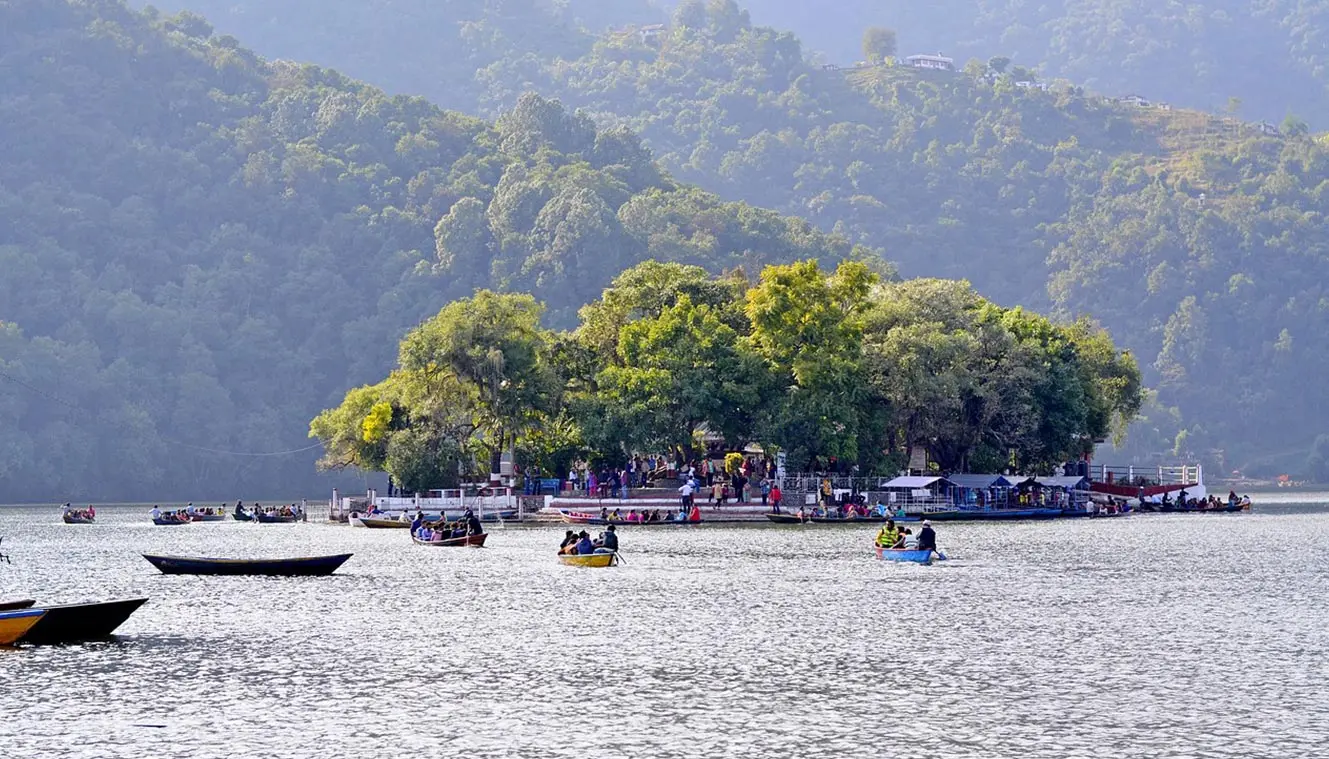
After a pleasant flight journey, arrive in Pokhara. It is the hub of mountaineers that lies on Phewa lake. All the big expeditions and trekking start from here. Snow-capped peaks surround the locality and you can see stunning views of the Annapurna Ranges. Enjoy the Himalayan views, rice fields, and Nepalese culture around. If you didn’t know, Pokhara used to be a trade route between India and Tibet some 300 years ago. You may also spot paragliders soaring above the city. The tranquil setting of Pokhara gives you a wonderful opportunity to reconnect with nature.
In the evening you can go sightseeing around the local attractions in Pokhara like the Phewa Lake, Tal Barahi Temple, and International Mountain Museum. You will also receive a briefing from our team regarding the schedule of upcoming and everything entailed in the trek. Your trekking day starts tomorrow and it's a long journey ahead so rest well so that you are fresh and energized for tomorrow.
Pokhara to Sauli Bazar (Drive) and trek to Ghandruk
- Altitude Ghandruk: 2,000m/6,500ft.
- Altitude Sauli Bazar: 1,150m/3,800ft.
- Pick-up time: 7:00 am.
- Drive to Sauli Bazar: 40km | Drive Duration: around 2 hrs.
- Trek 5km | Duration 4-5 hrs.
- Gradual ascend throughout.
- Water source: Villages and teahouses on the route.
- Views: Machapuchhare and Annapurna (South), Hinchuli, Gangapurna, and Annapurna - 3.
- Visit Old Gurung Museum in the evening.
- Lunch on the way.
- Stay: at teahouses.
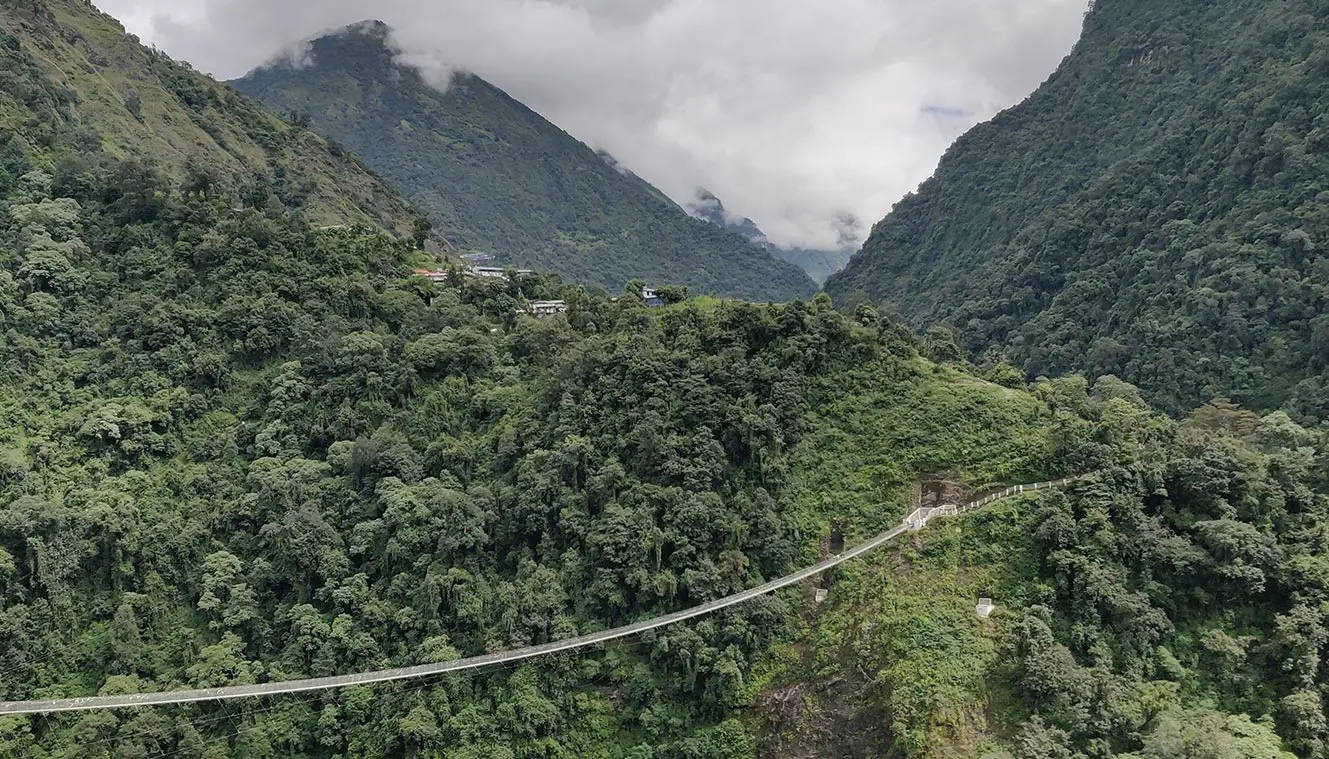
After breakfast, you will have a ride of approximately 2 hrs to Sauli Bazar. The actual trekking begins henceforth to Ghandruk crossing Lower Ghandruk. The path is well paved having stairs intermittently. The trek has a gradual ascent taking 5-6 hours to reach our camping site. Once you cross the bridge over the Bhurgundi River on your way to Ghandruk, you will arrive at Birethanti where you are required to sign documents as part of formalities with the local authorities for the Annapurna Base Camp Trekking. Post this the trek begins to ascend towards Ghandruk.
From here, you will have to climb some stone steps to Kimche. After the stairs, the gradient of the road eases out a bit. From here it will take about 2 hours to reach Ghandruk. Ghandruk is considered the biggest village on the trek route. It is inhabited by stone-built small houses. The village is loaded with tea houses that serve typical Nepalese cuisine. The village also has a local museum that showcases the Gurung culture. In the south, you can notice Machapuchhare and Annapurna views on a clear day. Relax in your bed for a wonderful night in the mountains.
Ghandruk To Chhomrong
- Altitude: 2,200m/7,200ft.
- Trek 10km | Duration 6-7 hrs.
- First 1-hour ascent then descent till lunch point followed by an uphill climb to Chhomorong.
- Water source: Teahouses on the way.
- Views: Annapurna (South), Gangapurna, Fishtail, Hinchuli, and Annapurna 3, amazing sunset view on sunset on Annapurna Mountain Range.
- Chhomorong market is the last market on this trek after this no market is available.
- Stay at tea houses.
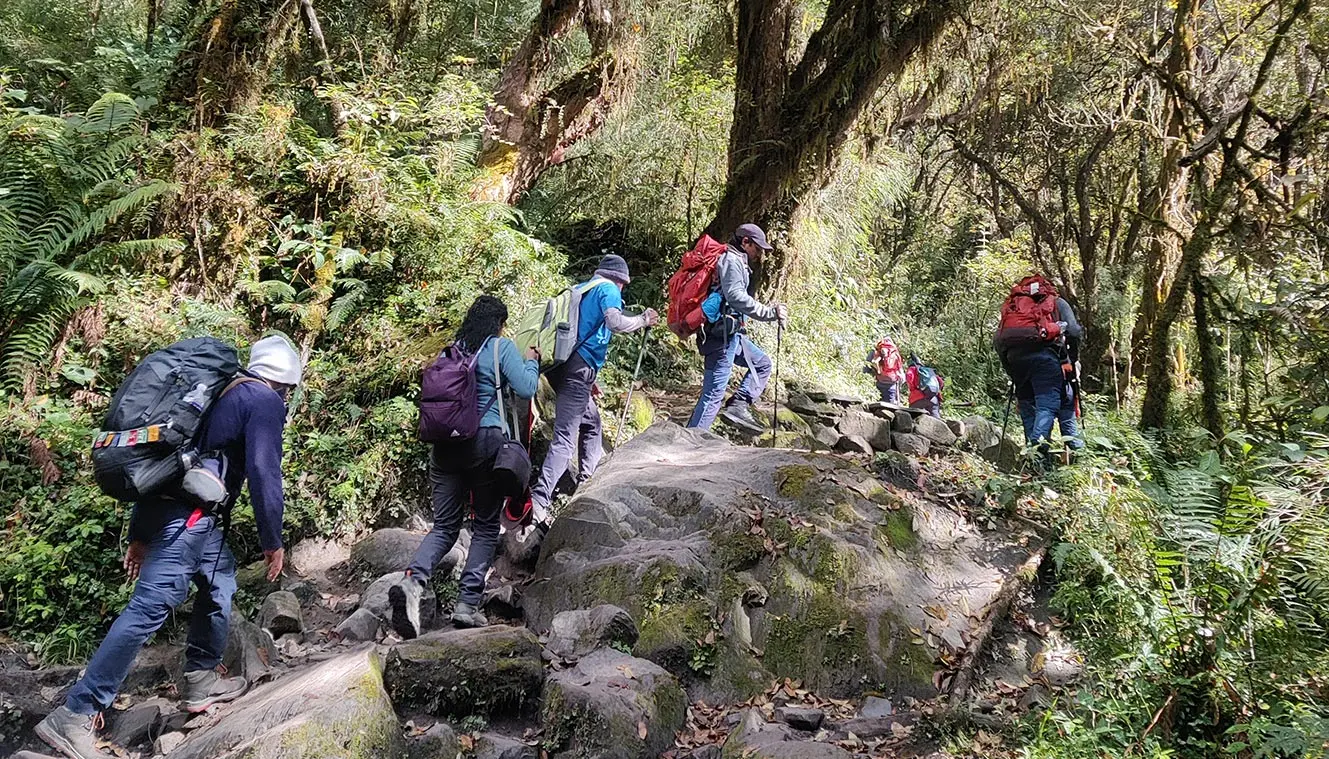
The hike today is through a delightful muddy trail laid up with scenic villages on both sides. After a descent of 1 hour, you will reach Kimrong Khola. Kimrong is a small village located on the top of a ridge offering panoramic views of the Himalayan mountains all around. A beautiful array of snow-covered peaks, Annapurna South, Gangapurna, Fishtail, and Hinchuli, begin to appear. From Kimrong, you have to descend about 400 m sharply to Kimrong Khola, through dense covers of Oak and Rhododendron trees. The route henceforth goes uphill until Chhomrong (a 4-5 hours hike). Chhomrong is situated at the base of the Hiunchuli mountains and you will see picture-perfect hilly settlements surrounded by green banana fields, rhododendrons, ferns, etc. are seen throughout. Chhomrong lies on a hilltop having stone paved stairs. It is the gateway to Annapurna Sanctuary and permits are granted here. You can also see Sinuwa Village on the opposite side of the mountain. The sights of Annapurna South become prominent. Again there are numerous tea houses and shops selling batteries, memory cards, and other accessories. Watch the peaceful sunset on the Annapurna range and rest for the day.
Chhomrong To Bamboo
- Altitude: 2,300m/7,600ft.
- Trek 10 km | Duration 5-6 hrs.
- Descend on stone steps to Chomrung Khola, then steeply ascend to Sinwa to Bamboo village.
- No mountain view in Bamboo.
- Lunch on the way in teahouses.
- Bamboo is full of Bamboo trees.
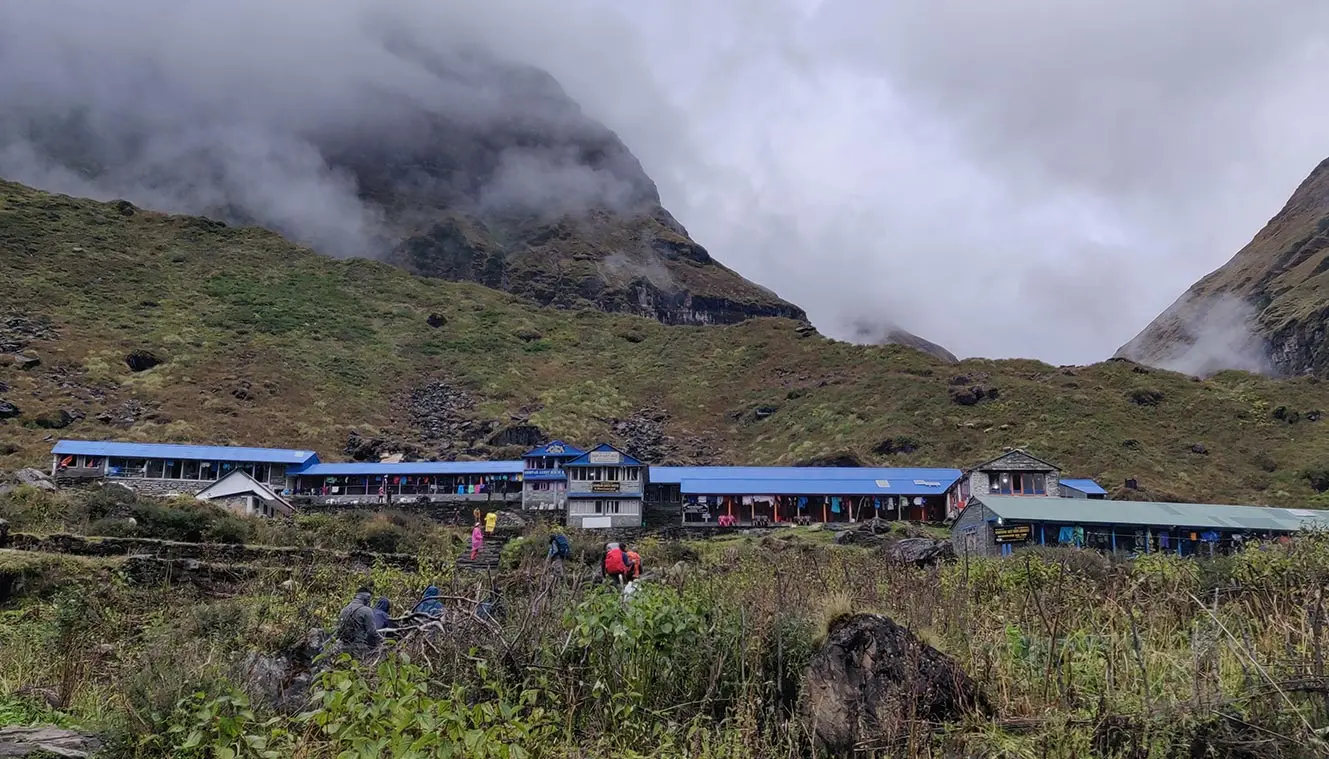
Welcome another amazing morning in the lush green hilly setup. Start with a descent on 2500 stone-built stairs leading to a bridge. The hanging bridge then takes you to Chomrung Khola, which seems like entering into dense forests. The Sanctuary is flourished with rhododendrons, oak, and alpine trees. Therefore the trail looks lush and adorned with reddish-pink flowers.
Climb up the stairs to the other side of the mountain to Sinuwa Village. Below, you can see the Chomorng River gushing away with a torrential force. The trail is steep to Sinuwa village. Sinuwa is marked with a few teahouses and lodges. It is enclosed between thin forest cover. Past these points, the donkeys are not permitted on the trail and the goods are then carried by the porters from this point on. Annapurna III comes into clear visibility here. Another climb opens to Kulidhar then a downhill hike ends at Bamboo camp.
The bamboo campsite does not offer as many mountain views as other teahouse stops as it is at a lower altitude than the surrounding mountains. However, you may see a lot of Bamboo plants around the campsite. Rest well in Bamboo and tomorrow we will make our way to the stunning Machapuchhare Base Camp.
Bamboo To Deurali
- Altitude: 3,200m/10,550ft.
- Trek: 9 km | Duration: 5-6 hrs.
- Moderate level of ascent crossing Modi Khola River.
- Views: Machhapuchhre, Gangapurna, and Annapurna III.
- Lunch is on the way.
- Stay in teahouses.
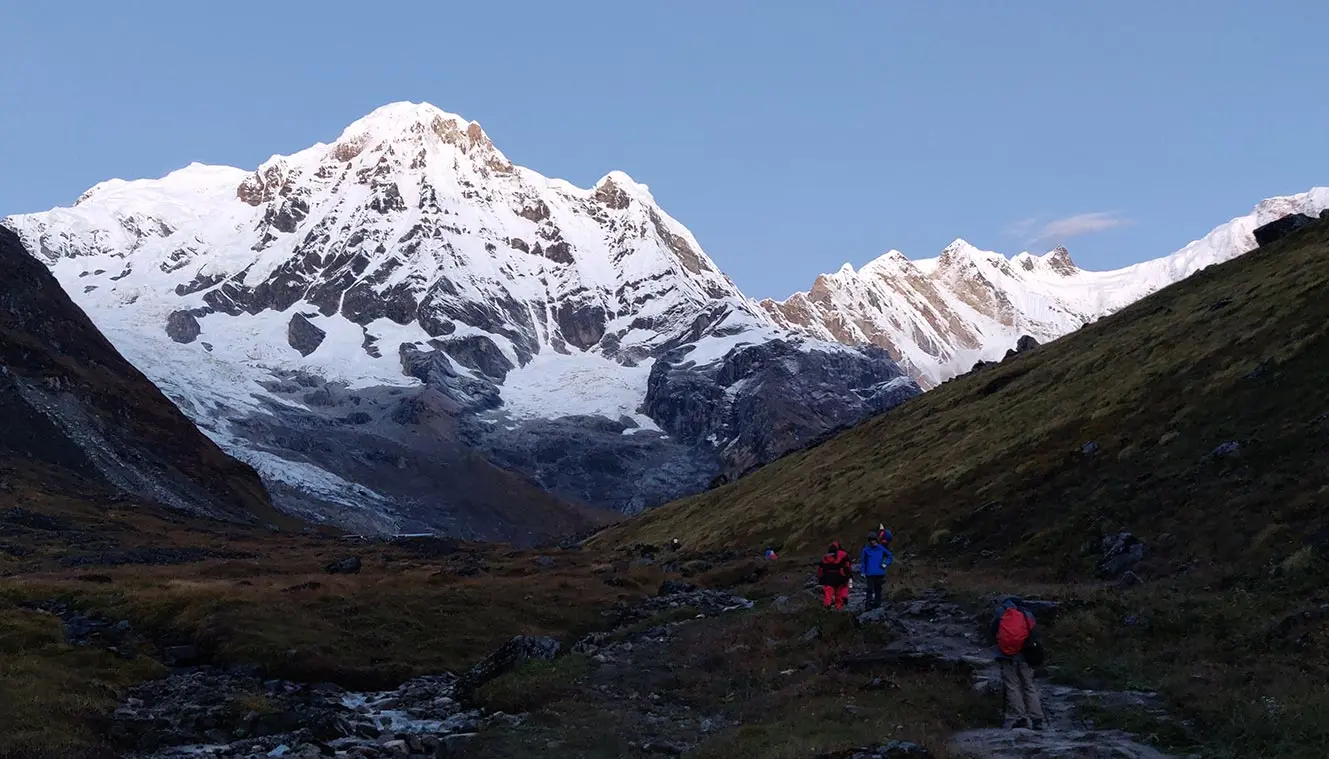
Get all braced with enough energy as this is the strenuous day of the trek. Yet, the trail will show changing vegetation from sub-tropical to alpine and the sights will keep you revitalized. The height gain is close to 4000 feet, therefore take it slow and stay hydrated. In one hour the first village Dovan comes en route, identified by 5 lodges only. The tip of Machapuchhare mountain will be visible. Mix path of gradual ascends and descends with muddy trail lead to Himalaya. A wooden bridge and shrine will be the highlight of the trail. Himalaya has quaint tea houses. After the Himalayas, the terrain sees a change from dense alpine forests to a bouldered region. You might see some vegetation like Bamboo, grass, and ferns.
A few landslide and avalanche-prone areas will be seen on the path ahead. An overhanging cave called Hinku arrives after an hour of hiking up. The entrance to the cave is blocked. The trail begins to descend for about 10 to 15 minutes from here. From here the trail descends for another 15 minutes until you arrive at two big snow patches. Cross the snow patches and a stream crossing followed by a climb of about 20 minutes to reach Deurali. This is the camping spot for the night. Deurali is surrounded by lush greenery and offers panoramic mountain sceneries. You can see the Machapuchhre, Gangapurna, and Annapurna III from here.
Deurali To Annapurna Base Camp Via Machhapuchhre Base Camp
- Altitude Annapurna Base Camp: 4,130m/13,500ft.
- Altitude Machhapuchhre: 3,700m/12,200ft.
- Trek: 8km | 6hr.
- Moderate ascent till Annapurna Base Camp.
- Views: Entire Annapurna range, panoramic views of Gangapurna, Gandharvachuli, Machapuchare, Annapurna (South), and view of mighty Annapurna I, get fantastic 360-degree views and beautiful sunrise and sunset.
- Lunch at MBC.
- Stay: in teahouses.
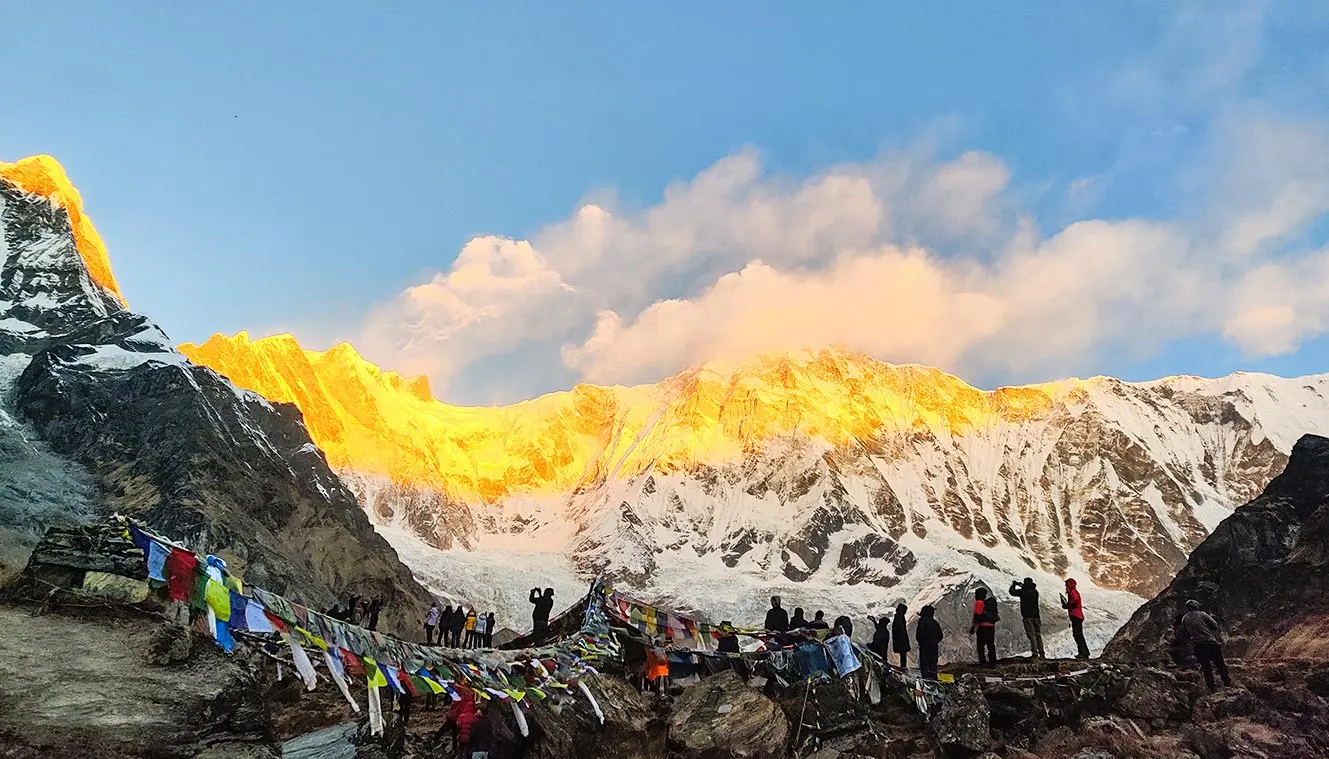
The trail that climbs out of Deurali is a bouldered section. From here the trail opens up to a valley with Modi Khola thundering past you. Another section of the rocky terrain of 40 minutes directs you to Bagar. From here, you will walk past some abandoned lodges, and in about one hour you will come across a bridge over Modi Khola, after crossing this bridge the next halt, Machapuchre Base Camp is 30 minutes away. Keep your eyes on the left and you will see astounding views of the Annapurna Ranges while in your front you will get to see the majestic Machapuchhare Range.
MBC is a stunning place well-known for the mesmerizing moon rise on Machapuchre mountain, do not miss this wonderful night sky. Along with it, other peaks seen are Mt. Hiunchuli, Annapurna South, Annapurna I, Annapurna III, Gandharvachuli, and Gangapurna. Since you will be climbing close to 4,000 ft today, so be aware of signs of AMS. The route takes a sharp 90-degree turn to the left for ABC. The initial trial has a steep ascend followed by a gradual ascend. You will be hiking above the tree line; hence no traces of trees will be seen.
Just as you get closer to the camp, the magnificent Annapurna I becomes bigger and bigger. The ABC is like being on an island encircled by giant peaks and huge never-ending ranges. 6000 and 8000 m peaks surround the base camp and it is an astounding sight to behold. 360-degree spectacles of the magnificent Annapurna range, Gangapurna, Gandharvachuli, and Machapuchare. Enjoy your lunch looking at the white clouds waving over these peaks. If you are lucky enough, you may even spot some Marmuts on your way to the campsite. Spend the rest of the day breathing with the mountains. Live every moment and sleep in their shelter.
Annapurna Base Camp To Bamboo
- Altitude: 2,300 m/ 7,600 ft.
- Trek Distance: 13 km | Duration: 8-9 hrs.
- Retracing the route with gradual ascend and descend.
- Water source: Refill water bottles at teahouses
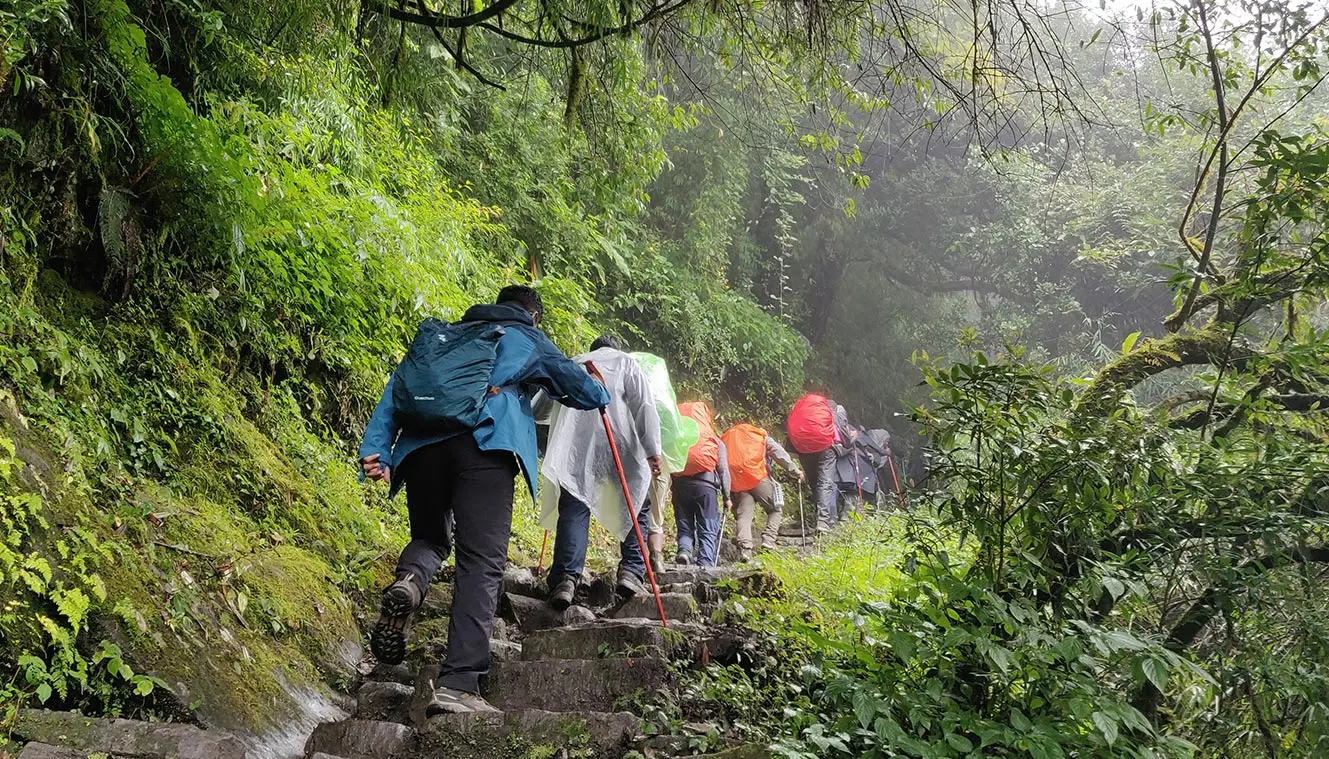
This is the longest day of the trek retracing the steps back to Bamboo. The trail as you know is mostly a descent so is quite easy. Wake up to an amazing sunrise over the Annapurna Massif. This is one of the best sunrises, you will see so try not to miss it. After watching a sunrise and a delicious breakfast, we will begin to head down towards Bamboo. The MBC, Deurali, Himalaya, and Dovan habitats will pop up again as you move down. Relax in your bed at Bamboo lodge after a long day of walking.
Bamboo To Jhinu Hot Spring
- Altitude: 1,700m / 5,600ft.
- Trek Distance: 8 km | Duration: 5 to 6 hrs.
- A mixture of steep ascending and descending trail.
- Water source: Refill water bottles at tea houses.
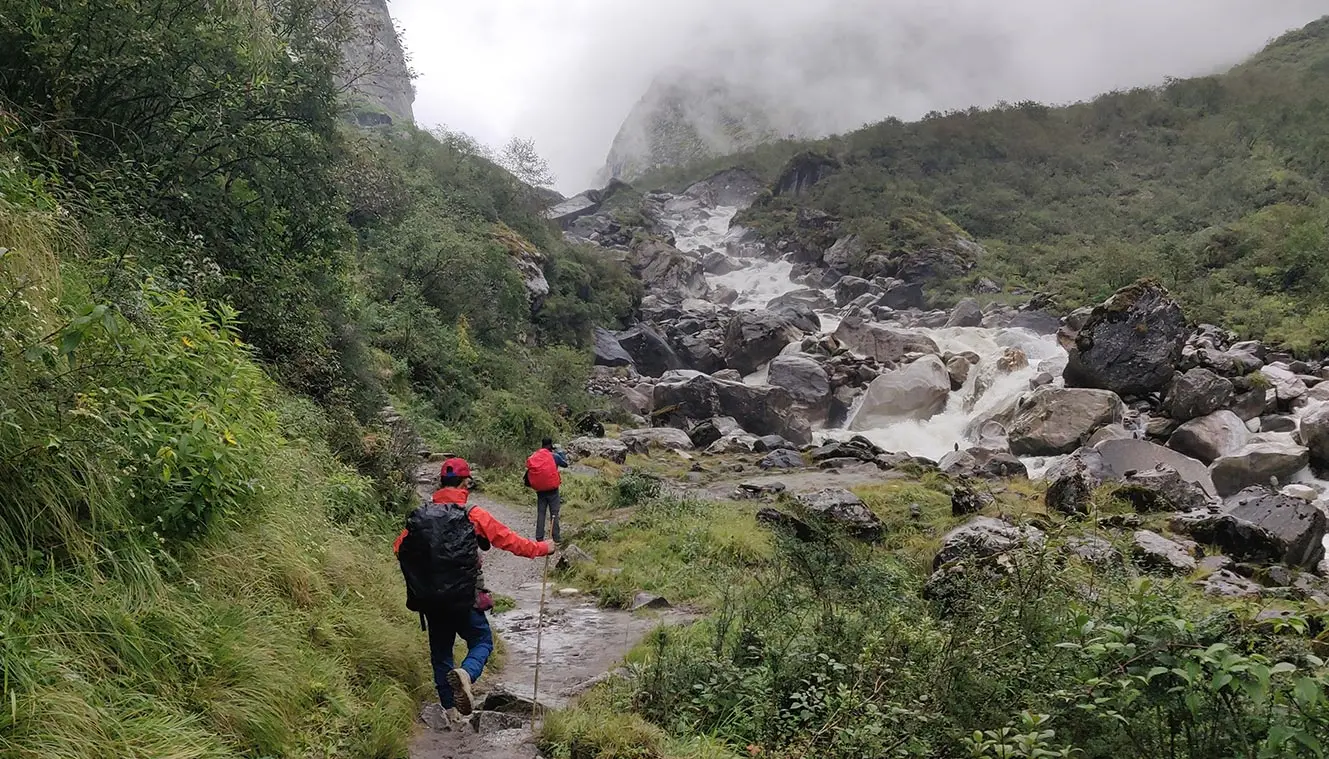
Again retrace your path to Sinuwa followed by a steep descent to Chomrung Khola. It should take around 45 minutes to reach Sinuwa. Cross the same hanging bridge towards Chomrung Khola. Another steep ascent will lead to Chomrung village. It will take about an hour to reach Chomrung Khola and 45 minutes more to Chomrung. Try to re-picture the sights you captured earlier and enjoy them.
From Chomrung take an ascending trail until you arrive at the fork where a signpost reads Jhinu. From here on, you have to take the steep descending steps, all the way, to Jhinu. It will take you around 1.5 hrs to reach Jhinu.
With downhill and then uphill hike Jhinu Danda settlement arrives. Jhinu is popular for its hot springs and you will see a lot of subtropical forests all around. Enjoy the refreshing hot springs of Jhinu 20 minutes away. Cherish your last night of the trek.
Jhinnu Hot Spring To Jhinnu Bridge And Drive To Pokhara
- Altitude Jhinnu Bridge: 1,250m/4,200ft.
- Trek Distance: 2 km | Duration: 45 minutes.
- Easy trail to road-head, from road-head drive to Pokhara.
- Drive Distance: 60 km | Duration: 3 hrs.
- Check-in at the hotel in Pokhara.
- Debriefing and certificate distribution in the evening.
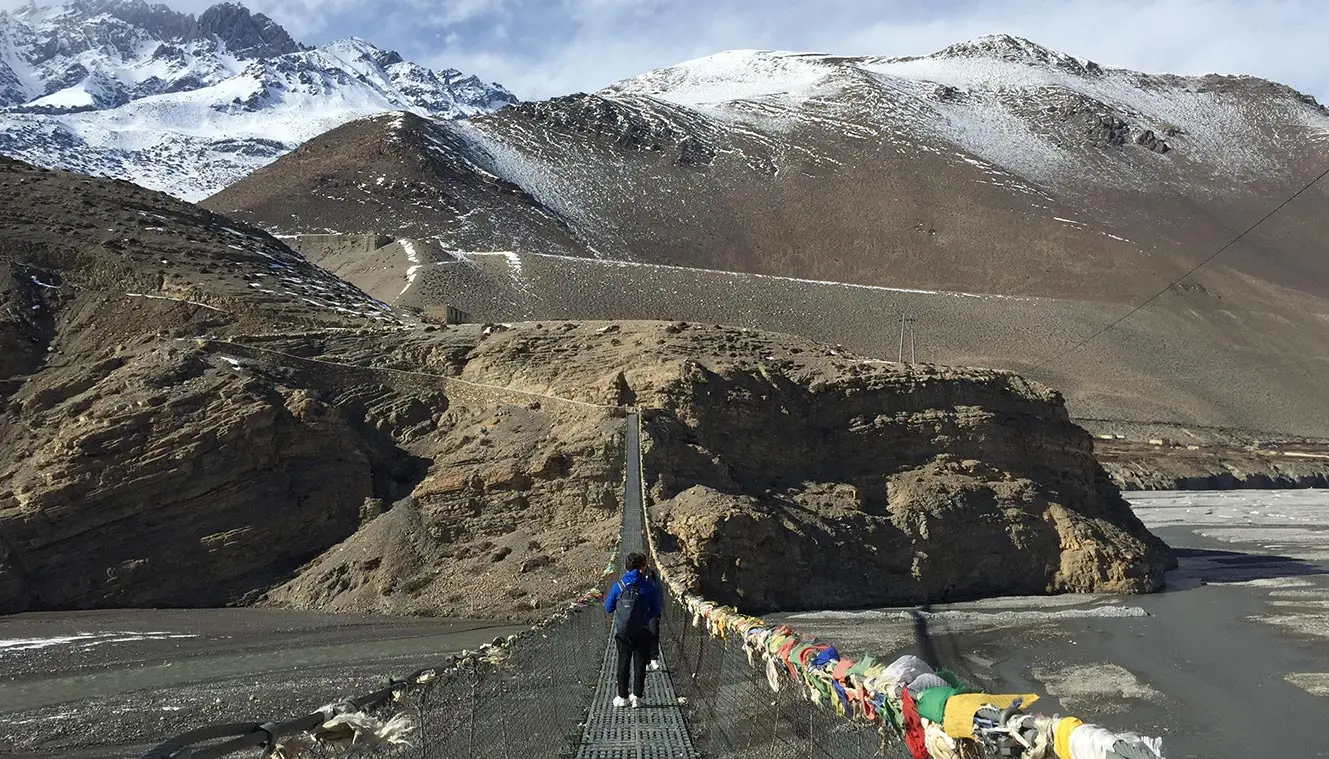
From Jhinnu Hot Spring follow the descending trail to Kimrong Khola Bridge. It will take about 45 minutes. Keep walking on the trail along the houses and you will arrive at a road head. From here, you will board a vehicle to Pokhara. In about 3 hours you will reach your hotel in Pokhara. Spend the evening at your leisure in Pokhara. Your overnight accommodation is arranged in Pokhara as well.
- Checkout time of the hotel is 10:30 am on day 10.
- It is advisable to make any further travel plan on day 10 or after day 10.
- Keep a buffer day in your travel plan.
- If buffer day is not used in the travel then it can be used to Explore Rishikesh.
- Distance, Altitude, and Trekking hours are approximate and rounded off.
- Keep the original and copy of ID proof handy.
Day-1: Arrival in Pokhara
- Altitude: 2,700 ft.
Day-2: Pokhara to Sauli Bazar (Drive) and trek to Ghandruk
- Altitude: 2,000m/6,500ft.
Day-3: Ghandruk To Chhomrong
Day-4: chhomrong to bamboo, day-5: bamboo to deurali, day-6: deurali to annapurna base camp via machhapuchhre base camp, day-7: annapurna base camp to bamboo, day-8: bamboo to jhinu hot spring, day-9: jhinnu hot spring to jhinnu bridge and drive to pokhara.
- Checkout time of the hotel is 12:00 Noon on day 10.
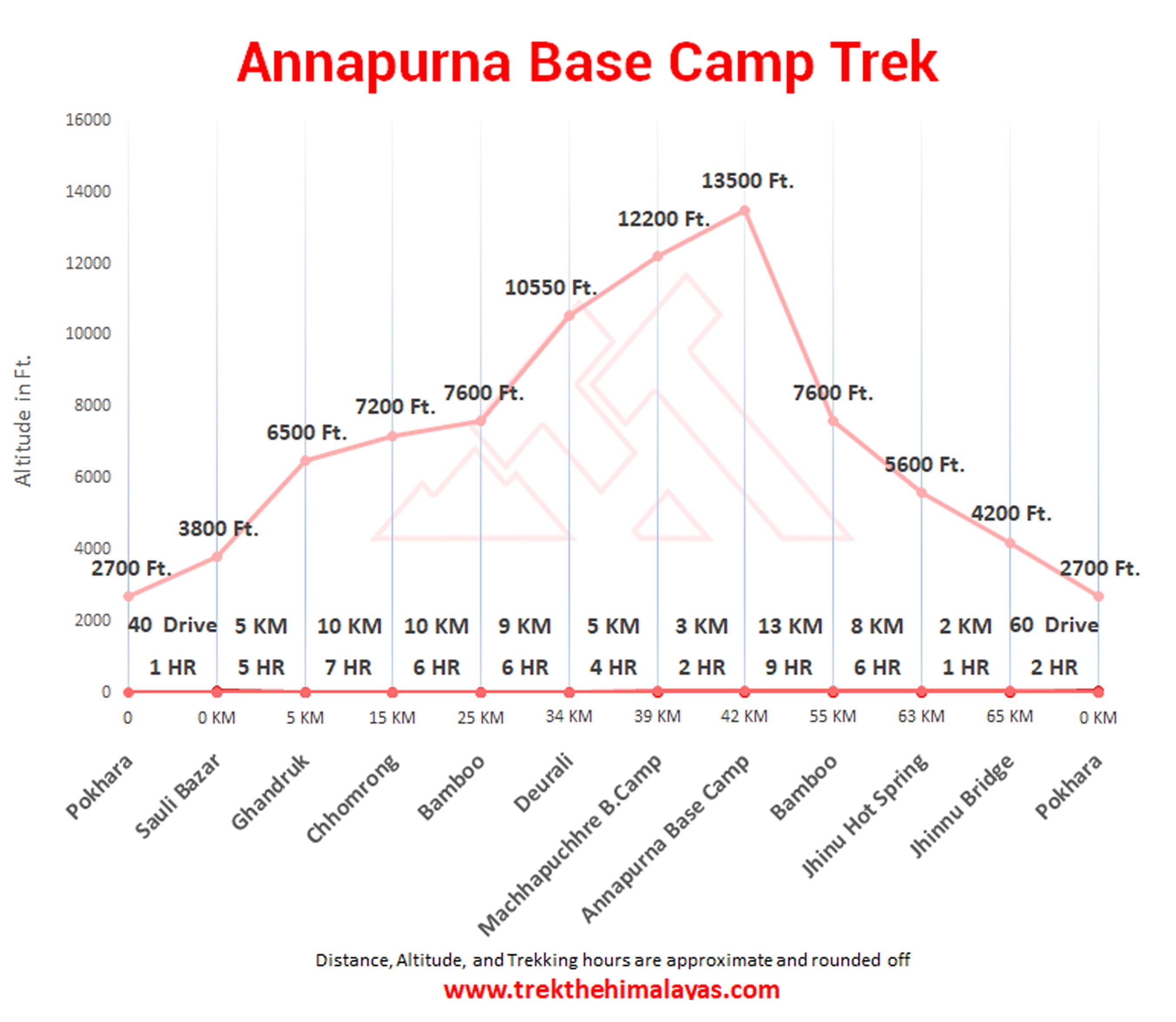
Medical & Disclaimer Form (Mandatory Documents) Click Here.
How To Reach
It is essential for everyone to arrive at Pokhara (1:00 pm).
Upon booking the trek, you are required to come to our hotel. Your trek coordinator will provide you with details such as the name of the Pokhra hotel, its location, and the contact person's number.
Options to reach Pokhara
Tribhuvan International Airport is the only International airport located in Kathmandu, Nepal. There is no Pokhara airport, although it has its own landing field. One can fly to Tribhuvan airport and then can take an additional flight to Pokhara. The distance between Pokhara and Kathmandu is around 200 kms and can be covered in 30 minutes. Popular airlines such as Buddha Air, Yeti Airlines, and Simrik Air serve this Pokhara route.
There is no train option travelling to Pokhara, Nepal. The closest railway stations which one can arrive at are Jaynagar, New Jalpaiguri or Gorakhpur (INDIA). From there crossing the corresponding borders of Panitanki or Sunauli, one can take a bus to Pokhara via Kathmandu.
One can directly travel to the cities like Gorakpur or Varanasi in Uttar Pradesh, and by crossing the Sunauli border can catch a bus or book a private car to reach Pokhara. The journey will take upto 8 hours to complete. Or one can fly to Kathmandu and then take public or private transport to Pokhara. The distance between these two cities is 200 kms which may take upto 6 to 7 hours.
For your return journey from Pokhara, you have the flexibility to choose between road or air transport options. Please note that our services extend only to the hotel, and the standard hotel check-out time is 11:00 am.
.webp)
1. Accommodation (as per the itinerary):
- Day 1 and Day 9 stay in a 3 star Hotel in Pokhara with Breakfast.
- Day 2 to Day 8 Teahouse.
2. Meals (Veg + Egg):
- Day 2 Lunch to Day 9 Lunch, Tea & Cookies on arrival at Tea Houses.
- 3 Cups Tea/Coffee with Meal, Fresh Fruit after Dinner.
3. Support:
- 1 Mountaineering & First aid qualified professional trek Leader.
- 1 Experienced
- Enough support staff.
4. Trek equipment:
- High-altitude sleeping bag.
- Gaiters & Crampon (if required.)
5. First aid:
- Medical kit
- Oxygen cylinder.
- Blood pressure monitor.
- Stethoscope.
6. Transportation (as per the itinerary):
- Pokhra to Nayapul and return.
9. Permits:
- Entire Administration and Local Taxes.
- All necessary permits and entry fees, Upto the amount charged for Indian Nationals.
10. Services from Pokhra to Pokhra. 11. Store room facility in Pokhra for extra luggage. 12. Insurance of Trekking Guide and porters. 13. ABC Trekking Map
1. Any kind of personal expenses. 2. Porters for the personal bag* 3. Wi-Fi, charging batteries and hot showers, warm water for drinking 4. Nepal entry visa (approximately $40 USD) only for foreigners (Not for Indians) 5. Customary gratuities for guides & porters 6. Unforeseen costs due to flight cancellation, weather conditions, etc 7. Evacuation and medical expenses* 8. Drinks: Bottled water. 9. High-altitude Trekking Insurance is mandatory. 10. All costs not outlined under "What's included" 11. Permit and entry fee for Foreign Nationals/OCI/NRI &
Things can be provided on demand and availability (participant has to pay extra for these things) 1- Satellite phone/set phone - is a type of mobile phone that connects via radio links via satellites orbiting the Earth instead of terrestrial cell sites like cellphones. Therefore, they can operate in most geographic locations on the Earth's surface.
2- Gamow/PAC HAPO Bag (Portable Hyperbaric Bag) - is a unique, portable hyperbaric chamber for the treatment of acute mountain sickness (AMS), also known as altitude sickness.
3- AEDs (Automated External Defibrillators) -& are portable life-saving devices designed to treat people experiencing sudden cardiac arrest, a medical condition in which the heart stops beating suddenly and unexpectedly.
Cancellation terms:
Cancellations prior to 25 days from the start of the Trip
Refund options
- 5% deduction of trek fee
- 100% cash voucher for any trip till one year
- Transfer your trek (any trek, any date) to your friend
Cancellation between 24 days and 15 days to the start of the Trip
- 30% deduction of trek fee
- 100% cash voucher for same trip till one year
- 85% cash voucher for any trip till one year
- Transfer your trek (same trek, any date) to your friend
Cancellation between 14 days and 10 days to the start of the Trip
- 50% deduction of trek fee
- 80% cash voucher for same trip till one year
- 70% cash voucher for any trip till one year
- Book the same trek, in the same season, with any other batch
Cancellation less than 9 days to the start of the trek
- No cash refund
- 20% cash voucher for the same trip till one year
- 10% cash voucher for any trip till one year
- Transfer your trek (same trek, same date) to your friend
Note- If a booking is made using a voucher or discount code, the policies related to vouchers and discounts cannot be modified.
In the unlikely event that TTH cancels a trek prior to the scheduled departure date:
While it is extremely rare for TTH to cancel a trek, we understand that unforeseen circumstances or natural disasters may occasionally require us to do so before the scheduled departure. These circumstances could include continuous rain or snow, thunderstorms, snowstorms, landslides, floods, earthquakes, or any other natural calamity that poses a risk to the safety of our trekkers. Additionally, unforeseeable events such as local riots, curfews, pandemics, lockdowns, government orders, or any similar situations that compromise the safety of the trekking experience may also necessitate a cancellation.
In the event of such a cancellation, TTH will provide you with a voucher equivalent to the amount you paid for the trek. This voucher can be redeemed for any of our treks within the next year, allowing you to still enjoy an adventure with us at a later date.
The issuance of a voucher is not applicable in situations where you are required to descend from the trek for any reason. The trek leader may make the decision to send you down from the trek due to factors such as insufficient fitness level, symptoms of Acute Mountain Sickness (AMS), high blood pressure, exceeding the designated turn-around-time, health concerns, or if you are found smoking, drinking, or violating the rules set for the trek. In such cases, the provision of a voucher does not apply.
In the rare event that TTH shifts a trek:
We would like to emphasize that weather conditions in high-altitude areas are highly unpredictable and can undergo sudden changes at any time, irrespective of the day. Additionally, circumstances beyond our control, such as natural disasters, political unrest, pandemics, and lockdowns, may impact the feasibility of conducting a trek. In cases where we are unable to proceed with an event due to such circumstances that are beyond our direct control, we will make every effort to provide you with an alternative trek that is safer and more suitable.
In such situations, we will issue a voucher to offset the cost difference between the originally scheduled trek and the alternative trek. This voucher can be redeemed at any time within one year from the date of issue. Please note that a refund fee or reimbursement of the cost difference is not applicable in these cases.
- Change of trek batch is dependent on the availability of seats in the batch
- In case of transferring a trek to a friend, he/she should satisfy all the mandatory requirements put forward by TTH
- TTH holds the right to change/cancel the policies, without prior notice
- Cash refund is applicable only in case of bookings made without using any promotional offer code or vouchers
Cash Voucher Terms:
- This is a non-transferable voucher
- The voucher cannot be merged with any other offer of Trek The Himalayas
- The voucher is valid for Trek booked directly with Trek The Himalayas in India
- To avail the voucher please use your register phone number or e-mail id
- All the other Terms of booking a trek with Trek The Himalayas are applicable to the voucher
- Trek The Himalayas holds rights to add/remove any of the Terms and Conditions without prior notice
Itineraries are based on information available at the time of planning and are subject to change. "Trek The Himalayas" reserves the right to change expedition dates, people or itineraries as conditions warrant. If a trip must be delayed or the itinerary changed due to bad weather, road conditions, transportation delays, government intervention, airline schedules, sickness, or other contingency for which TTH or its agents cannot make provision, the cost of delays and/or other changes are the responsibility of the participant. TTH reserves the right to decline, or accept, any individual as a trip member for any reason whatsoever.
Trek Essentials
PDF Of Trek Essential Download
Frequently Asked Questions(FAQ)
How to register/create an account with tth.
To register with TTH, visit our website - www.trekthehimalayas.com and create your account. To create your account you will need to use your email address and fill in all the details, set your unique password and your account is ready to use.
How to book a trek?
- To book a trek with TTH, you first need to register with us and create an account.
- Choose the trek that you want to do and click on available dates.
- You will land at the login page, fill in the required details.
- Add Participants, choose add-on services click on the Pay now button, choose your preferred payment method, and make the payment. TTH accepts multiple payment options, including credit/debit cards, net banking, and UPI.
- You will receive a confirmation email from TTH with all the necessary details about the trek, including the meeting point, transportation, accommodation, and other important instructions.
Made a payment but did not receive any confirmation.
please send an email to us at [email protected] or reach out to the numbers provided in the Help and Support section of your Trek Page. We will ensure that your issue is promptly resolved.
How to book off-load luggage and transportation?
To book services such as off-load luggage and transportation, you can find them listed as add-ons. These additional services can be booked at the time of your initial booking. If you miss booking add-ons during the initial reservation, you can log in anytime and easily book 4 days before the departure date add-ons through the platform.
If I have booked the wrong trek or date, how can I make changes?
In such a situation, please log in to your account and transfer your trek or date to the desired one within 12 hours or drop us an email at [email protected] 10 days before the departure date of the trek. After the initial 12-hour period, any changes will be processed according to the cancellation policy.
I am a beginner and confused which trek to book.
We recommend visiting our "Suggest Me a Trek" page. By filling out the form, our experts will contact you with the best possible trek options based on your preferences and experience level. Alternatively, you can reach out to us via email at [email protected] or give us a call using the numbers provided on our website for personalized assistance and recommendations.
How is family trek different from regular trek?
Family treks differ from regular treks by focusing on ease of difficulty, offering shorter durations for younger participants, Kid-friendly and easily digestible foods, child-friendly activities, maintaining a higher guide ratio for diverse age groups, and implementing additional safety measures for families.
Ideal treks for children.
Family Trek with Kids recommendation Only Dayara Bugyal and Chopta Chandrashila Trek.
Minimum age for children to trek with TTH.
Minimum age for TTH treks is typically 7 years, though this may vary depending on the specific trek.
Can we take children to high altitudes with their guardian?
Yes, you can take a kids to a high-altitude trek with a parent. Discuss with a trek expert before booking a trek.
Can we send kids without Parents/guardian?
Medical & Disclaimer Form (Mandatory Documents) Click here to download medical and disclaimer form
How to prepare a child for a high altitude trek?
Physical Fitness: Ensure your child is physically fit. Engage them in regular exercise, outdoor activities, and hikes to build stamina and endurance. Hydration: Emphasize the importance of staying hydrated at high altitudes. Encourage your child to drink water regularly, even if they don't feel thirsty. Proper Nutrition: Provide a well-balanced diet with sufficient carbohydrates for energy and foods rich in iron to prevent altitude sickness. Adequate Sleep: Ensure your child gets enough sleep in the days leading up to the trek. Quality rest is crucial for altitude adaptation. Educate on Altitude Sickness: Teach your child about the symptoms of altitude sickness, such as headache, nausea, and dizziness. Encourage them to communicate any discomfort immediately. Appropriate Clothing and Gear: Dress your child in layers to adjust to changing temperatures. Ensure they have appropriate trekking gear, including sturdy footwear. Positive Mindset: Foster a positive mindset. Encourage your child, and let them know it's okay to take breaks when needed. Medical Check-Up: Schedule a medical check-up before the trek to ensure your child is fit for high-altitude activities. Consult with a healthcare professional about any potential health concerns.
Kind of food will be served during the trek for children.
TTH takes special care to provide wholesome and nutritious food for children on treks. Here are some of the foods that are typically served for children: Breakfast: For breakfast, TTH serves a variety of options like porridge, cornflakes, bread, butter, jam, honey, boiled eggs, omelettes, and pancakes. Children can choose from these options to fuel themselves for the day's trek. Lunch: For lunch, TTH serves lunch which includes rotis, vegetables, rice, dal, and salad. The rotis are usually made fresh on the trek and are a good source of carbohydrates. The dal and vegetables provide protein and other essential nutrients. Snacks: TTH provides healthy snacks like fresh fruits, dry fruits, energy bars, cookies, and biscuits to keep the children energized throughout the day. Dinner: For dinner, TTH serves a hot and wholesome meal which includes soup, rice, dal, vegetables, and a non-vegetarian dish (if requested in advance). Children can also choose from a variety of desserts like custard, jelly, and fruit salad. Dietary requirements: If a child has any special dietary requirements, TTH can cater to those needs as well. For example, if a child is lactose intolerant or allergic to nuts, the kitchen staff can make arrangements to accommodate those requirements.
How to choose the right trek?
Choosing the right trek for a beginner can be a bit overwhelming as there are many factors to consider such as distance, elevation gain, terrain difficulty, weather, and time of year. Here are some tips that can help you choose the right trek for a beginner:
1. Determine fitness level: Assess the fitness level of the beginner to understand their physical capabilities. This will help you select a trek that is challenging but not too difficult.
2. Choose a well-traveled trail: A well-traveled trail will have more amenities such as signposts, water stations, and shelter. It is also safer as there will be other hikers on the trail.
3. Consider the length of the trek: For beginners, it is recommended to start with a shorter trek that can be completed in a day or two. This will help them get acclimatized to trekking and build their confidence.
4. Look for gradual elevation gain: Choose a trek with a gradual elevation gain rather than steep ascents. This will make the trek easier and more enjoyable.
5. Check the weather: Check the weather forecast before selecting a trek. Avoid treks during the monsoon season or winter when the trails can be slippery or dangerous.
6. Research the trail: Read about the trail to get an idea of the terrain, altitude, and difficulty level. This will help you select a trek that is suitable for the beginner.
7. Consult with an expert: If you are unsure about which trek to choose, consult our trek expert Mr. Nitin (+91 70600 59773) between 10 AM to 6 PM (Tuesday - Friday). Mr. Nitin will provide you valuable advice and guidance.
Overall, it is important to choose a trek that is enjoyable, challenging but not too difficult, and suitable for the beginner's fitness level and experience.
Can a beginner choose a tough trek?
It is not recommended for a beginner to choose a difficult Himalayan trek. Trekking in the Himalayas can be physically and mentally challenging, especially if you are not used to the high altitude, steep slopes, and rugged terrain. Choosing a difficult trek without the proper experience, fitness level, and preparation can be dangerous and put you at risk of altitude sickness, injury, and other hazards.
If you are a beginner, it is recommended to start with an easier trek and gradually build up your skills and experience. This will help you understand the challenges of trekking in the Himalayas, and also prepare you physically and mentally for a more difficult trek in the future. It is also important to choose a trek that matches your fitness level, experience, and interest.
What is the age limit for a beginner trekker?
There is no specific age limit for a beginner trekker. However, it is important to consider your physical fitness, health condition, and personal interests before embarking on a trek. Trekking in the Himalayas can be physically and mentally demanding, and requires a certain level of physical fitness and endurance.
If you have any pre-existing medical conditions or are above a certain age, it is recommended to consult with a doctor before embarking on a trek. It is also important to listen to your body and take breaks as needed during the trek to prevent exhaustion or injury.
If I am solo, can I join the trek in a group?
Yes, you can join the trek. We have fixed departure groups where you can simply book your trek and we will take care of curating a group.
How does my family get updated about my Trek?
Before you start the trek, it is recommended that you make all the necessary phone calls as during the trek you may or may not receive network coverage, once you come back to the Base Camp, you can reconnect with your family via phone once again. You can share your trek coordinator contact detail with your family members to get the latest updates about your trek batch.
What food can I expect?
At TTH, we provide wholesome and nutritious meals during the trek. The food is vegetarian and includes a variety of dishes such as rice, dal, vegetables, chapati, paratha, pasta, noodles, and soup. We also offer snacks such as biscuits, and salty, and dry fruits during the trek. Special dietary requirements such as vegan, gluten-free, or Jain food can also be arranged if informed in advance.
I am allergic to some foods.
If you are allergic to some foods, you need to let us know in advance so that we can make arrangements accordingly.
How safe is trekking with TTH?
TTH is a trekking company that prioritizes the safety of all its participants, including women trekkers. They have a comprehensive safety system in place, which includes a dedicated team of experienced and trained trek leaders and support staff who are equipped to handle emergency situations and provide first aid.
TTH also takes specific measures to ensure the safety and comfort of women trekkers. They have a separate tent accommodation for women trekkers, female trek leaders, and support staff. They also provide separate toilet facilities for women and encourage a safe and respectful environment for all trekkers.
Moreover, TTH has a strict policy against any kind of harassment and has a zero-tolerance policy towards such incidents. They have a designated Internal Complaints Committee (ICC) to investigate and address any complaints related to harassment or misconduct. Overall, TTH has a good reputation for safety and responsible trekking practices, and women can feel comfortable and safe while trekking with them.
How TTH will manage if I am the only woman in the group?
In case you are the only women in the group, we provide a single sleeping arrangement. Also, during the trek, the trek leader will always remain by your side to provide optimum safety and reassurance.
How can I know that other women are in the batch?
You can reach out to the trek coordinator to inquire about the number of female trekkers and their respective states who have booked the trek. Please note that the trek coordinator cannot disclose personal details of any trekker. Once you've confirmed your booking, a WhatsApp Group will be created for all the trekkers in your batch. This allows you to connect with fellow trekkers before the trek begins.
Can I know in advance, which trek is led by a women Trek Leader?
While many of our treks are led by female trek leaders, however, it is not possible to know which trek leader is assigned to which group. But nonetheless, whether the trek leader is male or female you can be completely assured of your safety and security with us.
Can I trek with periods? If yes, then where can I dispose of the sanitary pad?
Yes, it is possible to trek with periods. However, it is important to take some extra precautions and preparations to ensure a comfortable and safe trekking experience.
Here are some tips that can help you trek during your period:
1. Use menstrual hygiene products that you are comfortable with, such as tampons, pads, or menstrual cups. It is recommended to carry enough supplies for the entire duration of the trek.
2. Pack wet wipes, hand sanitizer, and plastic bags to dispose of used hygiene products.
3. Wear comfortable and breathable clothing that allows for easy movement and reduces friction. Avoid wearing tight or restrictive clothing that can cause discomfort.
4. Carry pain relief medication, such as ibuprofen or acetaminophen, in case of menstrual cramps.
5. Stay hydrated and maintain a balanced diet to support your energy levels and overall health.
6. Take breaks as needed and listen to your body. If you feel uncomfortable or experience any unusual symptoms, seek medical attention immediately.
It is also recommended to consult with a doctor before going on a trek during your period, especially if you have a pre-existing medical condition or are taking medication. By taking necessary precautions and being prepared, you can have a safe and comfortable trekking experience even during your period.
We provide proper disposal facilities for sanitary pad disposal during the trek.
How will the accommodation be during the trek?
We offer three person tents with twin-sharing for optimum comfort. A woman trekker will share a tent with another woman trekker and if you are the only woman in the group, you will be given a single accommodation for your comfort and privacy.
Are trek poles, Jackets and other equipment available for rent from Trek The Himalayas?
Yes, we do provide gears on rent. You can book it using you TTH account directly.
Who will be with us on the trek from Trek The Himalayas?
Mountaineering qualified Experienced and first aid certified Trek Leader, First Aid Certify local guide, Cook, helpers and supporting staff.
Who can not join the trek?
People suffering from Bronchitis, Asthma, High blood pressure, Epilepsy (got faints), TB , Heart problem or on higher BMI side are strictly not allowed to go on any Himalayan trek. Apart from this if you had any medical history, please let us know.
When it gets really cold can I consume alcohol?
No. Alcohol and smocking isn’t allowed while on trek. It is totally misconception that it will keep you warm. Your body need to acclimatize properly and for that eat properly and drink enough water; these things will keep you warm.
What type of toilet facility is TTH providing at the trek?
Toilet tents provide a convenient solution for answering nature's call in the great outdoors. Dry toilets, in particular, offer a highly sanitary approach. By digging a pit and utilizing mud and a shovel, you can easily cover up your waste. This method ensures cleanliness and hygiene while camping or exploring in the forest.
Remember to pack essential toiletries to complete your outdoor bathroom kit and maintain proper personal hygiene during your adventures. With these practices in place, you can enjoy nature while also respecting it.
How do I manage the negative temperatures on the trek at higher camps? Do I need special jackets?
Layer Up From Head To Toe Eat Full Meals, never sleep empty stomach You can keep warmee (if you’re more susceptible to cold). Use sleeping bag in right way and don’t leave free space in sleeping bag.
For upper body – Thermal layer – T-shirt (full-sleeves) – Fleece T-shirt (for extreme colds) – Fleece layer – Thick Jacket/Down Jacket – Waterproof or Windproof layer (outermost layer, when it is snowing or raining) - For Lower Body – Thermal layer – Hiking pants (normal) or Winter hiking pants
Based on how warm you feel you can skip any of the above layers. Your outer later should be windproof since it is windy at high altitude. The idea behind layering is that the more insulation you have the less cold you feel, and instead of wearing a very thick jacket if you wear multiple layers, your body will be better insulated against the cold.
Do you provide crampon/micro spikes and gaiters?
Yes, we provide micro spikes and gaiters, if required.
What documents need to carry on trek?
Mandatory documents: 2 xerox of ID having address (addhar card/driving license), 2 Passport size photographs, hard copy Medical form signed & sealed by doctor, disclaimer form sign by trekker and high altitude insurance.
If we come prior the trek date, Do you provide accommodation?
No. We don’t but we can suggest you good hotel/Stay nearby pick up location.
Do we get enough water for drinking?
Yes, trekker must carry 2 water bottles 1 litre each so they can refill it at campsite for drinking and keep themselves hydrate.
What kind of shoes we should buy for the trek?
You should buy shoes which has these three features –Good grip, Ankle Support and additional water resistant layers. Generally, we advise Quechua Trek 100, MH 500 and MH 100.
How do we get back after the trek?
Your return transport is also included in trek fee if you're opting for service Dehradun to Dehradun ; we use Tempo Traveller/ Tata Sumo/Max/Boloero kind of vehicle.
What happens if some members of the team need to turn back before the summit?
No one is forced to go on. There is always enough staff to split the party according to need and regroup later at the camp. Most people have no trouble reaching the highest campsite. If some members decide not to climb the final distance they can wait for the climbers to come back down the same way or take a lateral path to the descent route.
What kind of help is available in case of emergency?
We always have a first aid kit close at hand. Serious injuries are rare. Porters will assist injured climbers to the base of the mountain and onward to a clinic or hospital. Kilimanjaro International Airport is very near Marangu Gate if evacuation to the US or Europe is advisable.
- Date and Price
Rent A Gear
Trek Articles
Trek Stories
Quick Links
Trekking & Hiking
Mountaineering
Multi Sports
Himalayan Pilgrimage
Website Privacy
Terms & Condition
Contact Info
Get in touch with us. E-mail us Monday-Saturday (10 AM to 6 PM)
Address: Trek The Himalayas, Kaintura Plaza, Badrinath Road Tapovan, Rishikesh - 249201 Uttarakhand
Phone: 8191004846
Email: [email protected]
2010 Trek The Himalayas. All rights reserved
- +9779851276377
- 977 01 5348594
- [email protected]
- Follow us on:
Makalu Base Camp Trek
Makalu view from base camp, shipton la pass, you can also, things to know before trip, trip introduction.
Join the Makalu Base Camp Trek to be a part of an exclusive trekking opportunity and embark on a journey to the base of the world’s fifth-highest peak known for its outstanding diversity of flora and fauna. Open to the outside world after the trek by Eric Shipton crossing what became known as Shipton La pass , this trek helps you observe the lifestyle of a cross-section of people besides traversing through high altitude terrains, snow-clad landscapes, a steamy forest of low altitude, glaciers and glacial lakes and an array of awe-inspiring Himalayan peaks.
Suitable mostly for the experienced Himalayan trekkers, Makalu Base Camp Trek challenges your adventurous spirit. The trek surprises you with Mount Everest’s Kangshung (east) face, views extending from Makalu to Kanchenjunga Peaks. It also takes you through pretty terraced farmlands of interesting villages. Makalu Base Camp Trek waits for you with the pristine and never-seen beauty of the Himalayan region.
Overview of Makalu Base Camp Trek
Makalu Base Camp Trek begins from the hill town of Tumglingtar and gradually leads into the heart of Makalu Peak. From the humid lowlands, the trek passes through diverse ecosystems and cultures. From the Rai community in the lower region to the Sherpa community at higher altitudes.
And the lush hills and twisting ridgelines before joining the Arun River again. And entering into Makalu Barun National Park, between Num and Seduwa villages. Continuing our trek through the villages of Tashigaon we enter the premise of Makalu Barun National Park to reach Unshisa village.
On the ascent over the ridge of Khongma Danda, we shall cross the famous Shipton La Pass and venture into the remote Barun River valley. Traversing through the rough terrain across the several summer settlements we shall reach the Makalu Base Camp.
Intermittently, we shall have beautiful views of the Himalayas including Everest, Lhotse, Kanchenjunga, Chamlang Peak, and several snowy mountains. As well as walk, through some of the last remaining areas of alpine meadows and pristine forests. While returning along the same trail, we shall return to the airport in Tumlingtar. And then take the flight back to Kathmandu to complete the trek.
Who can join this trek and how?
Makalu Base Camp Trek is a demanding trekking expedition requiring trekkers to walk around 6-8 hours on average on difficult terrains and have very good physical fitness with a regular exercising routine. Spring (March to May) and autumn (September to November) are the preferred seasons for this trip. You don’t need previous trekking experience but a positive attitude and endurance to complete this trek. Hence, join our professional team and a carefully planned itinerary to explore this isolated yet truly beautiful region in eastern Nepal.
If this itinerary doesn’t suit your requirement or if you want to customize it, please feel free to contact us. This trek could be customized as per your required time frame and budget limits.
- Day 1 Arrive at Kathmandu:
- Day 2 Kathmandu Sightseeing and trek preparation:
- Day 3 Fly from Kathmandu to Tumlingtar (518m/1,700ft) then drive to Num (1,560m/5,119ft) : 50 mins flight, 4-5 hours drive::
- Day 4 Num to Seduwa (1,500m/4,922 ft): 6-7 hours::
- Day 5 Seduwa to Tashigaon (2,100m/6,890ft): 4-5 hours::
- Day 6 Tashigaon to Khongma Danda (3,500m/11,483 ft): 6-7 hours::
- Day 7 Acclimatization day at Khongma::
- Day 8 Khongma to Mumbuk (3,570 m/11,712 ft)::
- Day 9 Mumbuk to Tonhe Kharka::
- Day 10 Tonhe Kharka to Sherson::
- Day 11 Sherson to Makalu Base Camp (4,870m/15,978ft): 6-7 hours::
- Day 12 Day Hike to Makalu Advanced Base Camp::
- Day 13 Makalu Base Camp to Mumbuk (3,570 m/11,712 ft)::
- Day 14 Mumbuk to Khongma la (3,500m/11,483 ft)::
- Day 15 Khongma la to Seduwa(1,500m/4,922 ft): 5-6 hrs::
- Day 16 Seduwa to Chichila (1,980m/6,497ft): 5-6 hrs::
- Day 17 Chichila to Tumlingtar (518m/1,700ft): 3-4 hrs::
- Day 18 Flight Tumlingtar to Kathmandu.::
- Day 19 Relax and Souvenir Shopping::
- Day 20 Departure Day::
Detail Itinerary
Day 1 : Arrive at Kathmandu::
Be welcomed by our representative at the airport and meet the group at the hotel in Kathmandu. Transfers from Tribhuvan International Airport in Kathmandu are available to you. Depending upon your time of arrival, you may have time to explore the immediate surroundings and get acclimatized to this bustling city. Stay overnight in Kathmandu.
Day 2 : Kathmandu Sightseeing and trek preparation::
Head on to the ancient heritages of Kathmandu and have insightful sightseeing today. We may start from the nearby Kathmandu Durbar Square, an ancient royal residence with a historical palace, unique temples including the residence of Living Goddess Kumari , resting places, and intricate carvings on the monuments. We shall also pay a visit to the ancient pilgrimage of Swayambhunath Stupa or the Monkey Temple with a beautiful whitewashed main stupa, brightly colored prayer bells, some Hindu temples, and a pleasant view of Kathmandu valley. Boudhanath Stupa is another ancient heritage that boasts of being one of the largest stupas in the world and is considered a haven of Tibetan Buddhism. Pashupatinath Temple, a Hindu sacred place, at the bank of the holy Bagmati River is another prominent heritage in Nepal. Your trekking guide will give you information on the treks about the days ahead. You may clarify your doubts in this regard. Stay overnight in Kathmandu.
Day 3 : Fly from Kathmandu to Tumlingtar (518m/1,700ft) then drive to Num (1,560m/5,119ft) : 50 mins flight, 4-5 hours drive:::
To begin with the adventure in eastern Nepal, we shall begin the day with an early morning drive to the Domestic Airport and take on a flight to the hill town of Tumlingtar, perched on a broad plateau to the east of Arun River, along the chain of Himalayas. There we shall enjoy our breakfast and introduce ourselves to our local porters. From this village, which provides a view of Makalu and Chamlang Peaks in clear weather, we shall set off on a drive to the trailhead of Chichila where we will have our lunch and get to know about the local indigenous people. On a rough road and through the landscape with the terraced fields, we drive towards Num enjoying the beautiful sceneries of terraced fields, rivers, and mountains. Num is a spectacularly placed village from where we have a tantalizing view of the Arun River and Sedua village. Stay overnight in Num.
Day 4 : Num to Seduwa (1,500m/4,922 ft): 6-7 hours:::
The settlement we saw Num village shall become the destination, albeit the view seemed pretty close yesterday. We shall have steep and terraced slopes from the Num village and continue along the trail to the Arun River for several hundred meters. Before crossing the Arun River over a suspension bridge, we shall traverse through the densely forested and slippery sections in our initial section of today’s trek. Following the crossing over this impressive glacial river, our uphill climb begins. Through the twisting trails, we reach the village of Runruma, and ahead through the steep trail, we finally settle Seduwa. This village provides a marvelous view of cascading hills covered with green and lush forests. Stay overnight in Seduwa.
Day 5 : Seduwa to Tashigaon (2,100m/6,890ft): 4-5 hours:::
We shall begin our trek with the checking up of our permits at the entry checkpoint in this village and then ascend through the rhododendron and bamboo forest to move out of the valley. Navigate the ways through terraced fields to settle Manigaon. Here onwards, we shall trek through the forest, beautiful farmlands and school to reach the Tashigaon village, the last village in our walk into Makalu Base Camp or before Chhukung in the Everest region. We settle for today in this village, i.e. have an overnight stay in Tashigaon village.
Day 6 : Tashigaon to Khongma Danda (3,500m/11,483 ft): 6-7 hours:::
Today we have a long trekking day before we hike across the challenging pass of Shipton La. We shall begin our trek with the steep ascent through the dense forest with rhododendrons and oak trees. After trekking for some time the trail gradually starts to open up to the view of more rhododendron forest and we shall continue through to the small settlement at Chipla village. March ahead in the trail along the ridge to continue to the destination of Khongma Danda. This settlement has a few teahouse lodges with comfortable facilities even for a tented terrace. Stay overnight in Khongma Danda.
Day 7 : Acclimatization day at Khongma:::
This is a rest and acclimatization day of this trekking expedition before we climb to higher altitudes. We shall be crossing over the formidable Shipton La Pass (4,216m) tomorrow and for this today we shall hike to a higher altitude as well. The acclimatization mantra of climbing high and trekking low must be followed by every trekker and we are no exception. We shall thus be having a climb towards the Shipton La Pass on the Kongma Danda ridge for some time in the morning. The view of Kanchenjunga Peak from Kongma Ridge is beautiful. Stay overnight at Khongma.
Day 8 : Khongma to Mumbuk (3,570 m/11,712 ft):::
Today we shall have one of the most challenging trekking sections till today as we shall be crossing over the Shipton La Pass. After the acclimatization, our trekking for the day shall take us through a steep trail along the switchbacks and some of the most beautiful views of the Makalu, Chamlang, and Kanchenjunga mountains overlooking the trail. Through the stone staircase and rhododendron forest, we shall reach the base of Shipton La Pass. Hike in a steep trail to reach the top of the Pass, only to witness the breathtaking view of the Himalayas, cascading hills, and scenic landscapes with green lush forests. The rocky trail then takes us down to the Kalo Pokhari Lake. Further on the trail, we shall reach the Keke La ridge on a steep trail from where the previous ridge of Shipton La Pass seems a little below us. Trek down from this high ridge through the ridge with terraced and cascading hills as well as silver fir forest surrounding the trail and looked over by the Himalayas to reach the destination for today, the Mumbuk. Stay overnight in Mumbuk.
Day 9 : Mumbuk to Tonhe Kharka:::
Trekking deeper into the Arun valley, today we shall initially descend to the Barun River and all along the day, our trek shall be accompanied by this mighty and glacial river till we reach the destination of Tonhe Kharka. Traverse up along the trail, yet in an overall descent, to reach the summer settlement of Temanthang Kharka along the Barun River. Climbing up and down carefully and cautiously, we shall trek through several areas prone to landslides where we shall walk around huge boulders and have some sections with unclear trails. On both sides of the trail, we shall see big cliffs and a couple of prominent caves considered holy by the locals of the region. The trail, after a long slope, now starts opening to a valley after a gentle climb. We further continue through the view of alpine pastures with beautiful flowers dispersed with the spruce trees and rocky cliffs, and increasingly improving views of mountains such as Peak 6 we reach Tonhe Kharka. Stay overnight in Tonhe Kharka.
Day 10 : Tonhe Kharka to Sherson:::
In an increasingly strenuous trail, we shall today take a rest at the Sherson before our final ascent towards Makalu Base Camp . In today’s trekking, we shall trek through the densely forested area with strands of fir, bilberry, juniper, and rhododendron, across several small streams originating on the glaciers at a higher altitude and marveling at the close view of Peak 7, Chamlang Peak, Kongku Chuli Peak and some unnamed peaks, huge cliffs with caves, long waterfalls running down, and summer grazing areas before approaching Lenhmale Khaka. Further on, we have an alpine environment with shrubs, and prayer walls at Ramara though the forest with rhododendrons and juniper and berberis are found for some time initially. Further walking through the grassy plain we reach Sherson, the base camp area for Makalu Peak, with the view of Lower Barun Glacier, the upper part of Makalu’s south face, and other neighboring peaks. Stay overnight in Sherson.
Day 11 : Sherson to Makalu Base Camp (4,870m/15,978ft): 6-7 hours:::
Today we shall trek to the base of the Makalu Peak or the Makalu Base Camp slowly and gradually. In a trail surrounded by glaciers and filled with rocks, we shall continue climbing to the higher altitudes. Accompanied by the majestic Himalayas and icy glaciers we shall reach the Makalu Base Camp. Get soaked in the Himalayan panorama surrounding us and be relaxed at the camp. Enjoy the breathtakingly beautiful sunset over the Himalayas. Stay overnight in Makalu Base Camp.
Day 12 : Day Hike to Makalu Advanced Base Camp:::
Today we shall have a big day of our expedition and the ultimate adventure as we shall be hiking towards the Makalu Advanced Base Camp. Beginning from the base of the peak very early, long before the day breaks, we shall encounter glacier crossings and steep snowfields to hanging icefall to reach a plateau above the ice-fall. In this strenuous trek, you need a clear understanding of the alpine trekking techniques and mental endurance to overcome the odds. From the Makalu Advanced Base Camp , you shall closely witness the tallest Everest and other mountain peaks such as Lhotse, Nuptse, Cho Oyu, and several other peaks on the Nepalese and Tibetan sides besides glaciers. Capture the memorable moments in pictures and then descend gradually to the base camp. Stay overnight in Makalu Base Camp.
Day 13 : Makalu Base Camp to Mumbuk (3,570 m/11,712 ft):::
After reaching the pinnacle of our adventure, from today onwards we shall be returning to lower altitudes. We follow the same trail that we took on our way upwards. Look out for the scenery and view more carefully today as we might have missed many outstanding views because we were too busy to turn around while climbing. Accompanied by the Barun River, trek slowly and gradually to reach the settlement of Mumbuk. Stay overnight in Mumbuk.
Day 14 : Mumbuk to Khongma la (3,500m/11,483 ft):::
The return trek continues today as well as we descend to the Khongma La where the challenging Shipton La pass once again comes before us. Before this, we shall trek past the Kalo Pokhari Lake and cross over the Keke La. Further, we shall ascent to the challenging pass and trek down from the summit along the trail with stone steps after which we shall reach Khongma La continuing along the trail. The ascent and descent today shall be a bit easier for us because we are now used to higher altitudes, fitter than before, and also better acclimatized. We shall end today’s undulating trek at Khongma La. Overnight stay at Khongma La.
Day 15 : Khongma la to Seduwa(1,500m/4,922 ft): 5-6 hrs:::
The downhill trek in our trekking continues today as well where we shall be losing a greater altitude than the previous day. Through the cloud forest, frequent long and steep sections, paths marred by landslides, several lively settlements, and scenic environment before a short hike to Murmidanda and a gradual descent to Seduwa, we shall complete our trekking for today. Stay overnight in Seduwa.
Day 16 : Seduwa to Chichila (1,980m/6,497ft): 5-6 hrs:::
We leave Seduwa village and reach the other side of the mighty Arun River after we exit the Makalu Barun National Park . After crossing over the mighty river, we traverse to the villages of Num and Mudhe. Trekking along the hillsides, traversing across several villages and settlements, and exploring the dense forests and the views of the Himalayas including the glorious Makalu Peak, we complete our trek for today to reach Chichila village. Stay overnight in Chichila.
Day 17 : Chichila to Tumlingtar (518m/1,700ft): 3-4 hrs:::
In the final leg of our return trekking from the base of Makalu Peak, we continue ahead from the Chichila village with one last view of the majestic Makalu Peak. Trekking through the settlements at the foothills and on the hillside, terraced hills, and green lush landscape, and accompanied by the deluged Arun River, we shall reach the hill town of Tumlingtar. Prepare your bags and pack your equipment as we shall be leaving for Kathmandu tomorrow. Stay overnight in Tumlingtar.
Day 18 : Flight Tumlingtar to Kathmandu.:::
Flying along the humongous peaks and over the green and lush hills, we shall reach Kathmandu after a flight of around 50 minutes. You shall be transferred to the hotel where you can take a rest for the whole day, get in touch with your loved ones or go for some souvenir shopping later in the day. Pack your bags for the onward journey and later in the evening celebrate the successful adventure to the Makalu Base Camp with other team members. Stay overnight in Kathmandu.
Day 19 : Relax and Souvenir Shopping:::
After proper rest and relaxation, now it’s time for souvenir shopping and visiting the places near the hotel you stay in. Later in the evening, we will have a farewell dinner in a Nepali cultural restaurant and share our remarkable experience from our adventure-filled journey with the crew. Stay overnight in Kathmandu.
Day 20 : Departure Day:::
The adventurous journey of Makalu Base Camp Trek comes to an end today. In case you are not extending your stay in this Himalayan nation, our representative shall escort you to the international airport approximately 3 hours before your flight schedule. You shall have enough time to plan your next adventure in Nepal. For now, cherish the adventure in the Makalu region, one of the milestones of your life!
Price Includes
- Airport pick-up and drop service
- 4 nights Hotel in Kathmandu( Hotel Green Horizon or similar standard)
- Sanitation: The accommodation we provide will be neat and clean with warm hospitality and quality services.
- Single Accommodation: You won’t have to share your accommodation with anyone else so your privacy is protected.
- We provide hygienic and safe meals to re-energize you.
- We request you not to waste your meals for it is difficult to transport food in the rural area.
- You are not allowed to share your meals with anyone else from another group.
- Domestic Flight and Private Vehicle
- Local Staff: Our guides are locals of the region which ensures that you will surely get to explore a bit more during the trek than with any other guides.
- Experienced: With an experience of more than a decade of working in this field, our trekking guides possess excellent knowledge of briefing during the trek as well as they are experts in handling all kinds of critical situations which might occur during the trek.
- Insurance: Nepal Mountain Trekkers have an insurance policy for all our trekking staff.
- Local Staff: The porters we hire belong to the same region where we trek to provide employment opportunities to the locals as well as to make you explore every prospect of the region.
- Trekking permits: TIMS card and Makalu Barun National Park Permits
- Trekking gear like a sleeping bag and down jacket made available on rent
- 13% VAT and 10% service charge.
- First aid medical box.
- Farewell Dinner
Price Excludes
- Visa fee to enter Nepal ( Visa Information )
- International flight tickets and extra baggage charges
- Food in Kathmandu
- Extra night accommodation and meal costs in Kathmandu due to any change in the scheduled itinerary
- Travel insurance / Rescue operation costs
- All personal expenses
- Tip for guides and porters
Trip Gallery
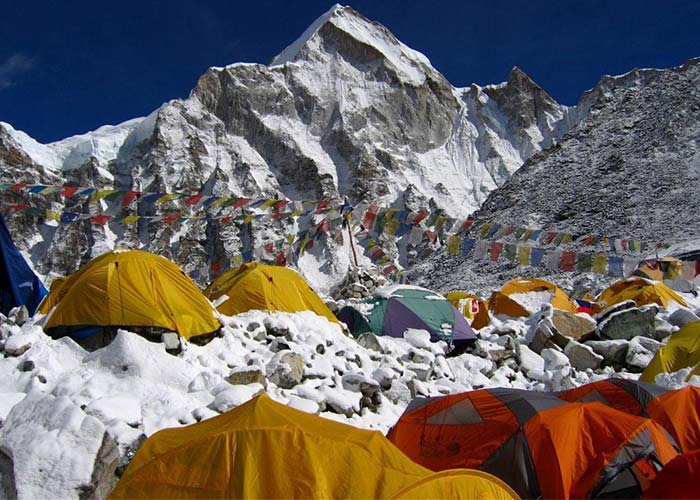
- Sun hat or scarf
- Light balaclava or warm fleece hat
- Suncreams(40+) and Lip Balms
- Cotton t-shirts and thermals
- Fleece jacket
- Waterproof jacket
- Down jacket
- Lightweight cotton pants (long)
- Waterproof pants
- Inner thermals
- Thin inner socks (3 pairs)
- Thick, warm wool hiking socks
- Comfortable hiking boots
- Shower sandals
- Gloves (Cotton and Waterproof)
Accessories
- Sleeping bag rated to -10°C +
- Trekking bag (Rucksack)
- Large plastic bags (for keeping items dry inside trek bag)
- Trekking poles (optional, recommended)
- Water bottle or camel bag
- Toiletries and Tissue Papers
First Aid Kits
- Personal Regular Medicines
- Blister Tape
Miscellaneous
- Medicines: We recommend you bring your regular medicines; we will provide a first aid kit from our side.
- Light-weighted Towel
- Swiss Knife
- Passport and extra passport photos
- Water Purifying Iodine Tablets, Drop or Sterilizer
Related Trips
You will also like …
- View Details
- Enquire Now
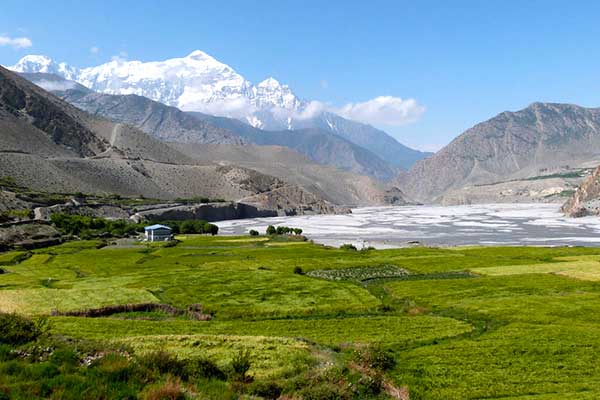
Arun Valley Trek
Lumba Sumba Pass
- Leisurely Plus
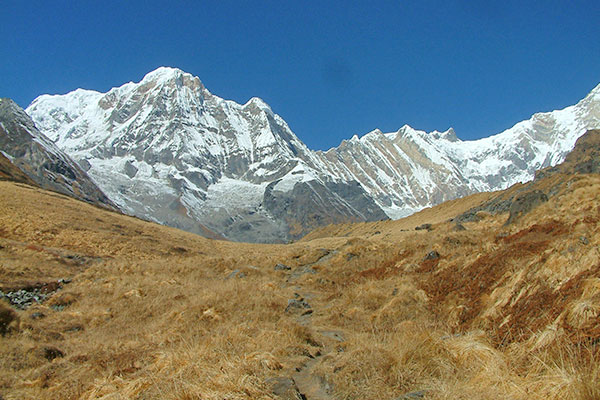
Annapurna Base Camp Trek
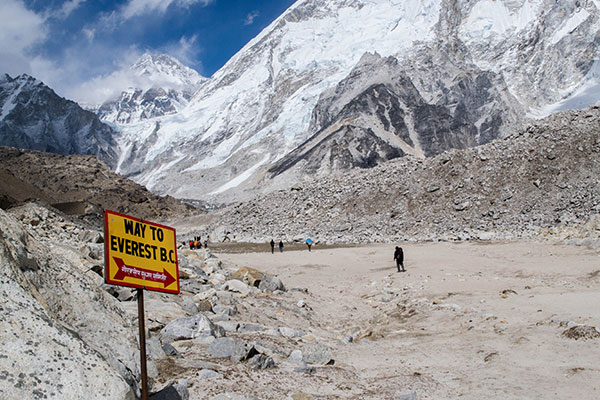
Everest Base Camp Trek
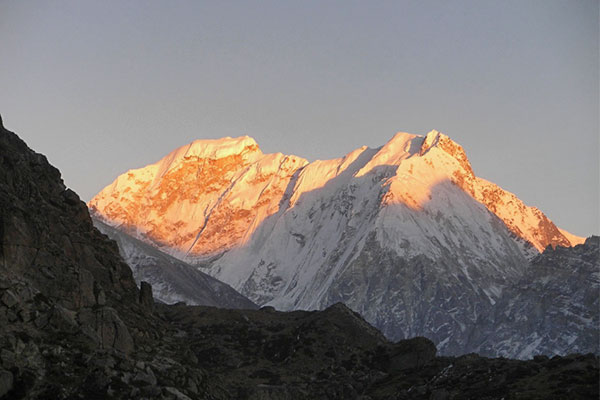
Kanchenjunga Trek
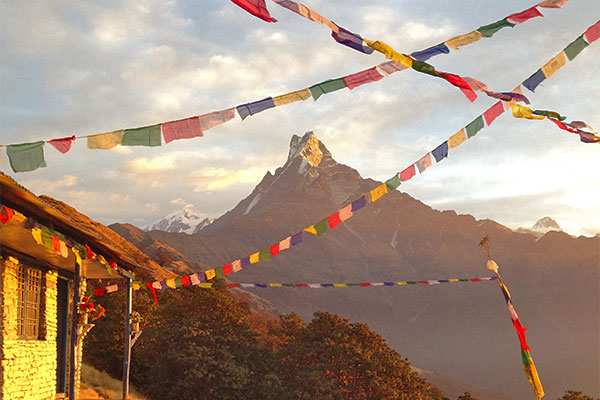
Mardi Himal Base Camp Trek
We are associated with.
SEND US A MESSAGE

IMAGES
VIDEO
COMMENTS
Trek to Upper Mustang can cost anywhere between USD 1500 and USD 4,000 per person. This includes agency fees, permits, wages of the guide and porter, transportation costs, accommodation, and three meals a day. As independent trekking is not allowed, you will have to book your trek with a licensed trekking agency.
The cost of food on the Everest Base Camp Trek in 2024. Our Everest Base Camp Trek Cost for food was NPR 55 000 ($414) thus NPR 5000 / $38 per day for 2 people = $19 per person per day. You should be able to eat more than enough if you budget for $8 per meal so $24 per day (3000 NPR). See our detailed article on Food on the Everest Base Camp Trek.
Cost of a porter-guide on a trek in Nepal: Porter-guide prices again vary by season. They can also be higher if coming from an agency. Porter-guides usually cost $25-28 per day. Cost of porter on a trek in Nepal: A trekking porter usually costs between $20-22 per day. It's worth noting that a porter cannot be used as a guide in Nepal. They can ...
Grand Total Everest Base Camp Trek Cost. For a full 14-day Everest Base Camp Trek, the overall cost of the trek can be anything from $1300-1700, excluding International flights. Our trip with Explore Himalaya cost us around $1200 per person plus the cost of food which averaged to be around $200 each and our tips to the porters and guides.
Guides and porters are very common in Nepal (though not always mandatory) and prices are quite competitive. In general a guide will cost around $25-30 per day and a porter will cost around $10-15 per day. A guide will help with logistics, information, and safety on your trek.
Up to 30 Days: $50. Up to 90 Days: $125. The Annapurna Circuit Trekking Permit consists of two separate permissions - the TIMS (Trekker's Information Management System) and ACAP (Annapurna Conservation Area Entry Permit). The TIMS is essential for doing many hikes in Nepal, whereas the ACAP is Annapurna specific.
Over 240 mountain peaks in Nepal breach the 6,000-meter mark (~20,000 feet) - the highest mountain in Africa, Mount Kilimanjaro, is 5,895 meters. Thirty-three mountain peaks in Nepal, with heights ranging from 5,650 meters to 6,500 meters, are classified as ' Nepal trekking peaks '. Although as many as 15 require some, if not a lot, of ...
Trekking in Nepal cost can vary depending on the season, with peak seasons like autumn and spring being more popular due to clear skies, comfortable temperatures, and mountain views. Off-seasons like the monsoon and winter can be more budget-friendly, with reduced accommodation prices and fewer tourists. Other factors influencing trekking costs ...
Trekking in Nepal ranges from approximately USD $30 to US$100 per day per person. This range is for the more inexpensive treks, where the expensive treks in the Everest region can cost $100-$200 per day per person. This ultimate guide to trekking in Nepal will tell you everything there is to know about trekking routes, seasons, safety, gear and ...
You could do an independent trek for ~$700 employing a local guide. check out our list of Nepal trekking companies recommendations. Tips: ~$200-$300. Misc (additional food, unplanned travel / hotels ect): $200. Total Costs: $2,500 - $5,000. Do I need a permit for the Annapurna Circuit?
The remote region, Far west Nepal trekking guides also charge more. Generally, low-end guides price starts at around USD 25 to USD 30 per day. A good guide's average cost is USD 35 to USD 40. A high-end guide will cost you about USD 50+ with additional language skills as per your preferences.
The cost of trekking in Nepal. The cost depends on the trek and how you want to do it (with a guide, porter, etc.). Some treks work out more expensive not only because accommodation and food cost more but because it's more expensive to get there (EBC Trek) or you need a special permit (Upper Mustang trek) or having a guide is compulsory (Manang trek).
Highest point - Annapurna Base Camp - 4147 m. Difficulty - moderate. Permits - TIMS card - NPR 2000/US$17 and Annapurna Sanctuary Permit - NPR 3000/US$25 pp. Cost per day - US$27 per person including permits and transportation. Guide - not compulsory, can be done independently, with a guide/a porter, or in a group. Accommodation ...
Down Jacket: $1 to $2 USD per day. Trekking Poles: $1 to $2 USD per day. Daypack: $1 to $2 USD per day. Overall, the cost of renting trekking gear for the entire duration of the Everest Base Camp Trek can range from $50 to $100 USD, depending on the rental period and the quality of the gear.
This 20-day itinerary guides you along the legendary Three Passes route—one of Nepal's most challenging and spectacular treks. Traverse a rugged landscape of steep passes, glaciers, and the world's highest freshwater lakes to reach the doorstep of Mount Everest. With downtime to rest and acclimatize.
The most convenient way to trek in Nepal within a budget is to buy a package tour. Here are some cost ranges for the most popular treks in Nepal: Everest Base Camp Trek 15 days - $1,100 per person. Annapurna Circuit Trek 20 days - $ 799 per person. Langtang Valley Trekking 11 days - $560 per person.
The Annapurna Circuit Trek is a true classic in Nepal. Find here your itinerary, cost, map, best season, and more tips. Sunday, April 21 2024 . Breaking News. ... Since 16 years, Nepal Trekking has been making its mark as a reputed travel guide and a destination management expert. Our specialties include 600+ Nepal trekking agencies, tours, air ...
The cost of hiring a guide and porter depends on the length of your trek and the services they provide. Typically, a guide might charge about USD 30 to USD 50 daily, and porter fees usually range from USD 25 to USD 40 daily. Engaging them through a reputable agency ensures their fair treatment and well-being.
Nepal Trekking Cost for The most popular Trekking Route in Nepal 1. Everest Base Camp Trekking - US Dollor 1299 2. Annapurna Bass Camp Trekking-US Dollor 799 3. Poon Hill Treeking -US Dollor 399 4. Langtang Trekking-US Dollor 699 5. Ma. Very Important Notice: Effectively from 1 April of 2023, All Trekkers must have Licensed Trekking Guide and ...
Day 2 : Drive from Pokhara to Sauli Bazar via Nayapul and trek to Ghandruk. Day 3 : Trek From Ghandruk To Chhomrong. Day 4 : Trek From Chhomrong To Bamboo. Day 5 : Trek From Bamboo To Deurali. Day 6 : Trek From Deurali To Annapurna Base Camp Via Machhapuchhre Base Camp. Day 7 : Trek From Annapurna Base Camp To Bamboo.
MyEverestTrip is a trusted company for trekking in Nepal, ... Without a guide and porter, per day, the Annapurna trek costs about $40 per person, and with a guide and porter, it costs $75 per person. The one-time cost for Permit, transportation, Visa, Insurance, etc., should be added.
Stay overnight in Sherson. Day 11 : Sherson to Makalu Base Camp (4,870m/15,978ft): 6-7 hours::: Today we shall trek to the base of the Makalu Peak or the Makalu Base Camp slowly and gradually. In a trail surrounded by glaciers and filled with rocks, we shall continue climbing to the higher altitudes.
The harder the route, the more will be the cost and it is obvious. Cost of guide and porter for some popular trekking routes: Annapurna Base Camp - In ABC, the cost of guide and porter is, $20-30 and $15-20 respectively. Everest Base Camp - Here porter-guide costs $20-25 per day and the porter gets $10-20 per day.
Manaslu Circuit Trek Cost. The permit cost to the restricted area of Manaslu can be quite expensive i.e. around $100 in peak season. Transportation charges to Maccha Khola can range from $10 to ...